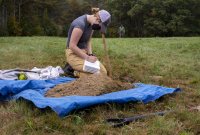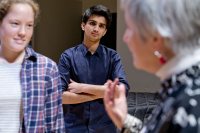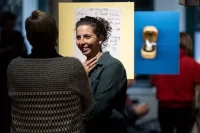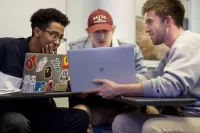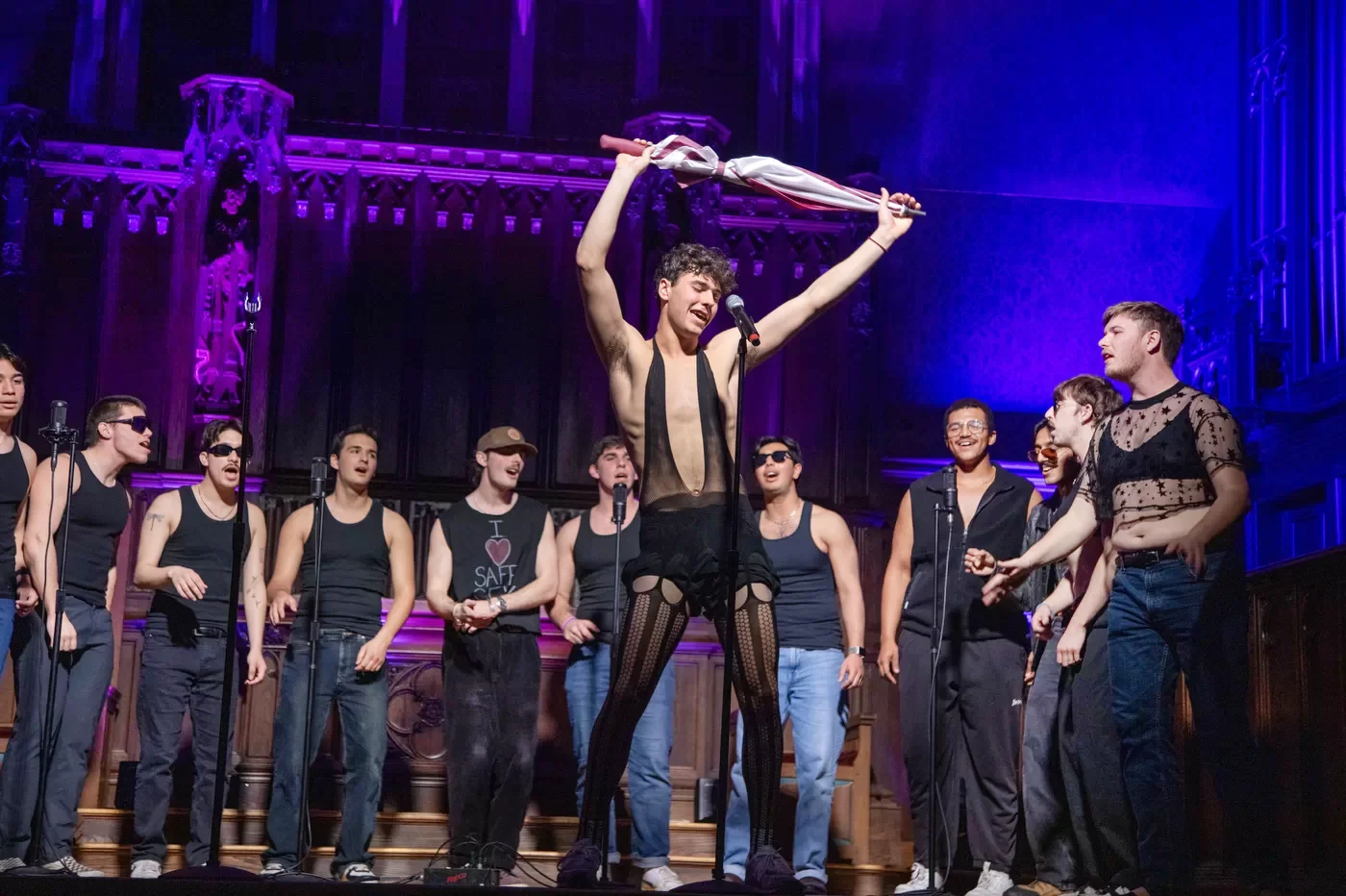
Chris Schiff is one of Ladd Library’s research librarians, and he’s been known to ask a big question to those seeking a job at the library: “What’s a library?”
It’s a big question for a big building — the second-largest academic building on campus — and to figure out the answer, we spent the day of March 12 in Ladd Library, from around 7 in the morning (well after building custodians Sherry Lessard and Carrie VanHerzeele had arrived) to the library’s 1 a.m. closing.
First, its physical presence: the Bates library is a large modernist structure that the late Phil Isaacson ’47, noted art critic and author, once admiringly called “a heluva good building.” It is named for George and Helen Ladd, among the college’s most generous donors of the 20th century.
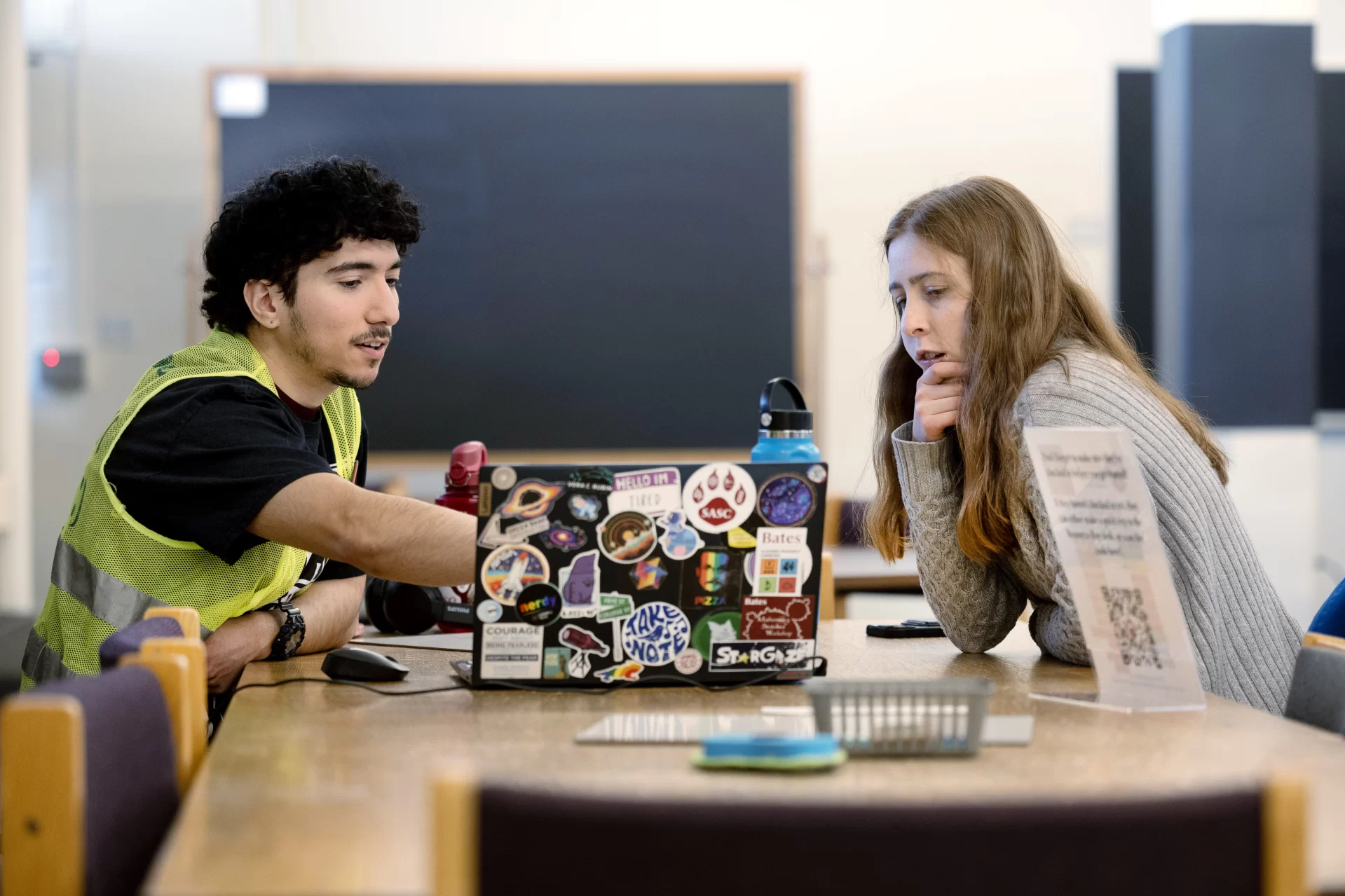
The Bates library has physical collections — books, periodicals, documents, audiovisual materials — plus access to digital and online titles, more than two million.
And it also has a collection of people who support every library service. There are around 20 librarians and professional staff, bolstered by a team of students, around 220, who staff everything from the circulation desk and IT Service Desk to the Peer Learning Commons, which occupies much of the ground floor.
Ladd Library — By the Numbers
- 2 million+ titles
- Available across physical and digital collections.
- 86,608 gross square feet
The second-largest academic building on campus behind Pettengill Hall. - 567,832 physical objects
Including books, periodicals, documents, and media. - 220-plus student workers
Supporting circulation, peer tutoring, and other services. - 20-plus professional staff
Librarians, archivists, tech specialists, and more.
And it’s huge, runner-up to Pettengill Hall as Bates’ biggest academic building. With 86,608 gross square feet, it is more than five times the size of its close neighbor and Bates’ prior library, Coram.
Yet thanks to an imaginative design developed more than a half-century ago by The Architects Collaborative, Ladd’s bulk doesn’t dwarf Coram.
The library’s famously pitched roof was the solution. It ensured that the front of the building remained in scale with Coram, while the large rear facade with its wide windows is compatible with the scale of Alumni Gym, the Gray Athletic Building, and Chase.
Some of the transfer of knowledge in Ladd library is silent, from screen to student, or from book to student. Some conversations are a bit louder, like those between seniors looking to find that last, crucial source to connect the dots in a senior thesis and one of the library’s experienced research librarians.
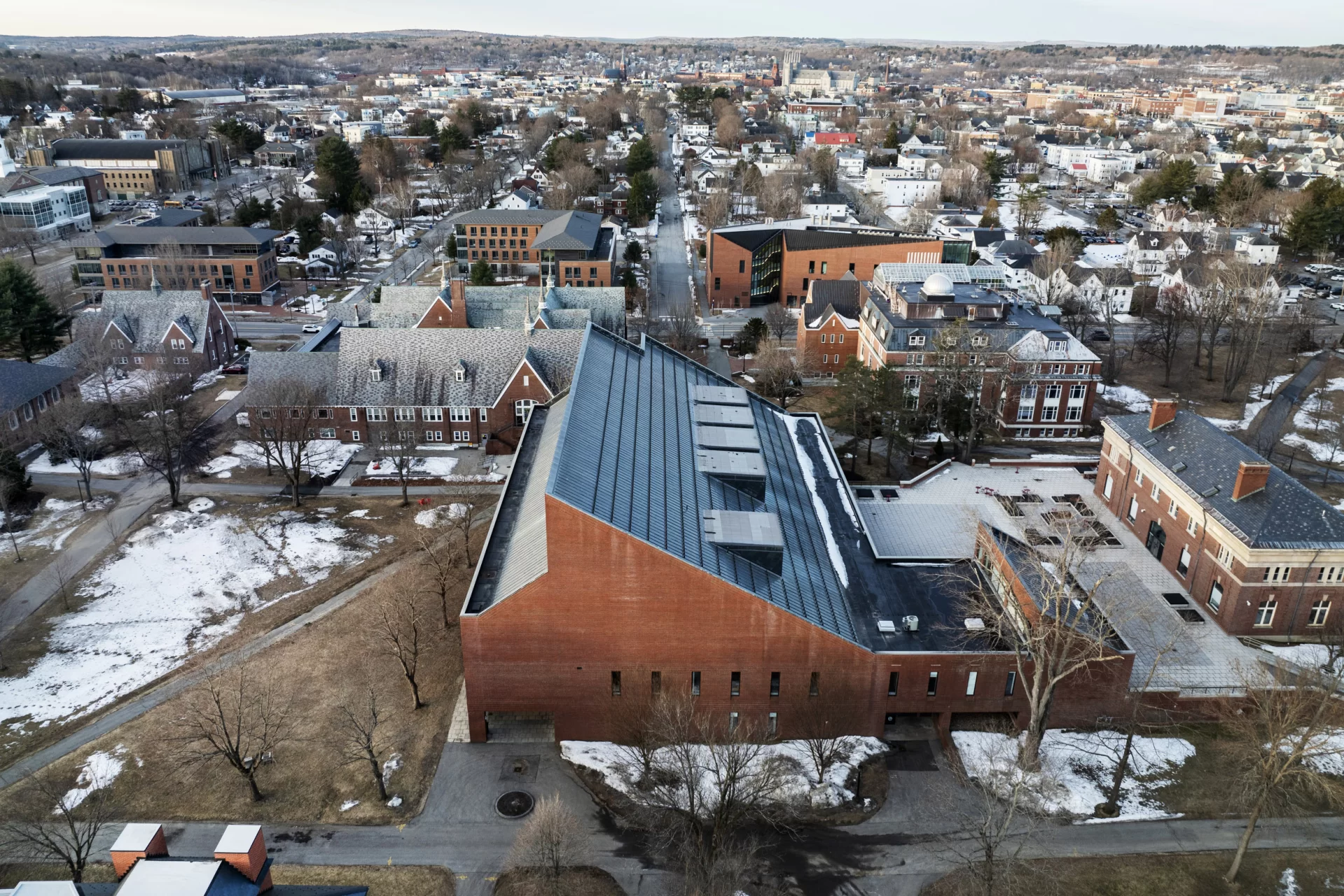
In the evening, some exchanges are downright loud, whether on the main floor, where students chat and gather around tables, or on the ground floor, where they work through challenges and difficulties with peer tutors in the Peer Learning Commons.
“We know that students learn best when they can interact with other people, when they’re in collaborative learning environments,” says Pat Schoknecht, the college librarian and vice president for information and library services since 2018.
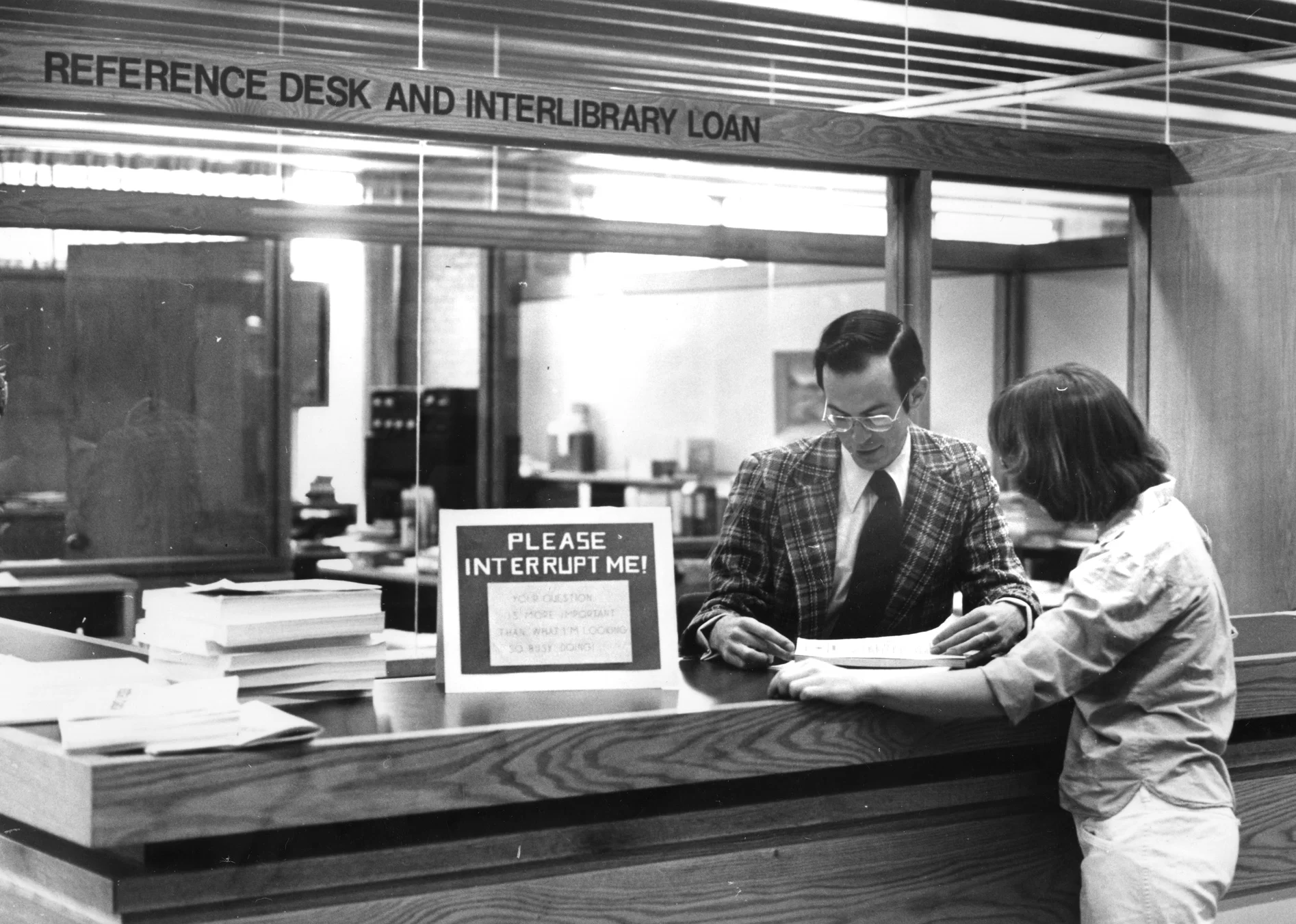
“And so the library needs to be a place where they can find the resources that they need, using that word very broadly — a place where they can either work alone because that’s what they want to do, or in pairs or small groups.”
Schoknecht recalls what someone once told her: “The library is the place where intentional learning should be happening.”
In that “let’s go!” spirit, Schoknecht and her team “want people to come in with that intentionality and we want to provide them with the services that help them accomplish whatever that intention is.”
What’s a library? Here’s what we found.
7:23 a.m.
“Sherry and Carrie at the Library,” Ladd’s custodial dream team of Sherry Lessard and Carrie VanHerzeele, the latter seen vacuuming the floor near the reading area on the first floor, arrive before dawn, at 5 and 4 a.m., respectively.

When they’re not busy dusting Ladd’s half a million books, Lessard and VanHerzeele are running around the building wiping down tables, cleaning windows, and collecting Commons dishes left behind by students. They find any number of misplaced and lost items throughout their shifts and, on two occasions, have found snakes in the library.
“Little baby snakes,” VanHerzeele says. “Nothing venomous or anything.”
A white board affixed to the door of their shared office, featuring stick-figure drawings of both women, serves as a message board between the custodial staff and library patrons.
“That’s their way of communicating with us when we’re not here,” VanHerzeele says. “Most of the time it’s just really nice notes.”
7:30 a.m.
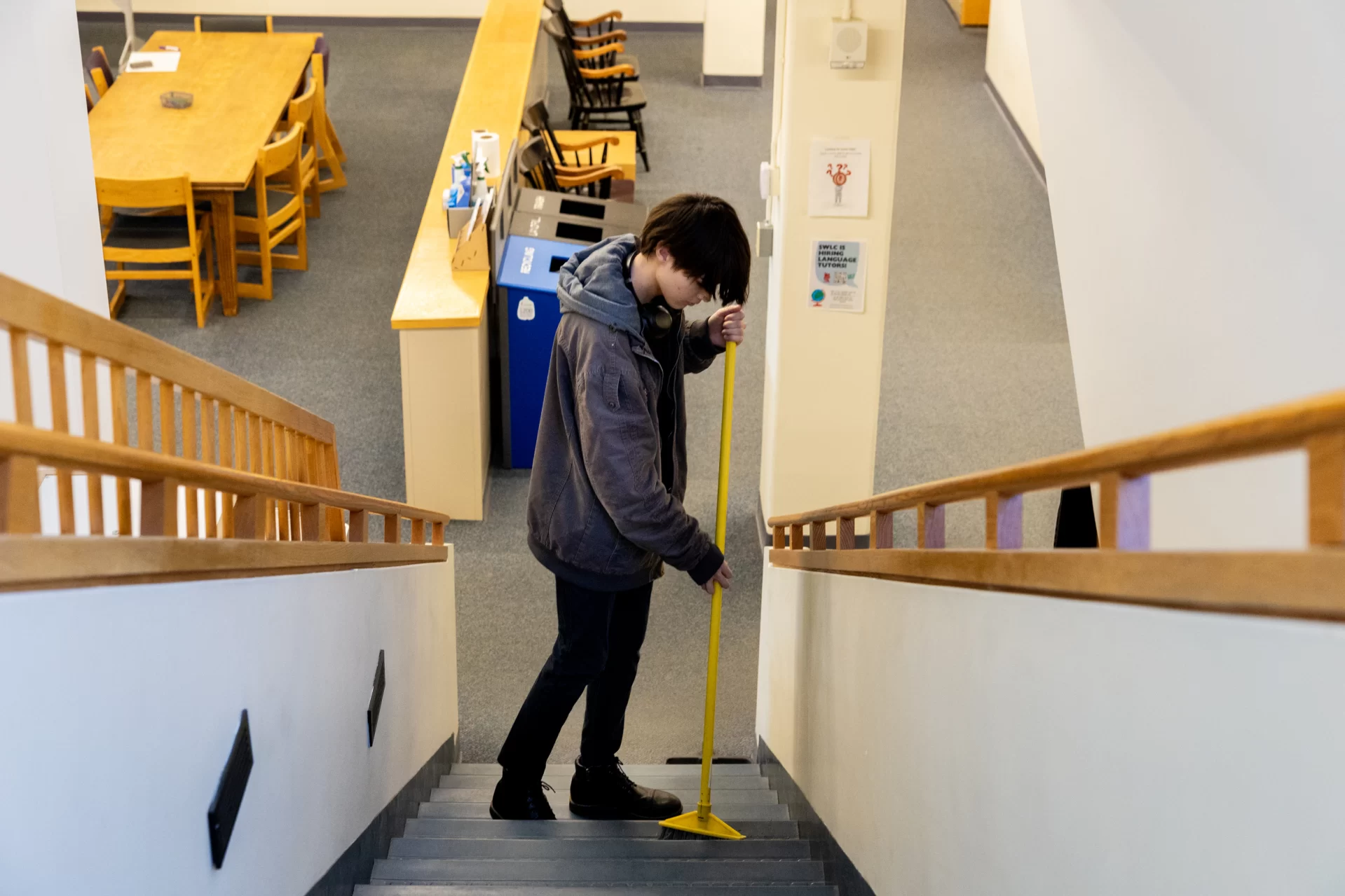
Fifteen minutes before the library opens to Bates students, the usually buzzing main floor of Ladd is completely silent. However, if you open the stairwell you’ll hear a steady scraping of grit on the concrete that tells you Emmon Blackburn ’26 of Nardin, Okla., has clocked in for work as a stair sweeper, a student job that’s been around for more than a century.
Blackburn is here five days a week at 7 a.m to sweep the three and a half staircases inside Ladd, indie rock playing in their headphones. “It’s a good job if you can bring yourself to get up early,” Blackburn says. “And in the winter it’s early enough I get to see the sunrise, which is nice.”
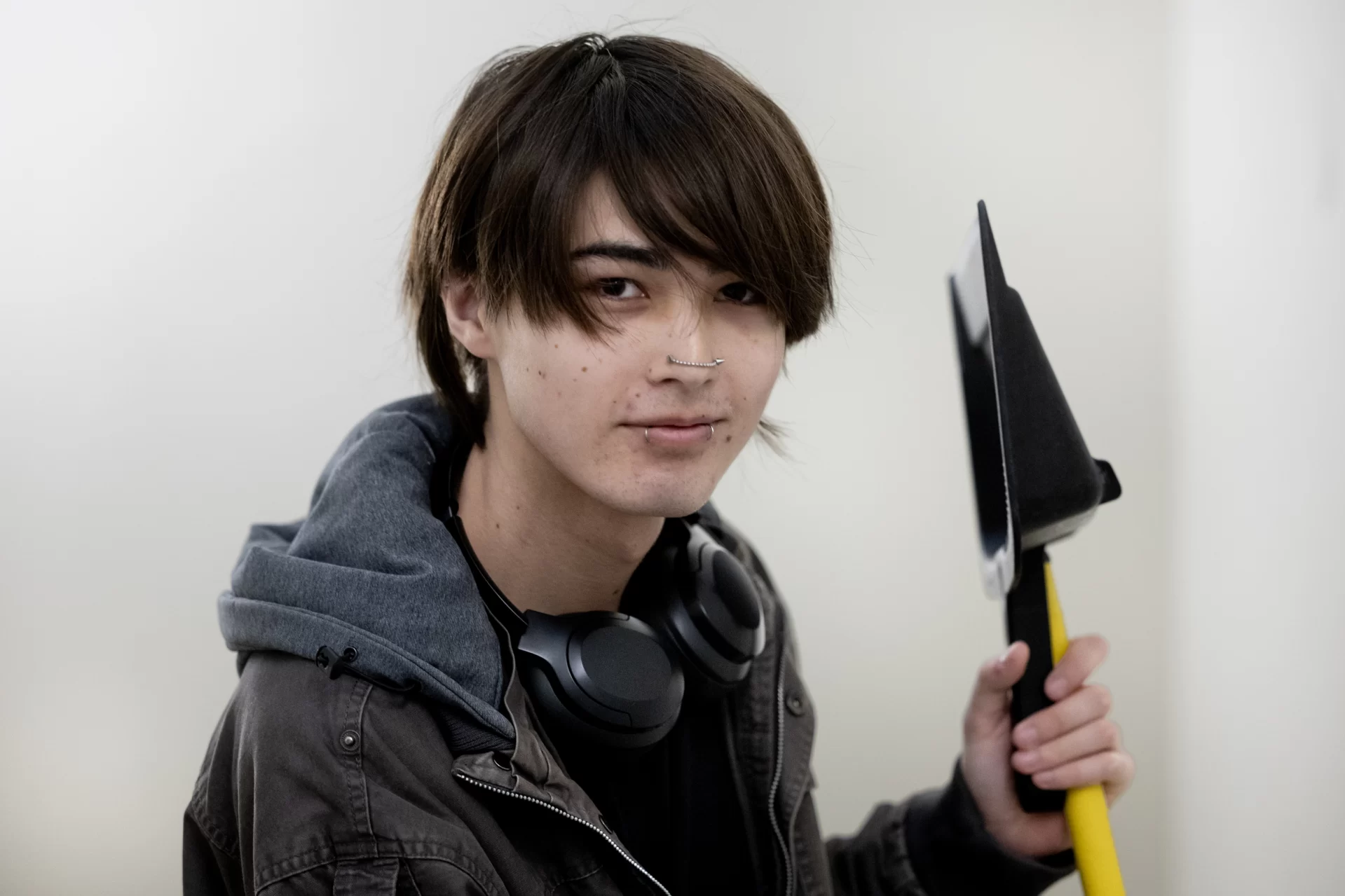
7:46 a.m.
When the library officially opens, Salem Aqraa ’27 of Southaven, Miss., is the first one in the door. He’s come straight from his early morning rowing practice, and will shortly begin his shift as an “IT Service Desk Assistant.”
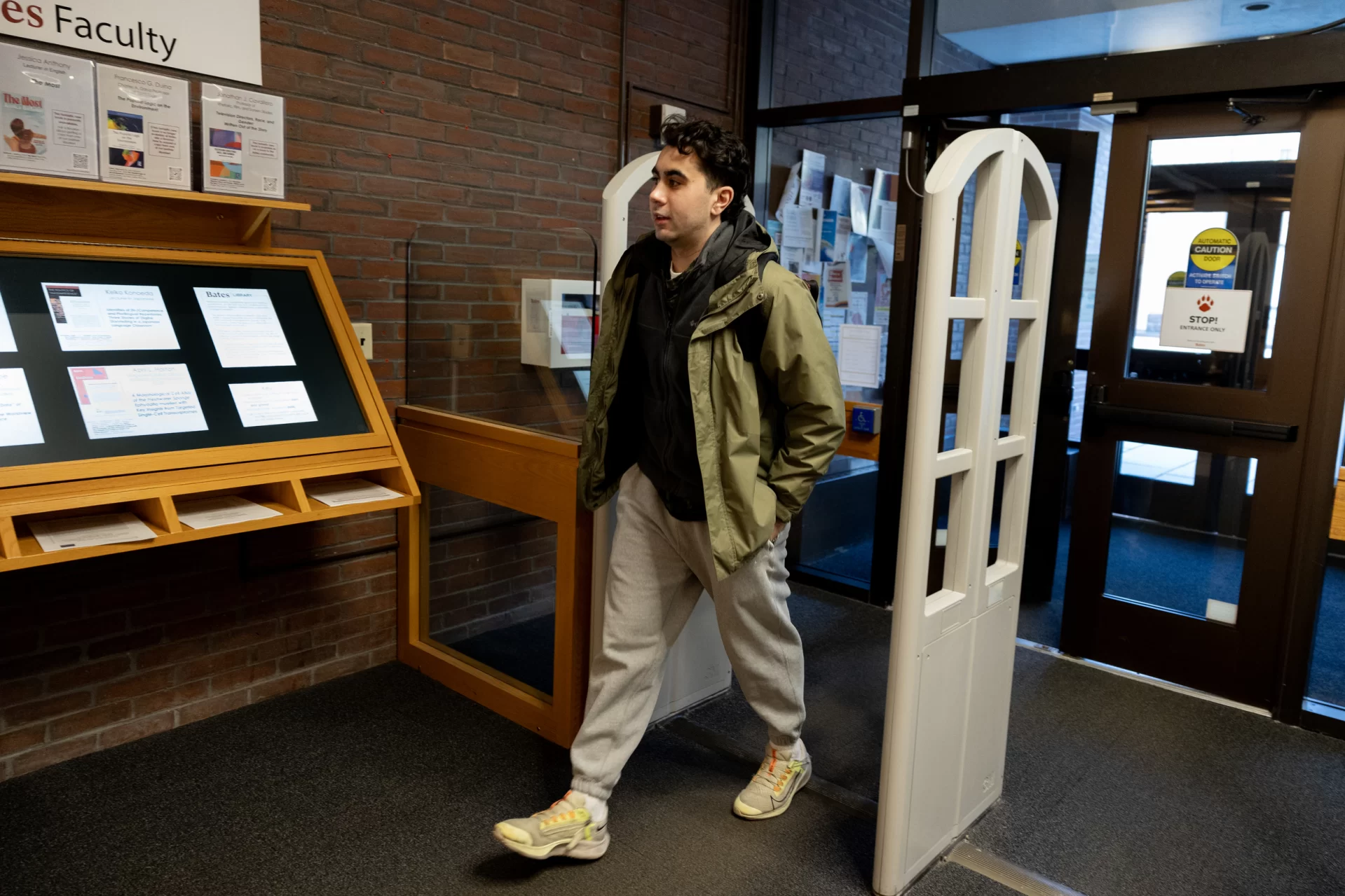
Working with professional staff at the service desk, he and other student workers offer quick-as-possible fixes for the wide range of technological problems that can beset a couple thousand computer users on a college campus. But, as he says, “mostly it’s printer troubles.”
Early in the morning, “barely anyone comes in, so I mostly study. During later shifts I like to talk to people though, especially professors who come in for help more than you would think.”
7:48 a.m.

Ilyas Bashir ’25 of Auburn, Maine, is the first person to sit down and study in Ladd today. He’s a Chinese and anthropology double major working on his thesis, and usually one of the first people in Ladd. His anthropology thesis looks at how immigrants navigate the healthcare system in Lewiston.
8:01 a.m.
Lee Desiderio, a member of the IT Service Desk team, raises the shades to begin the day. As an instructional support manager, he helps faculty, students, and staff get and stay up to speed on the rapidly changing technology they use.
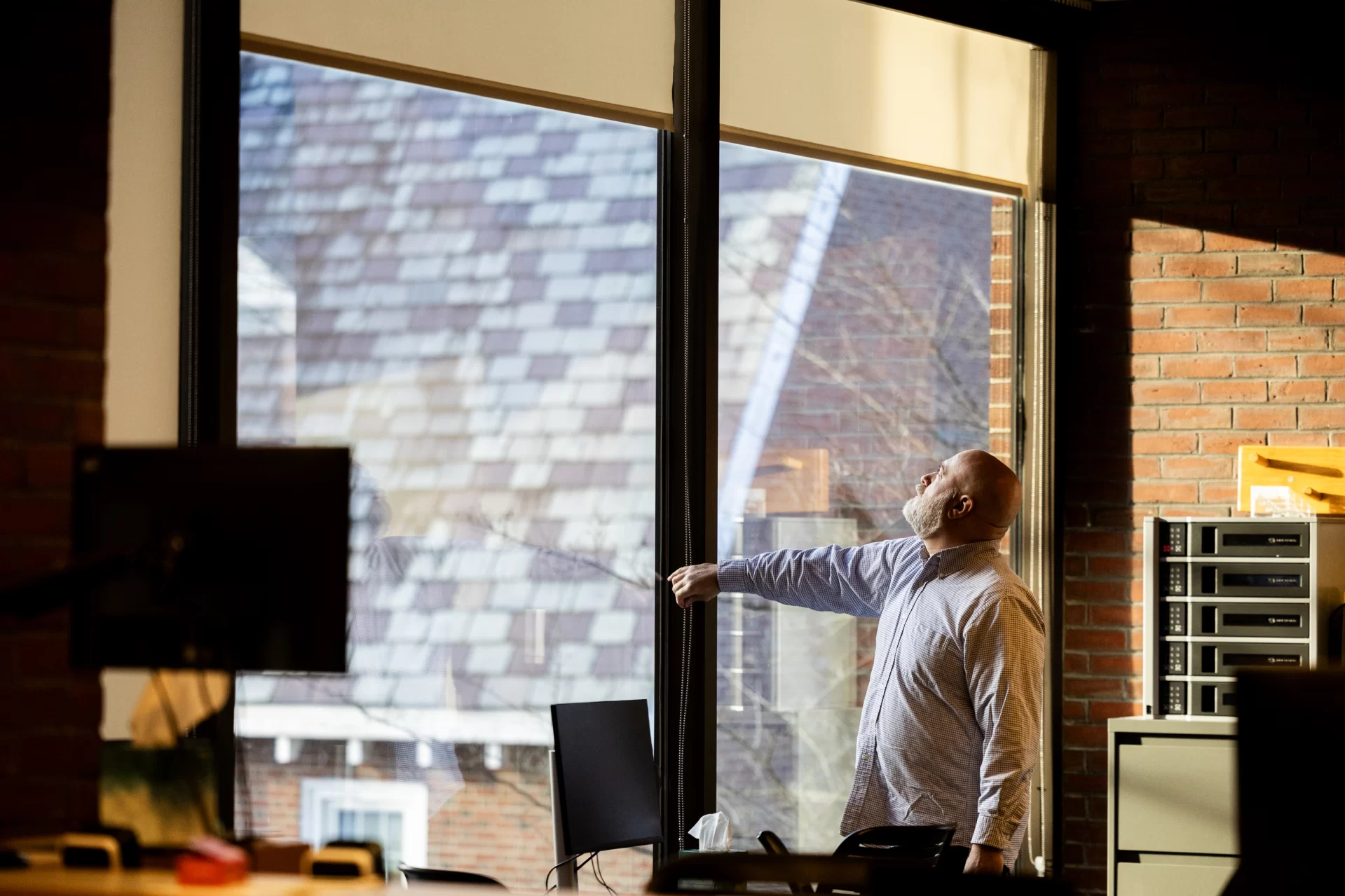
8:10 a.m.
Two juniors from Tuxedo Park, N.Y., Megan Donaghy ‘26 and Lili Missbrenner ‘26, begin their day early by meeting in Ladd. It’s their routine, to enjoy the quiet, the light, and each other’s company.
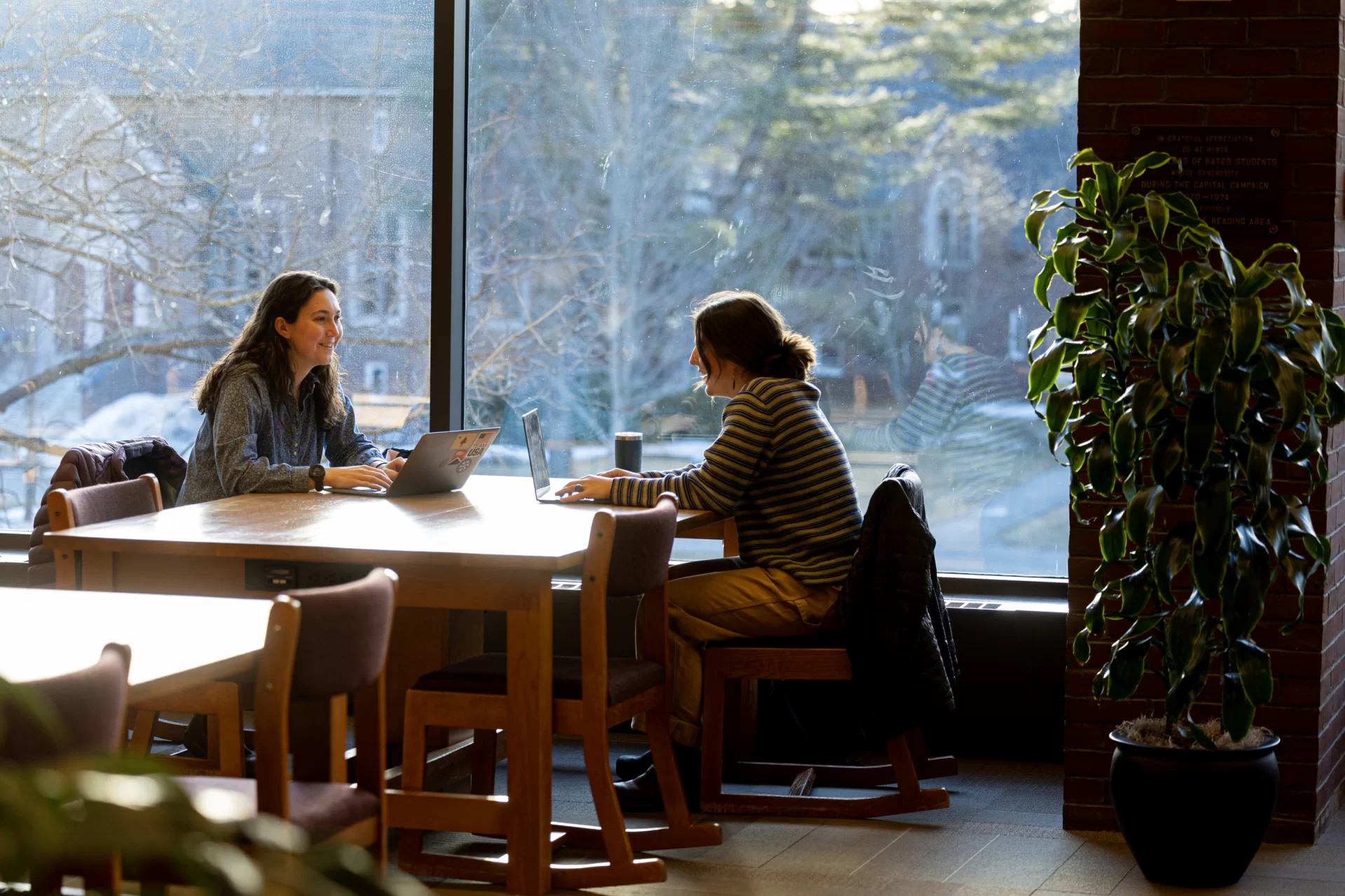
8:30 a.m.
The circulation desk is near the front door, which means that whomever is on duty becomes an unofficial greeter, or concierge, of Ladd Library.
This morning, it’s Sloan Phillips ’25 of Evergreen, Colo., who has worked all four years at the campus library.
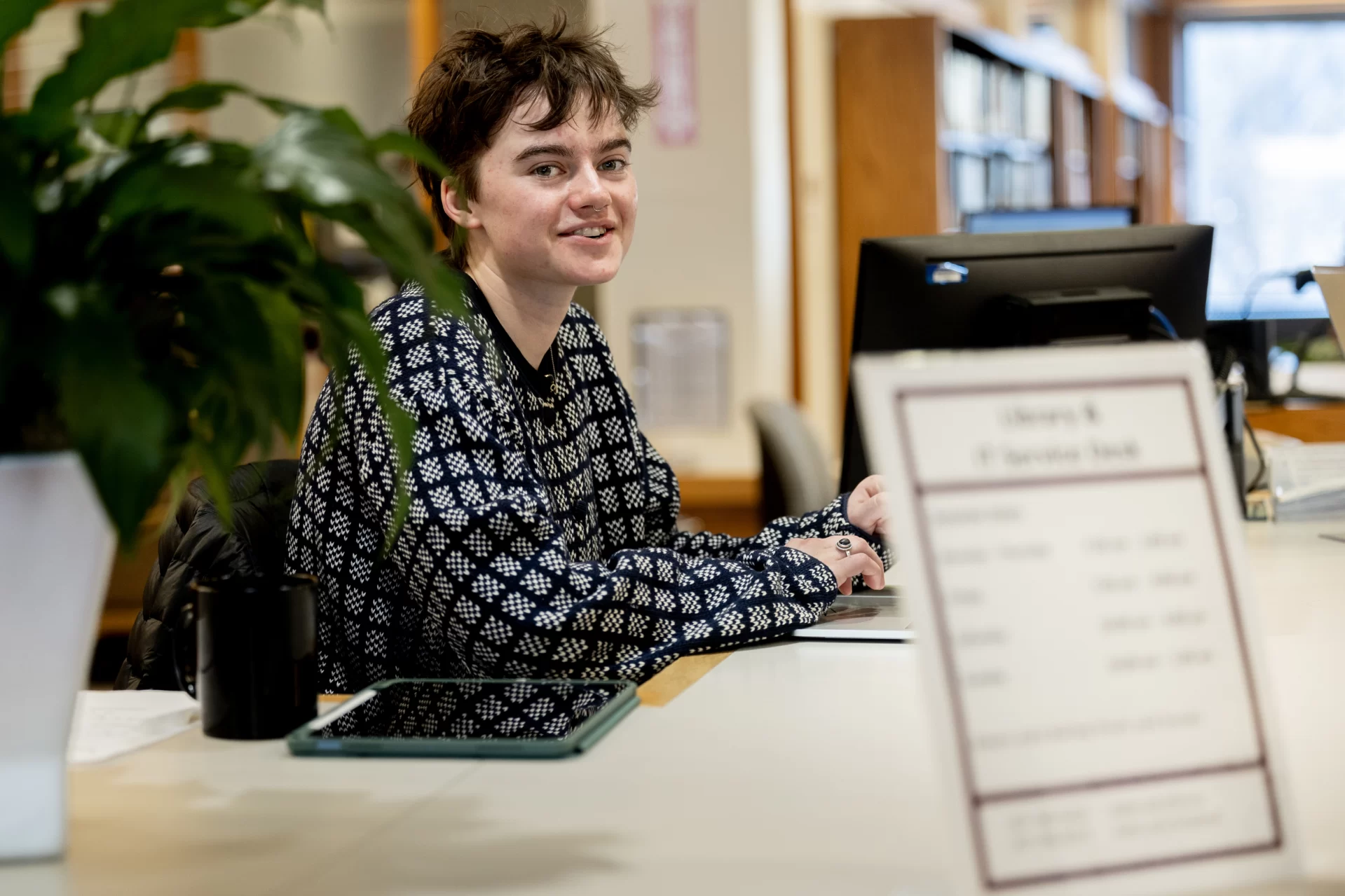
The greeter role, Phillips says, “is kind of nice, to be able to see who’s coming and going and chat with whoever comes in,” and to be able to triage computer questions, printer questions, or research questions.
“I like making small talk. Maybe making them feel a bit better, even if they have to talk with me because they’re waiting for their book. It’s still making a connection with another human.”
Reserve readings still have an emotional charge, says Phillips. “A sense of difference, they didn’t seek it out for themselves. They’re assigned to it. It’s a different dynamic.”
8:39 a.m.
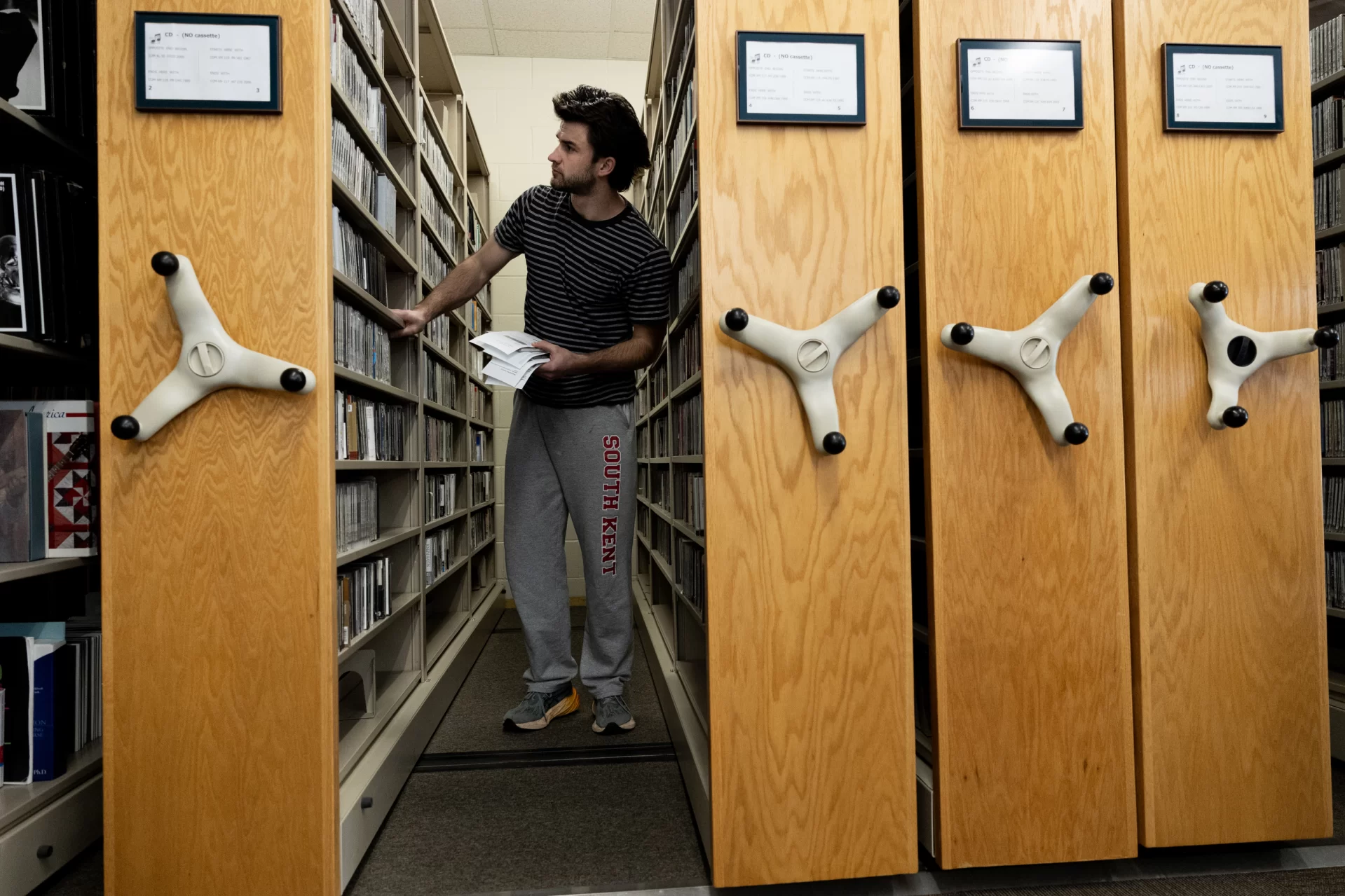
Simon Clarke ’25 of Redwood City, Calif., a student worker at the audio desk on Ladd’s ground floor, moves between the mobile shelves containing music and movies, pulling items reserved by students and faculty.
8:43 a.m.
Emily Colucci, a library assistant for access services, settles in for a day of work on Ladd’s ground floor in a sea of neatly-organized DVDs, CDs, vinyl records, and cassette tapes.

A classically trained guitarist and singer, Colucci works in Ladd’s audio/video area and is currently embarking on a project to digitize the library’s many cassette tapes, several of which contain obscure NPR recordings, broadcasts, and lectures that are only available at Bates and the Library of Congress.
The job nicely suits her love of music, as Colucci helps students and faculty check out records for both academic and personal use.
“Lately, I’ve been checking out vinyl to students who have a very vast range of musical interests, which I would suspect they get from their parents,” Colucci says.
9:03 a.m.
Among the stacks on the second floor, we find a familiar face reading the poetry of Jane Kenyon. It’s Professor Emeritus of History Dennis Grafflin, back on campus for one of his bi-weekly visits to Ladd.
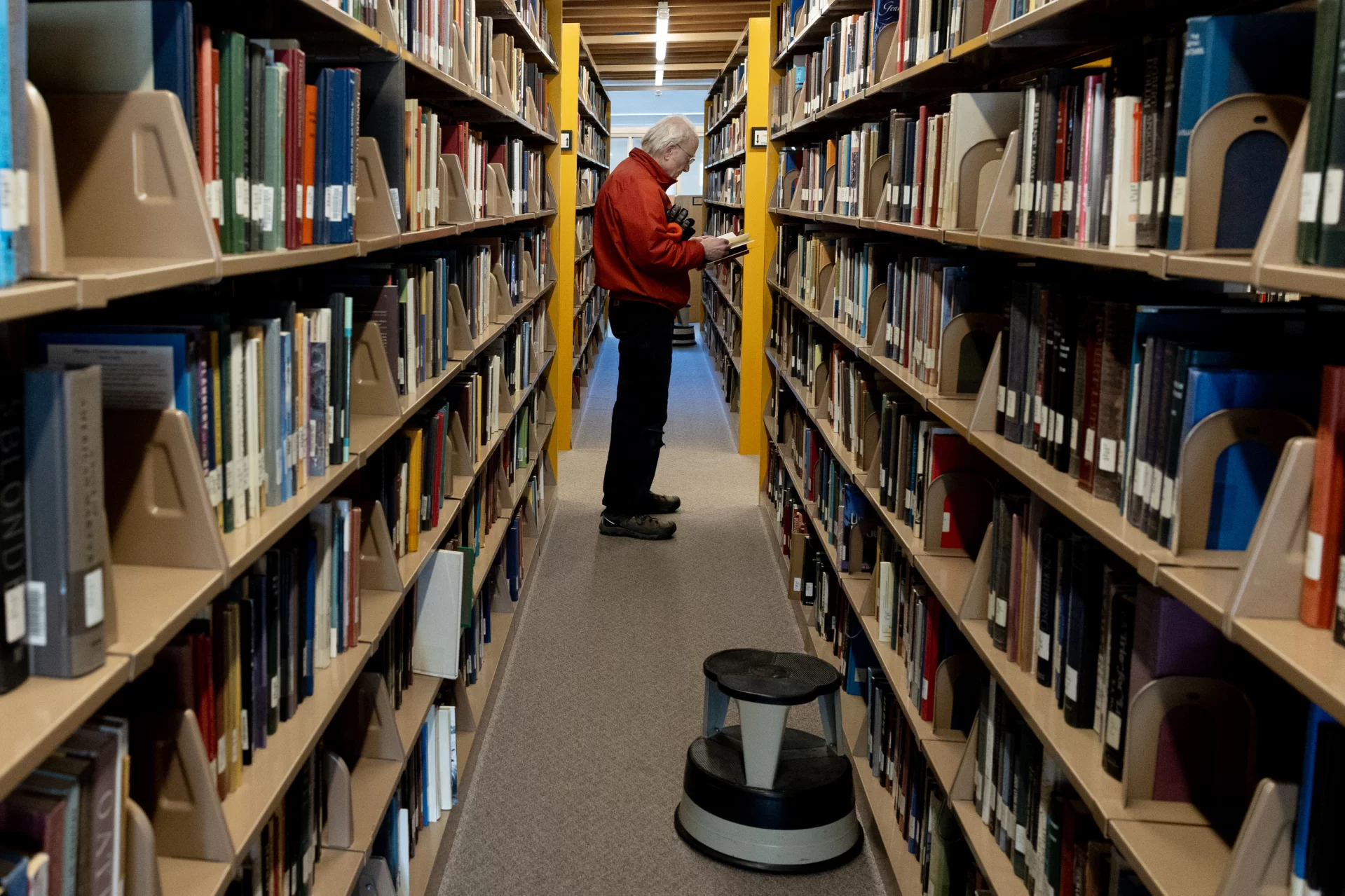
The library, he says, was his favorite building on campus during his 35-year career as a Bates professor and the spot he most often returns to in his retirement.
“The man who hired me, Ernie Muller, who was then chair of the history department all those years ago, was on the committee that designed this library, and it was one of his proudest memories of his time at Bates,” Grafflin says.
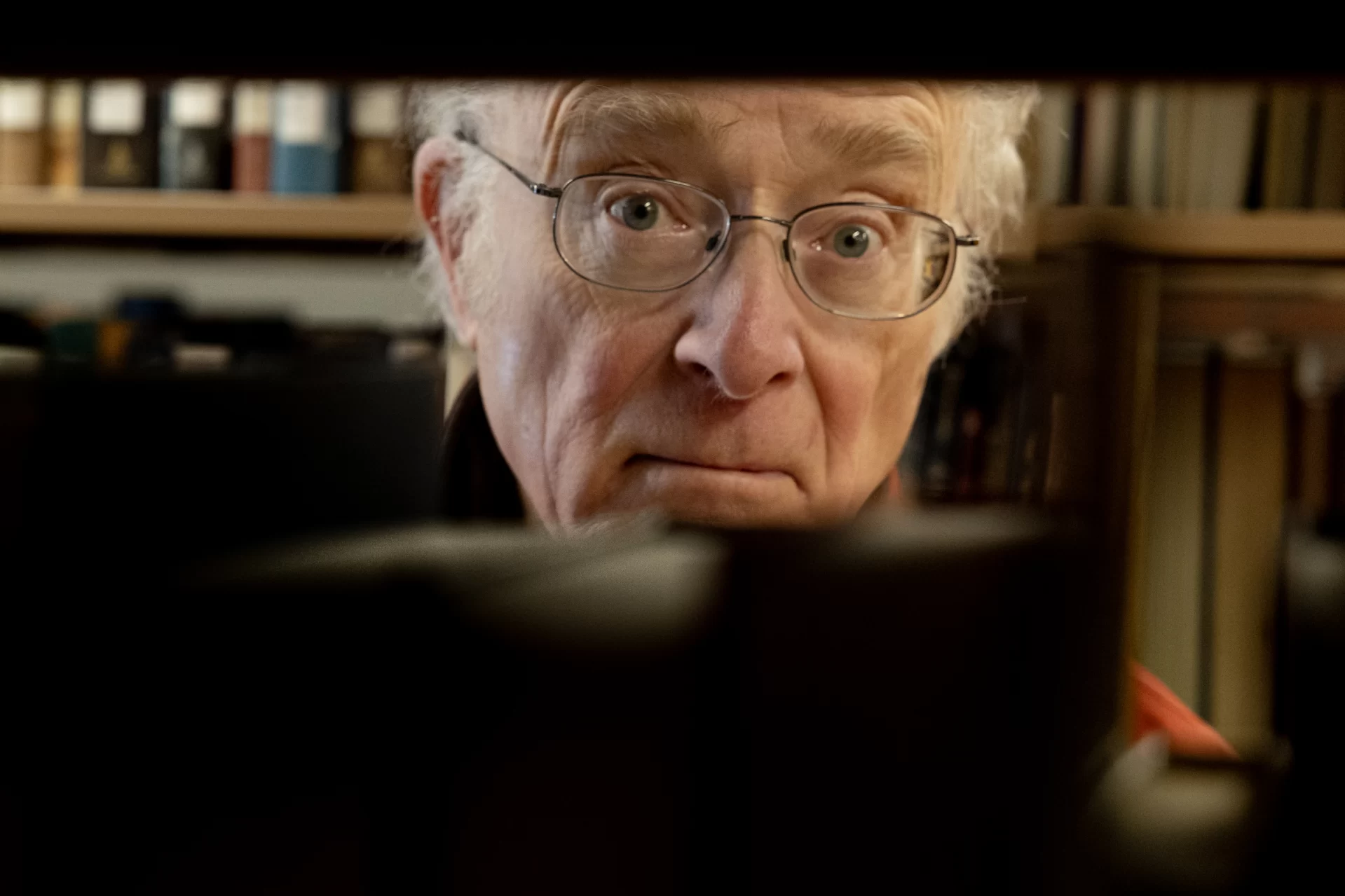
9:20 a.m.
Next up at the circulation desk is Ruslan Peredelskyi ’25 of Kyiv, Ukraine. A full-service operation, students can check out and return books or items like scissors, light-therapy lamps, and more. Today, he’s also the keeper of a precious lost phone, whose owner comes by to retrieve the missing cell with heaps of thanks to Peredelskyi.
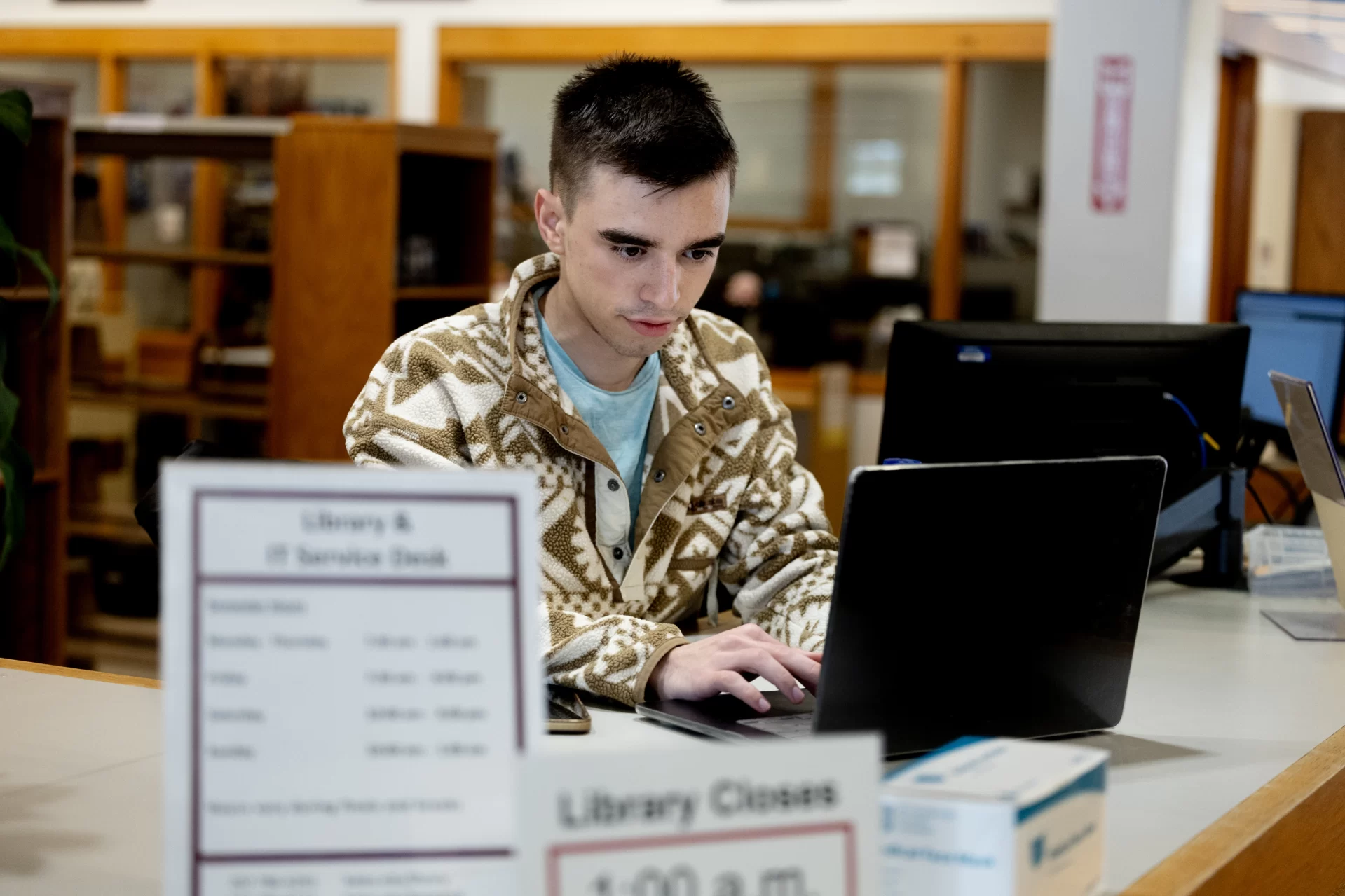
While handling books, Peredelskyi gets a front-row view of what faculty and students are working on.
“They tell you what caught their eye and why they need it, and they tell you about their projects, and it’s really exciting,” Peredelskyi says.
When circulation traffic dies down, Peredelskyi, perched behind the desk near the library’s entrance, works on his politics senior thesis and greets students and friends as they filter into Ladd.
“I get to say ‘Hi’ to every single person that enters the library,” Peredelskyi says.
9:36 a.m.
Bates has had only 10 college librarians. The list starts with Horace Cheney, the son of Oren Cheney, founder of the college, who served in the position when was 19 years old.
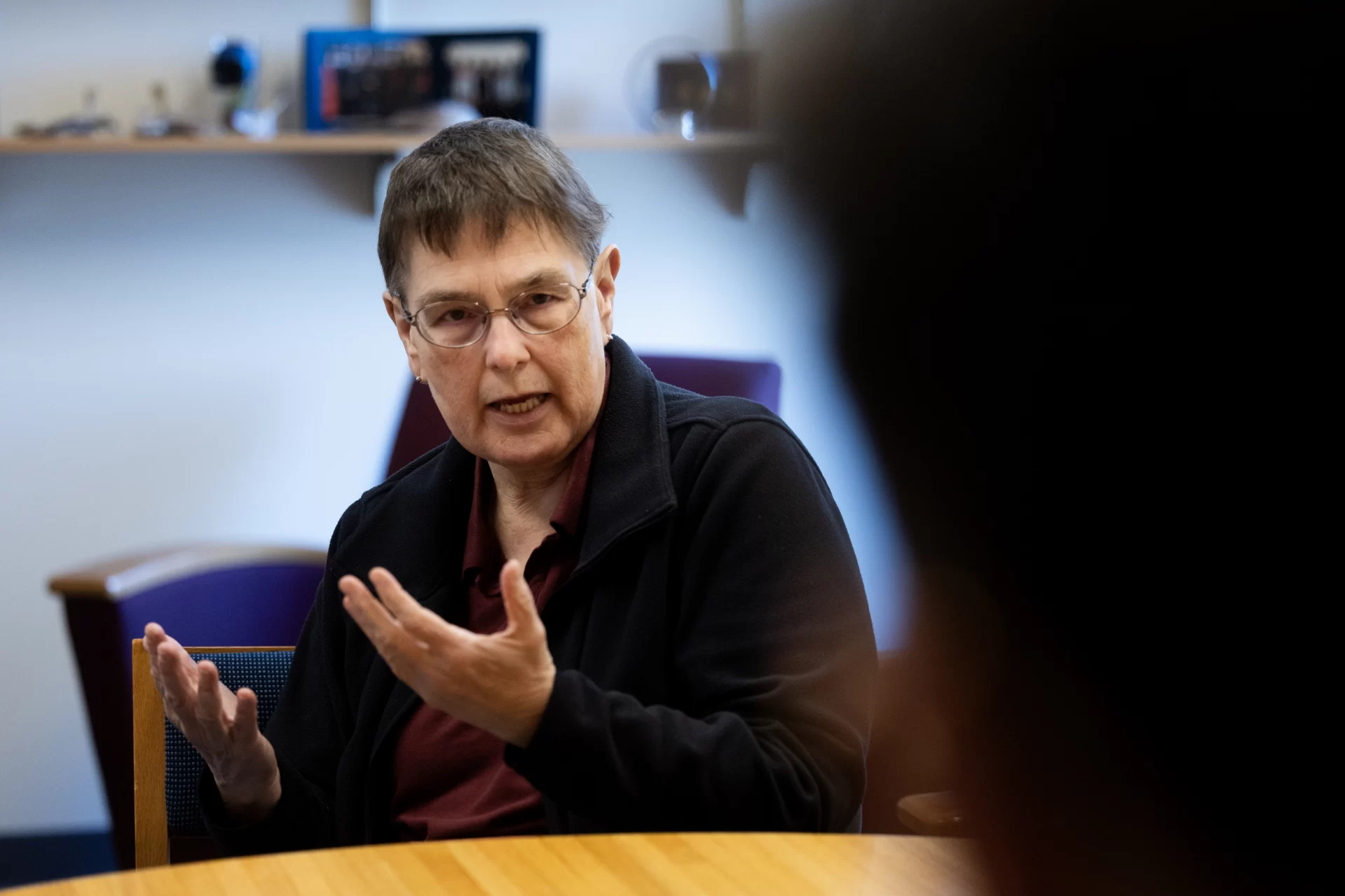
The 10th arrived in 2018, when Pat Schoknecht was appointed college librarian and vice president for information and library services. Here, she meets with Ben Peck, who is the associate college librarian for research services.
Schoknecht’s title reflects the fact that at Bates, the library and IT are joined. Two librarians before her, Gene Wiemers did the work to intertwine the two, making Bates a national leader in that area. In the words of Professor of Sociology Emeritus Sawyer Sylvester, Weimers did more than join the two areas; he “improved each by that marriage.”
9:41 a.m.
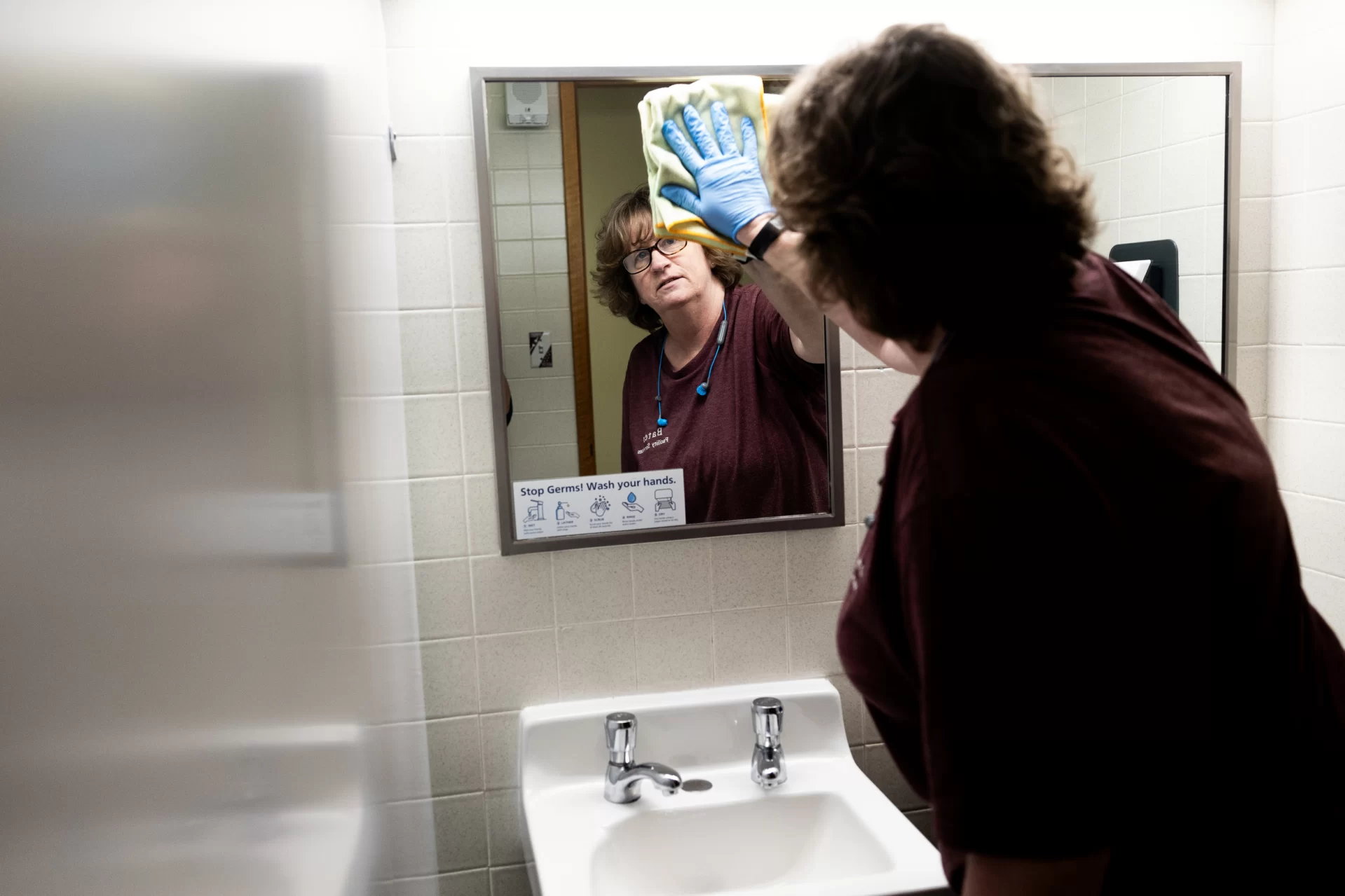
Custodian Sherry Lessard shines a bathroom mirror. Lessard and VanHerzeele keep Ladd in great shape for the hundreds of students, faculty, and staff who mill about in the building each day. There are quick daily tasks, like shining a mirror, and ongoing projects, such as dusting Ladd’s half a million books.
9:57 a.m.
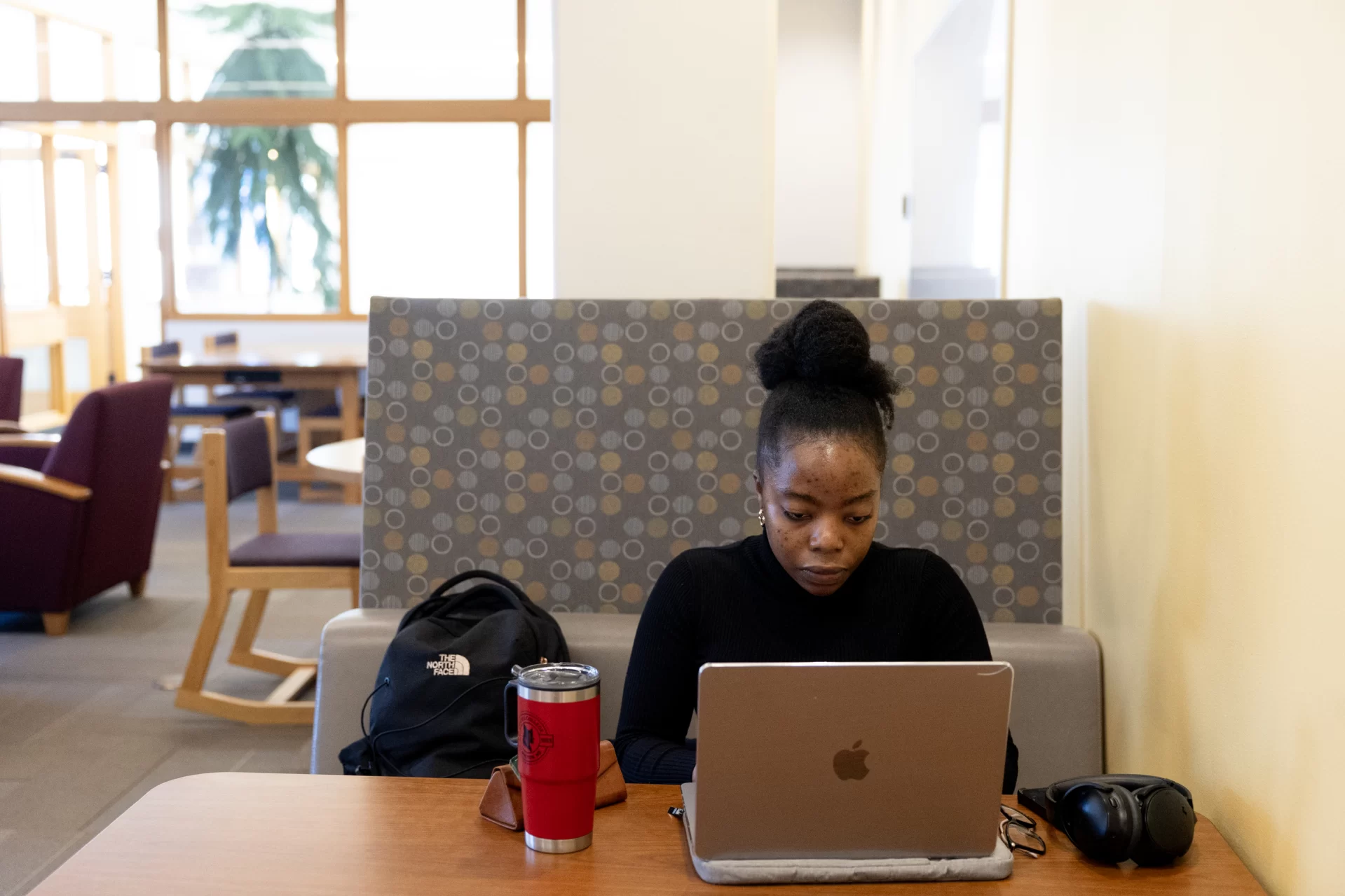
Mariana Kaluba ’25 a physics major from Lusaka, Zambia, finds that the friendly and social environment of the library helps her get work done.
10:09 a.m.
In the back of the administrative offices on Ladd’s first floor, Jenn Michel is in book doctor mode.
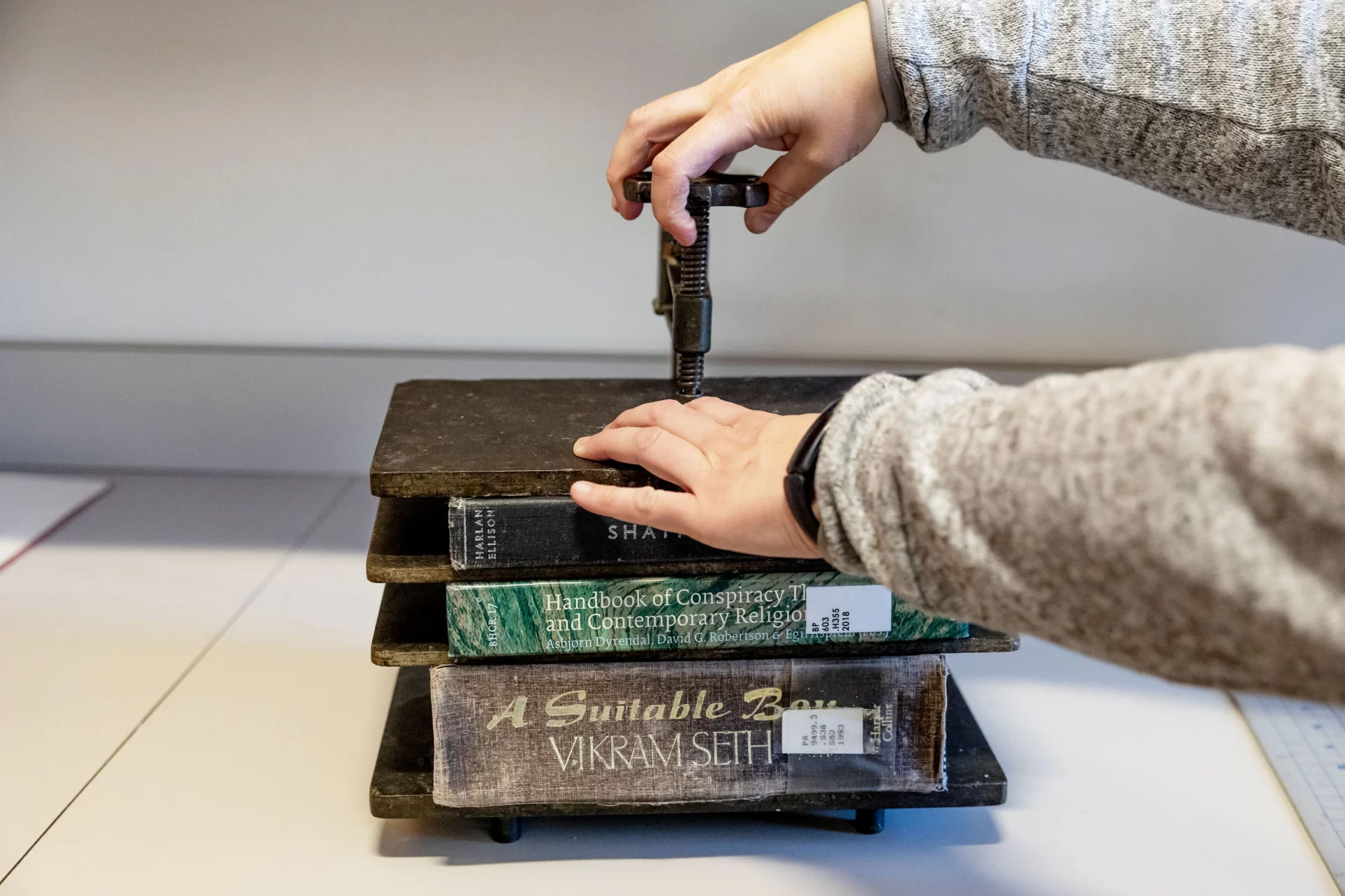
As the library’s acquisitions and preservation librarian, she is responsible for book conservation — i.e., repair — including remedying loose or detached spines, often using a special pH-neutral adhesive during repairs.
“We don’t want acidic materials used at any time during any of the conservation work,” Michel says. “That would deteriorate the paper products faster, and we want to preserve things for as long as we can.”
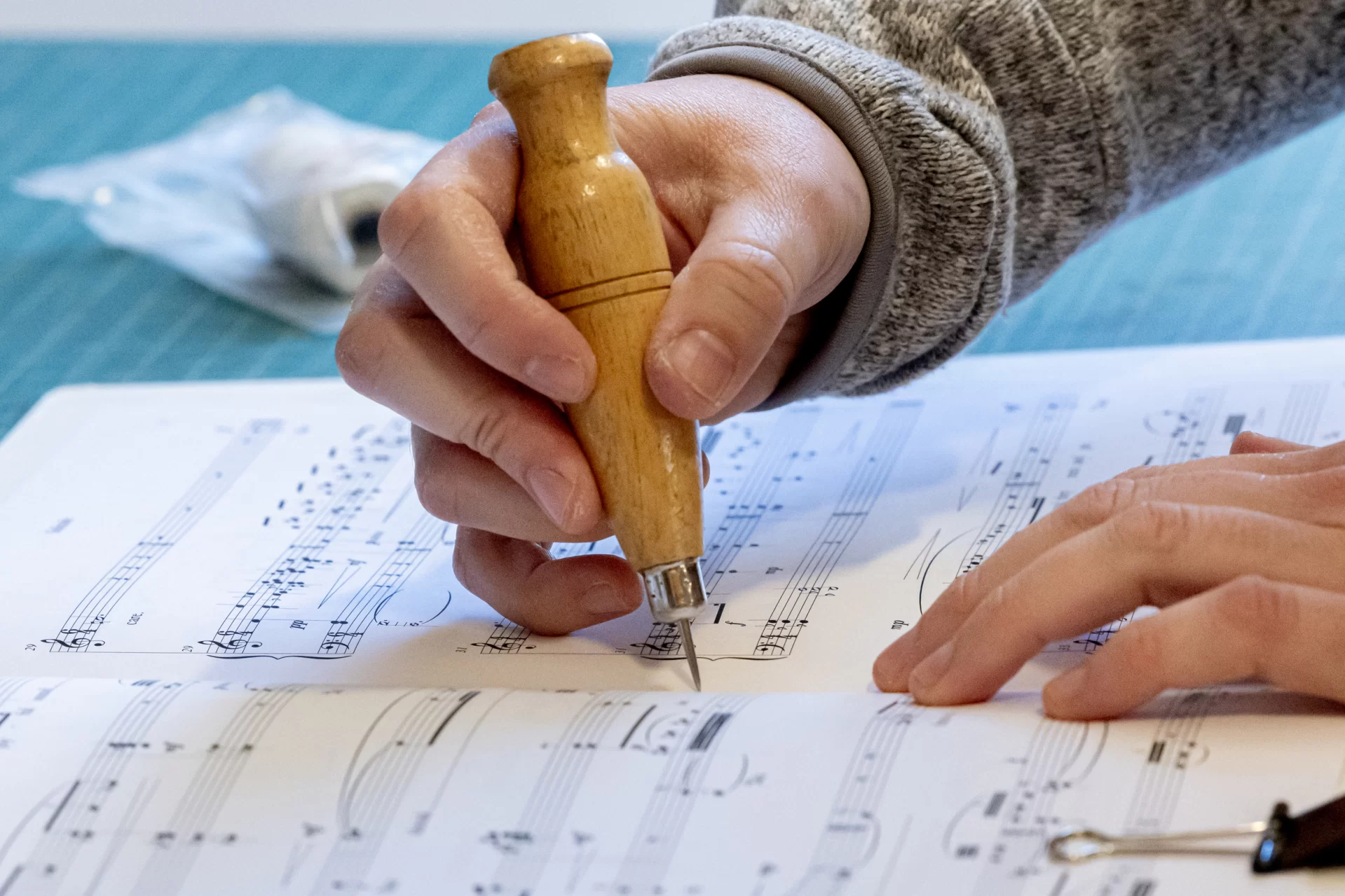
Once the glue is applied, Michel places the book in a hand-operated bookbinding press. With its manual crank that Michel rotates down to hold books in place, the press looks like something out of a pre-Industrial Revolution period film.
In today’s pile for repairs is a particularly charming copy of Jane Eyre, with an illustrated front cover and “Je t’aime” handwritten on the inside.
10:20 a.m.
Stinky books, be gone! On Ladd’s ground floor, kitty litter and cedar branches make up the secret sauce for removing odors from books.
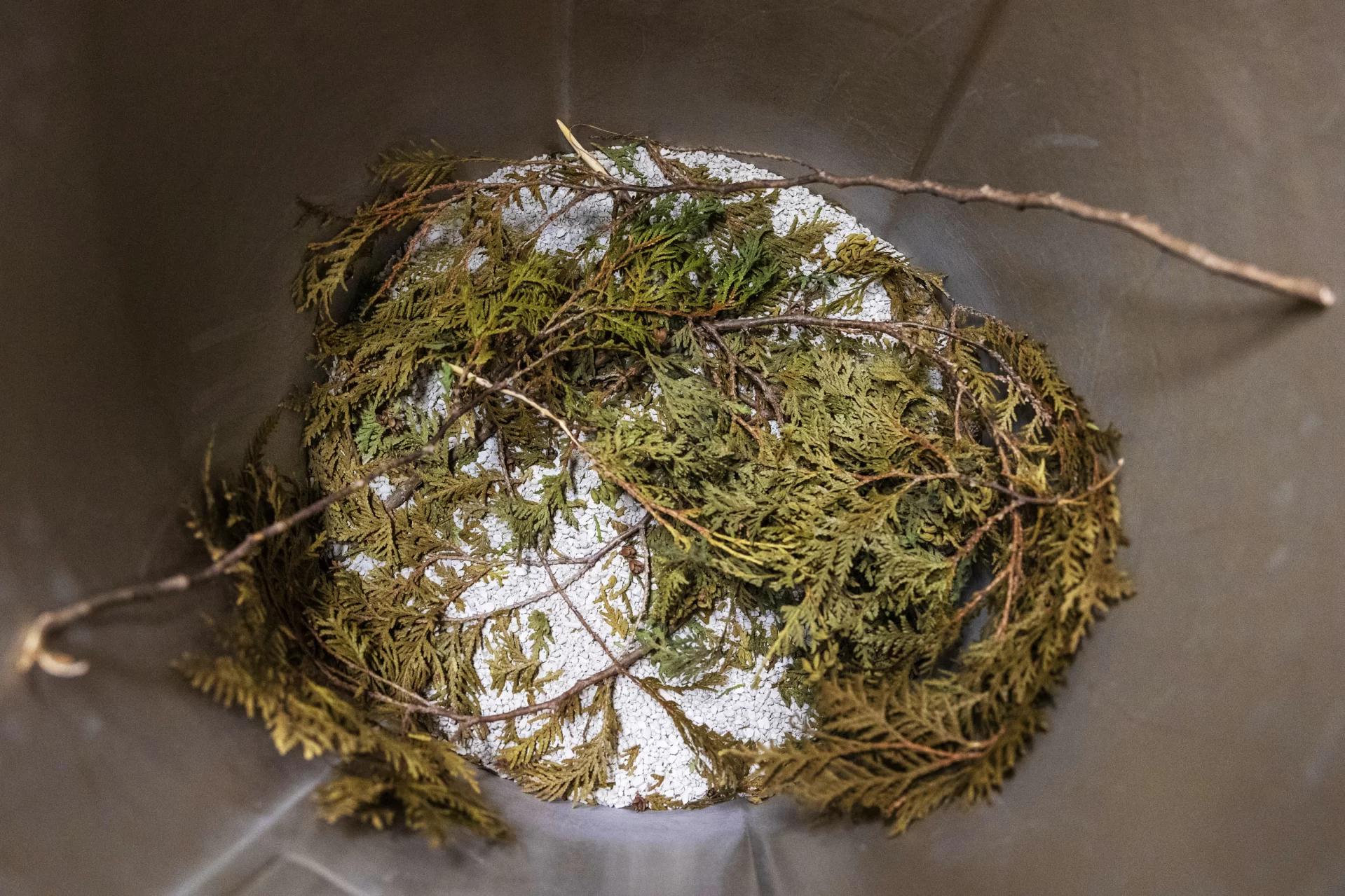
These ingredients rest at the bottom of a large trash can, just below a small laundry hamper fitted within the can. Odorous books sent to the can sit atop the hamper for a couple of weeks, until their smells are absorbed by the litter and branches.
While kitty litter is a common tool for removing odors, the cedar branches represent a uniquely Bates technique. Former library assistant Jane Boyle had the idea to use cedar because of its strong, pleasant smell, and the branches in Ladd are still the very ones taken from Boyle’s backyard.
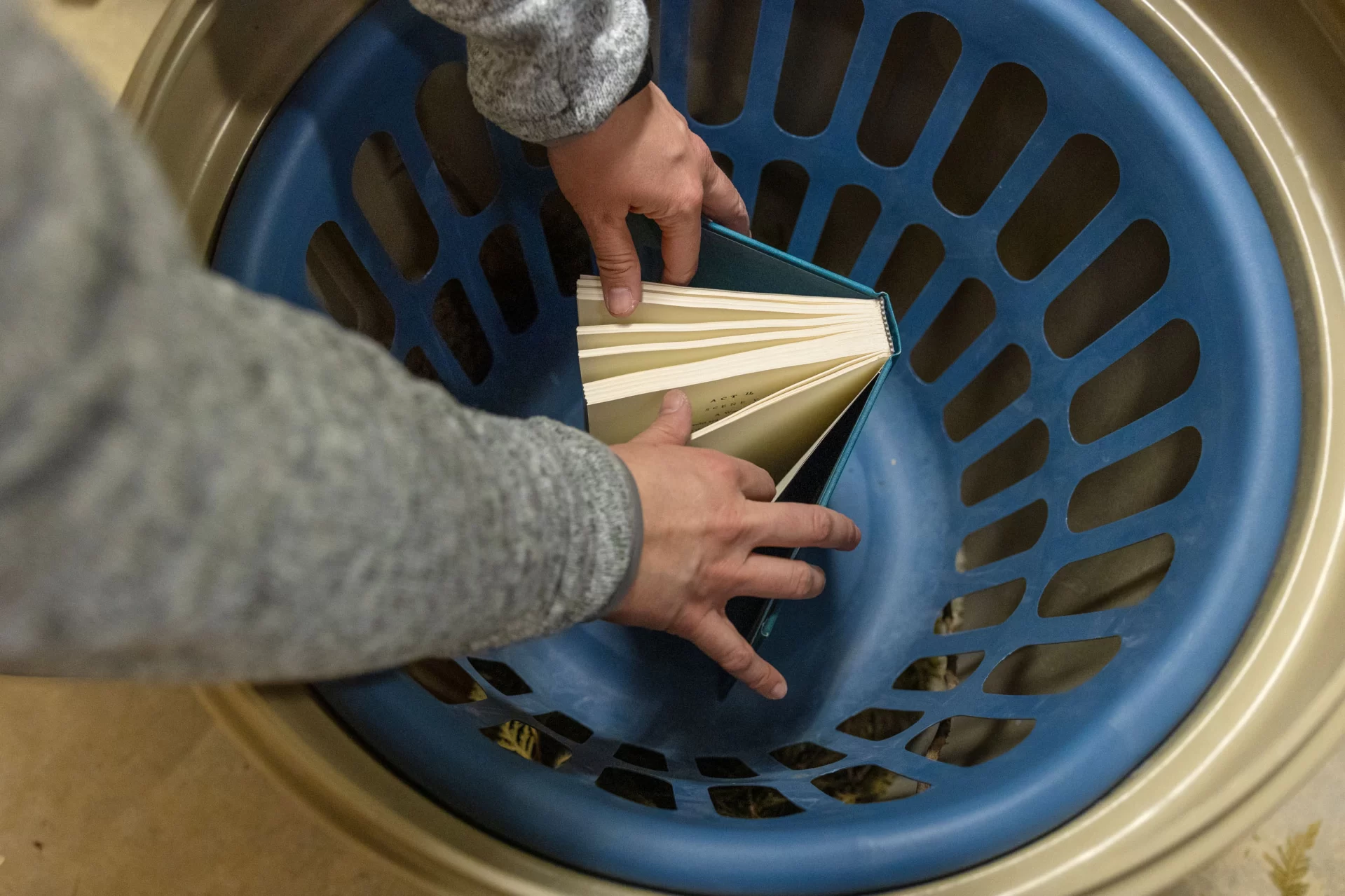
9:52 a.m.
Through the window of Instruction Room 128 on the first floor, near the printers, Christine Murray, who is the library’s social sciences librarian, is speaking to students in an anthropology course.
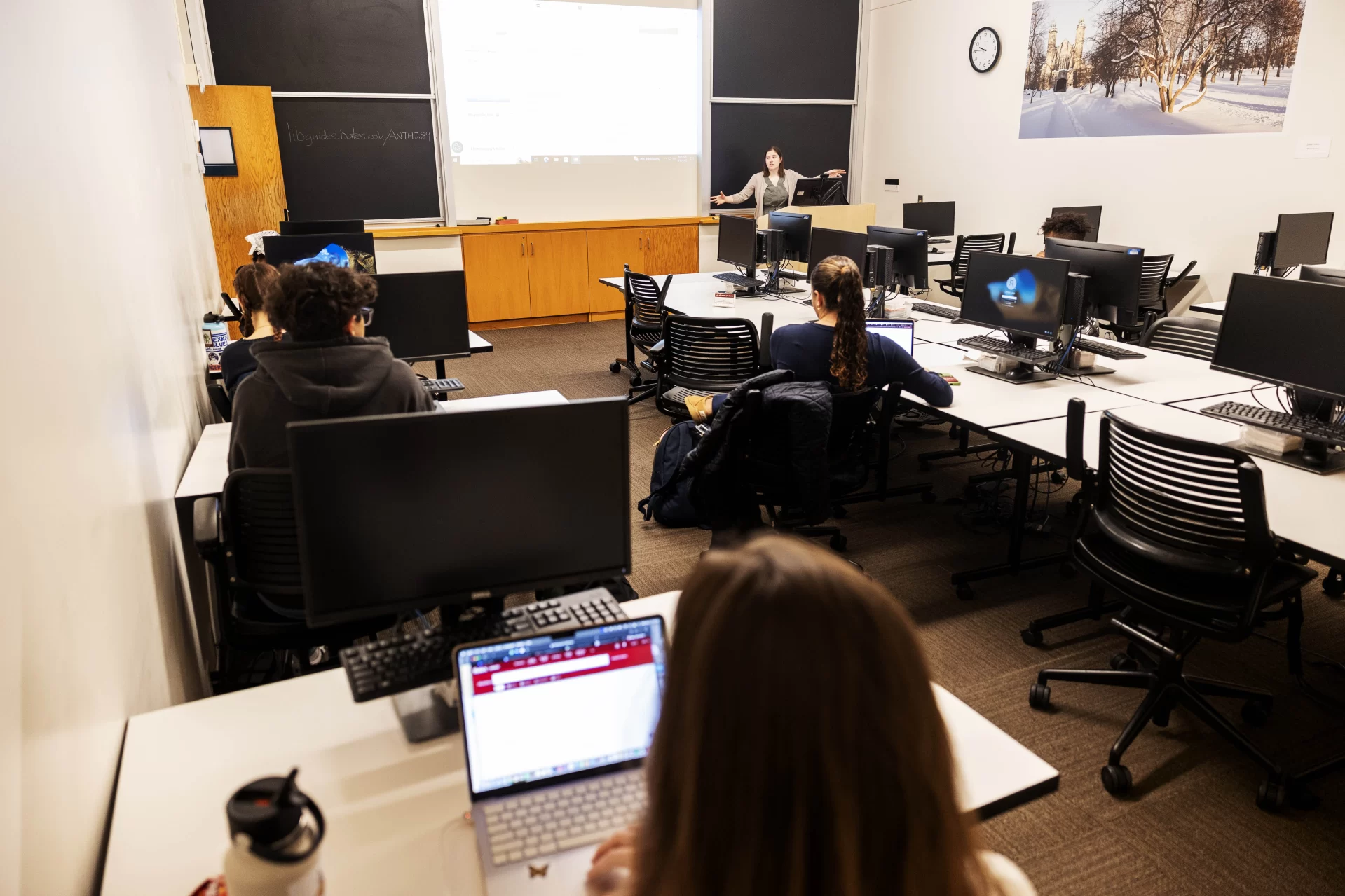
The course is “After Deportation Ethnographies from Latin America and the Caribbean,” taught by Benoit Y. Vallee, who is a visiting assistant professor of Latin American and Latinx studies. The class usually meets in Roger Williams Hall, but today they’re in the library getting a primer from Murray on the course’s online research guide, in preparation for upcoming research papers.
After the class lets out, Christopher Viza ’28 of Chicago gets straight to work, sitting in a chair by the big windows, and trying to get through articles that might inform his paper before his biology lab at noon.
10:28 a.m.
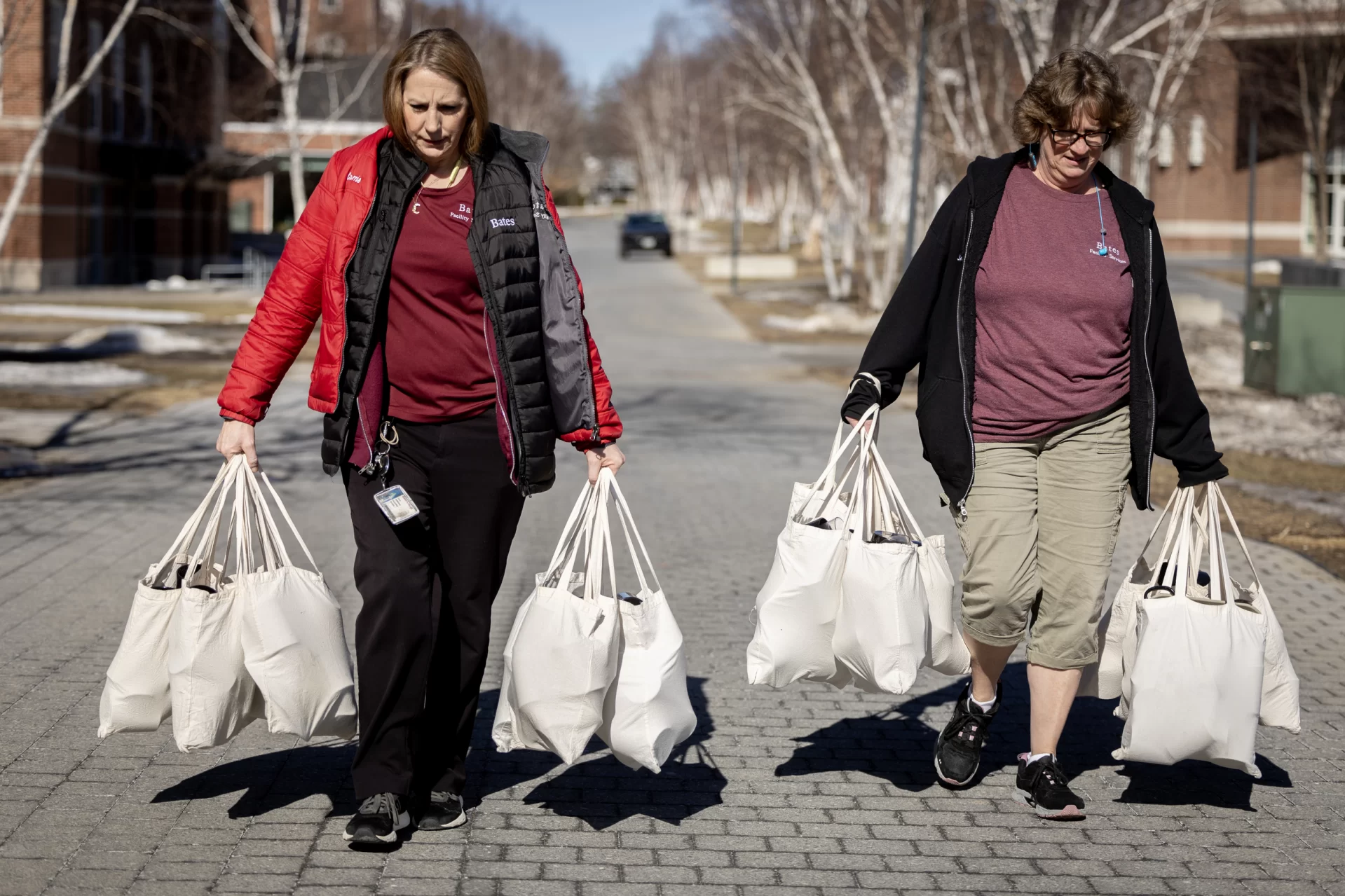
Custodians Carrie VanHerzeele and Sherry Lessard return reusable bowls and cups from Commons left in Ladd Library during the previous day’s study activity. Rather than a “no food” policy, the library asks students to help maintain a clean, welcoming space.
10:45 a.m.
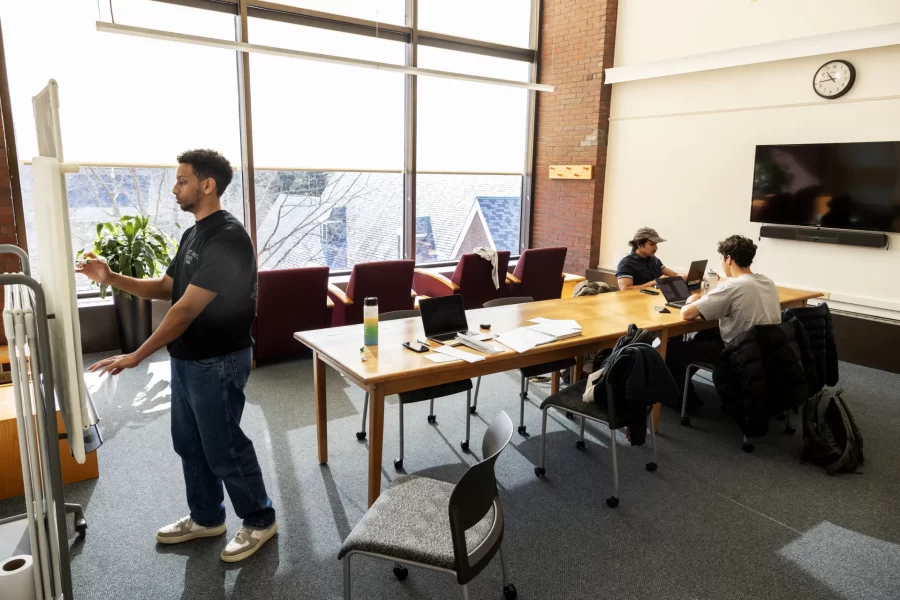
Three seniors — Natnael Yaregal of Addis Ababa, Ethiopia, Devendra Thapaliya of Delray Beach, Fla., and Adrian Allannic of New York City — huddle in the Salter Room on the third floor for a morning spent working on theses and job applications. It’s a good study spot, they say: quiet but still open to group work.
10:58 a.m.
Students kick up their feet on Ladd’s first floor, getting comfortable for studying. On a sunny morning in late winter, a spot next to a window affords views of students enjoying the thawing campus and the refreshing, if fleeting, sunlight.
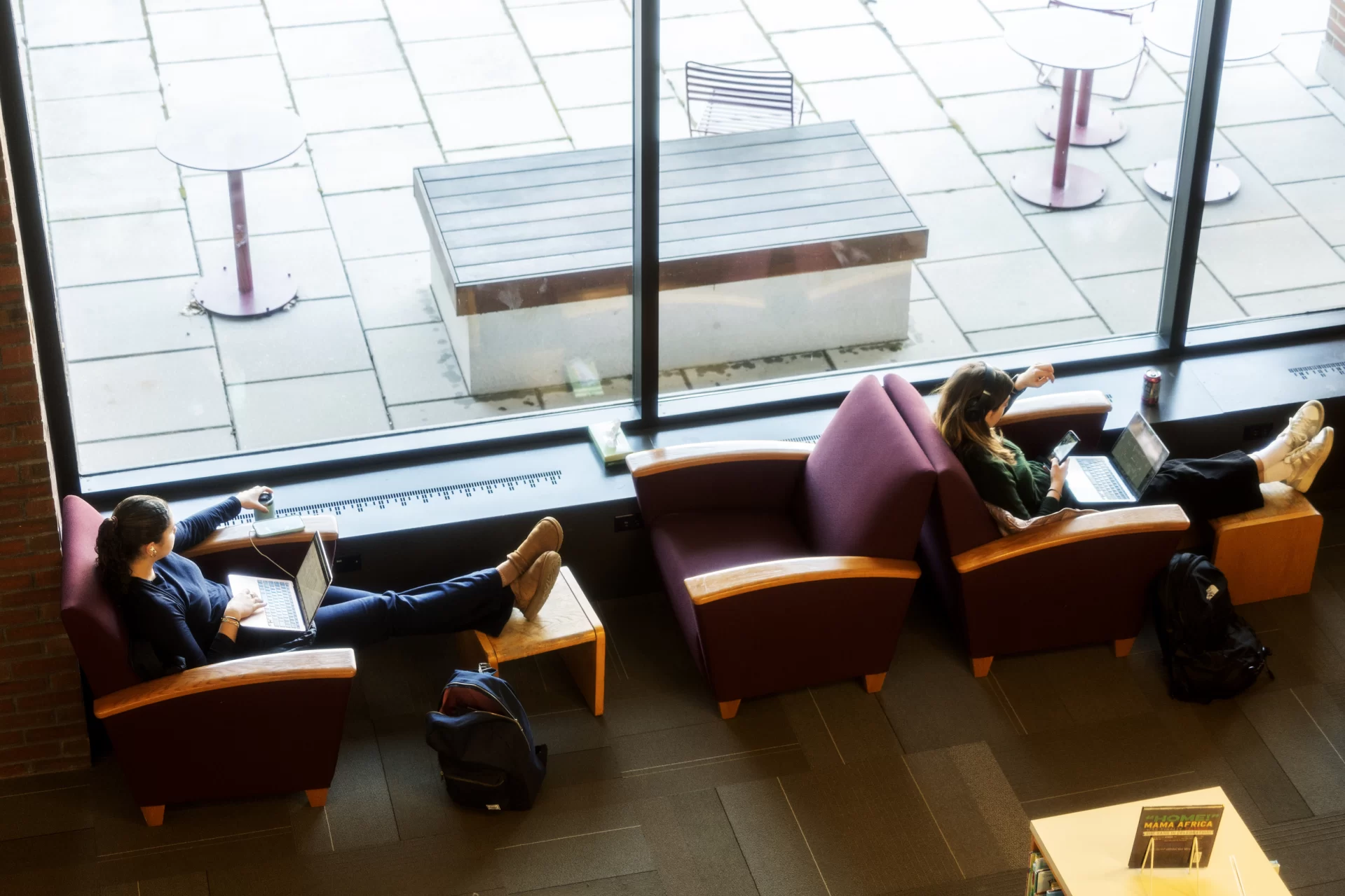
One floor below, in the Peer Learning Commons, Noa Hart ’27 of Hastings on Hudson, N.Y., double majoring in economics and English, is at work in the Peer Learning Commons, where she tutors students in economics but also helps with math, psychology, and statistics.
“When the students have a big conceptual thing that they’re worried about, I try to break it into an example that looks more familiar or maybe they could see in their daily lives,” Hart says. “These concepts from microeconomics are very abstract, and I say to them, ‘It’s a different language. It’s nothing you’ve ever seen before.’”
11:27 a.m.
Temperatures have reached above freezing, and sunshine beams down on the terrace outside Ladd. It’s time for Bobcats to find a warm spot in the sun.
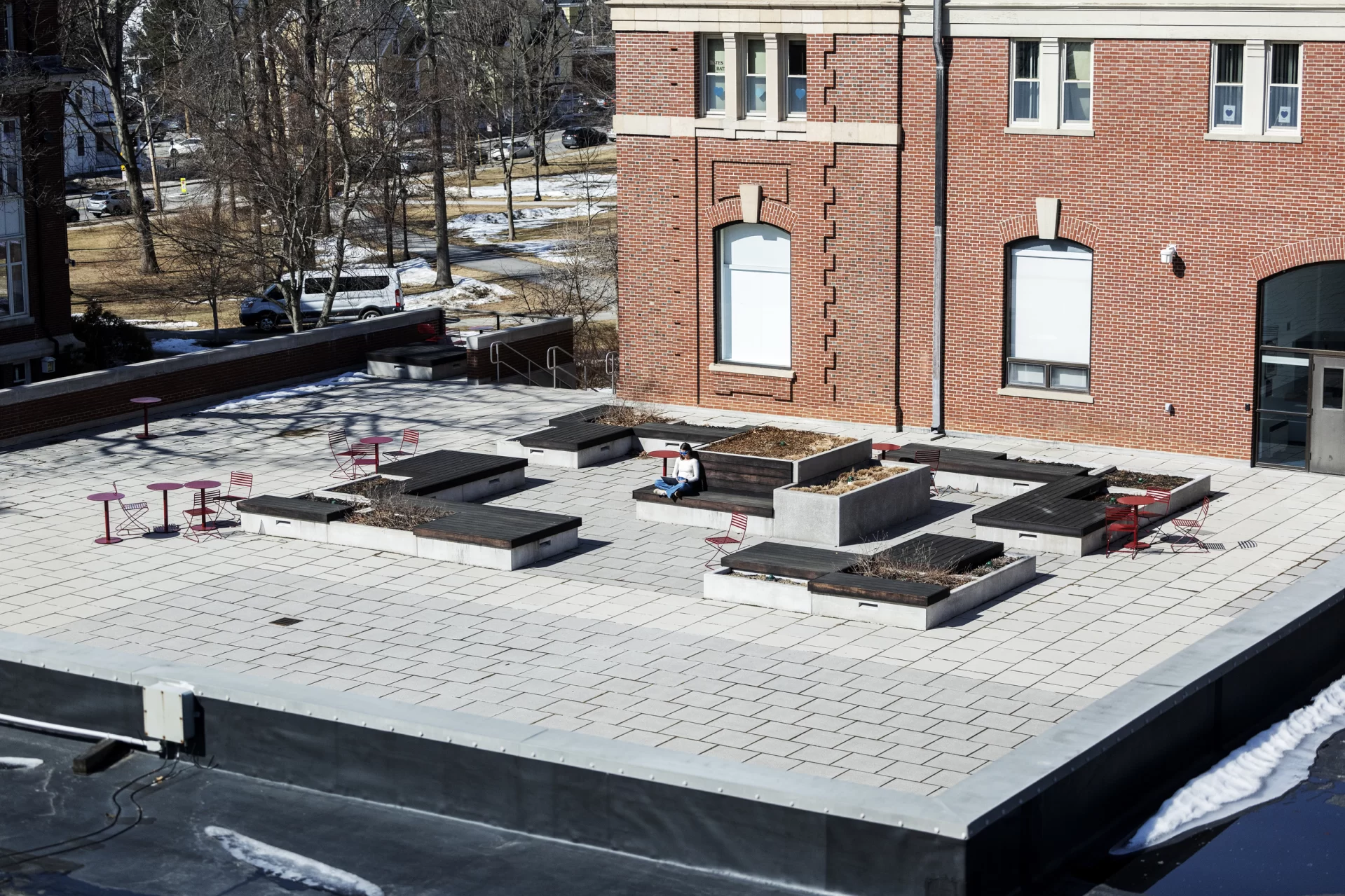
One is Olivia Reynolds ’25 of Cumberland Center, Maine, who is stretched out in front of Ladd, studying Buddhist traditions of death practices.
“Today, I started hearing the birds outside, and that was my first indication that spring is coming,” Reynolds says. “It’s been a long and dark winter, and now that we have more light and sun, and it’s just starting to feel like spring, that’s motivating me to be outside.”
11:29 a.m.
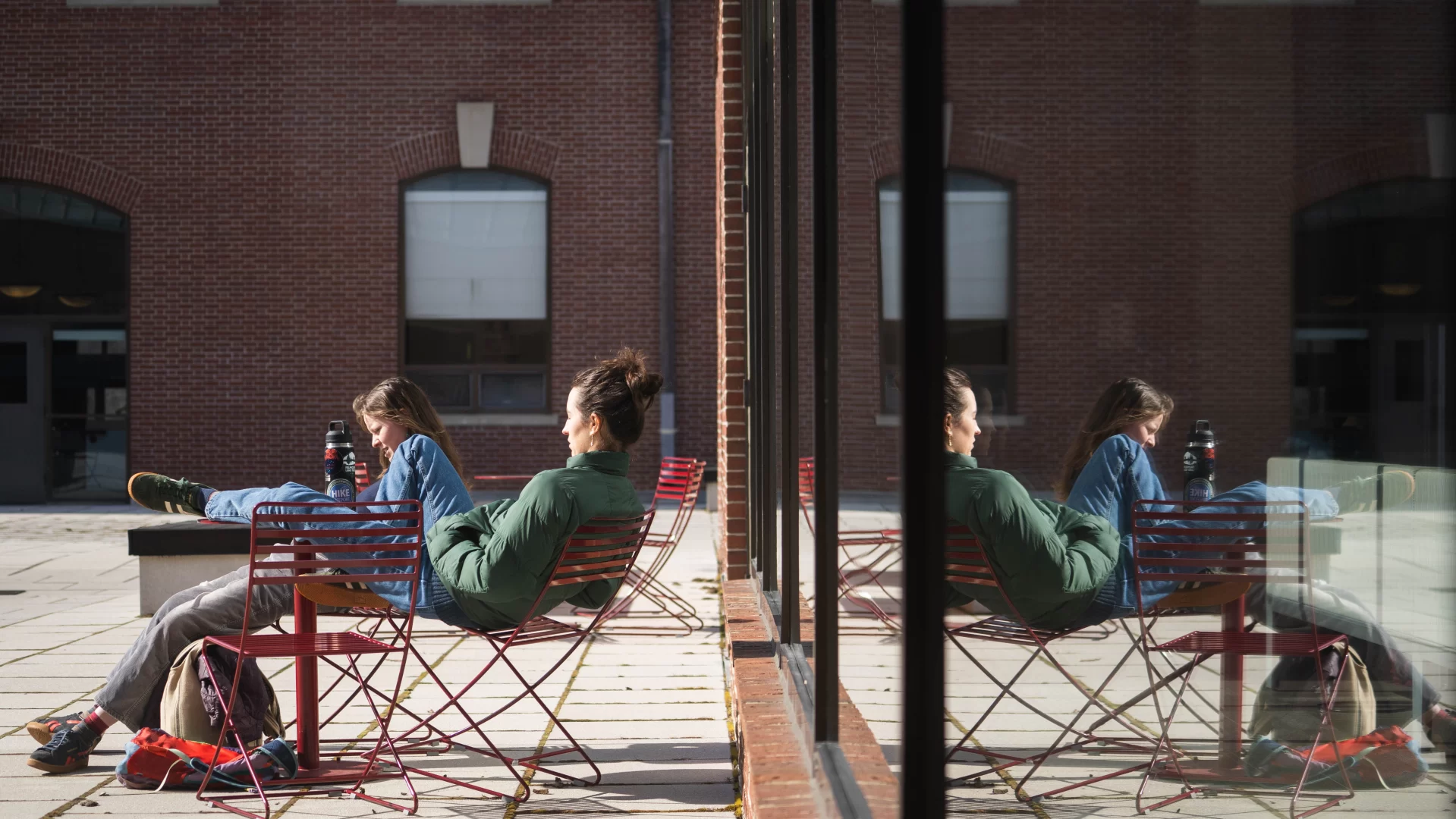
Cecilia McQuaid ’25 (left) of San Francisco, Calif., and Abby Marriott ’25 of Brooklyn, N.Y. , take a break from studying and enjoy the sun on the Ladd terrace.
11:31 a.m.
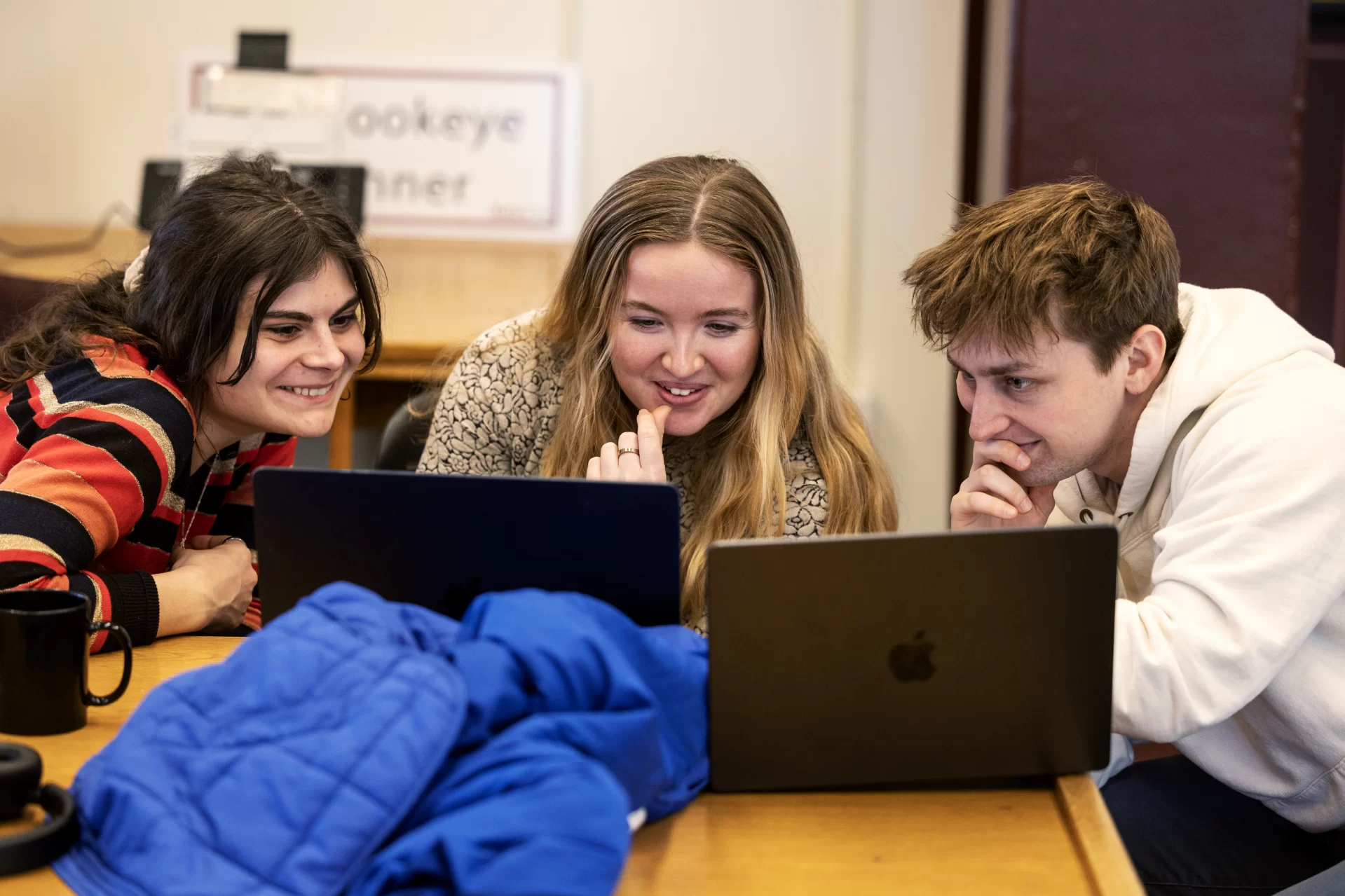
From left, Cerise Stanley ’25 of Bentonville, Ark., May Whelan ’25 of Bristol, R.I., and Liam Shlager ’26 of Ross, Calif., create a game plan as they look over data related to paid family and medical leave in Maine. The project is for the course “Economic Analysis for Non-Profits,” taught by Assistant Professor of Economics Austin Smith.
11:37 a.m.
Marginalia has been around for centuries (see 1:15 p.m. entry!), and has been the bane of librarians equally as long.
If you seek out a copy of Chaucer’s Canterbury Tales (call number PR1870.A1 R34 200), you’ll see some ambitious marginalia. Someone decided not only to translate “The Prologue,” but to do so in pen. They got 11 lines in before giving up.
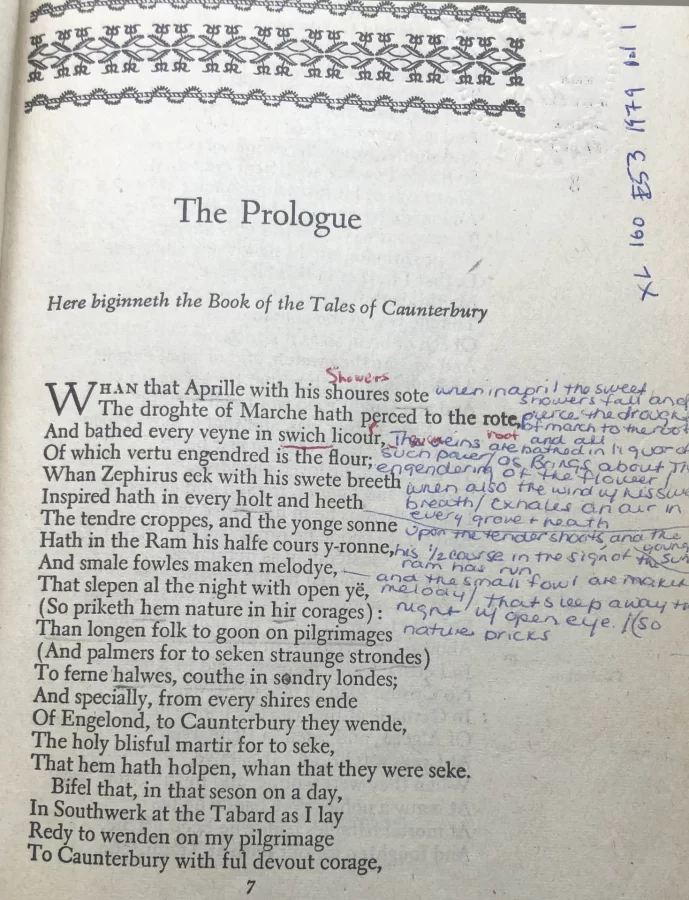
Nearby is Virginia Woolf’s A Room of One’s Own (PR6045.O72 Z474). More marginalia. A reader circled the book’s feminist manifesto: “I need not hate any man; he cannot hurt me. I need not flatter any man; he has nothing to give me.”
Also nearby is a copy of Oscar Wilde’s The Picture of Dorian Gray (PR5819.A2 P43), where marginalia sums up the telling moment when Dorian remembers being watched by James Vane, the brother of Sibyl Vane — whose death Dorian helped cause. The reader circled this text and wrote, “Evil never will forget.”
11:53 a.m.

Sav Thomson ’28 (left) of Saint Andrew, Jamaica, and Daina Velez ’25 of Bronx, N.Y., lay on one of the square benches on the Ladd terrace enjoying a moment of sunshine, one of the first after a long winter.
11:54 a.m.
Ayden Brusa ’27 (left) of Skowhegan, Maine, and Madyson Gonzalez ’25 of Suffern, N.Y., offer assistance at the IT Service Desk on the first floor of the library.
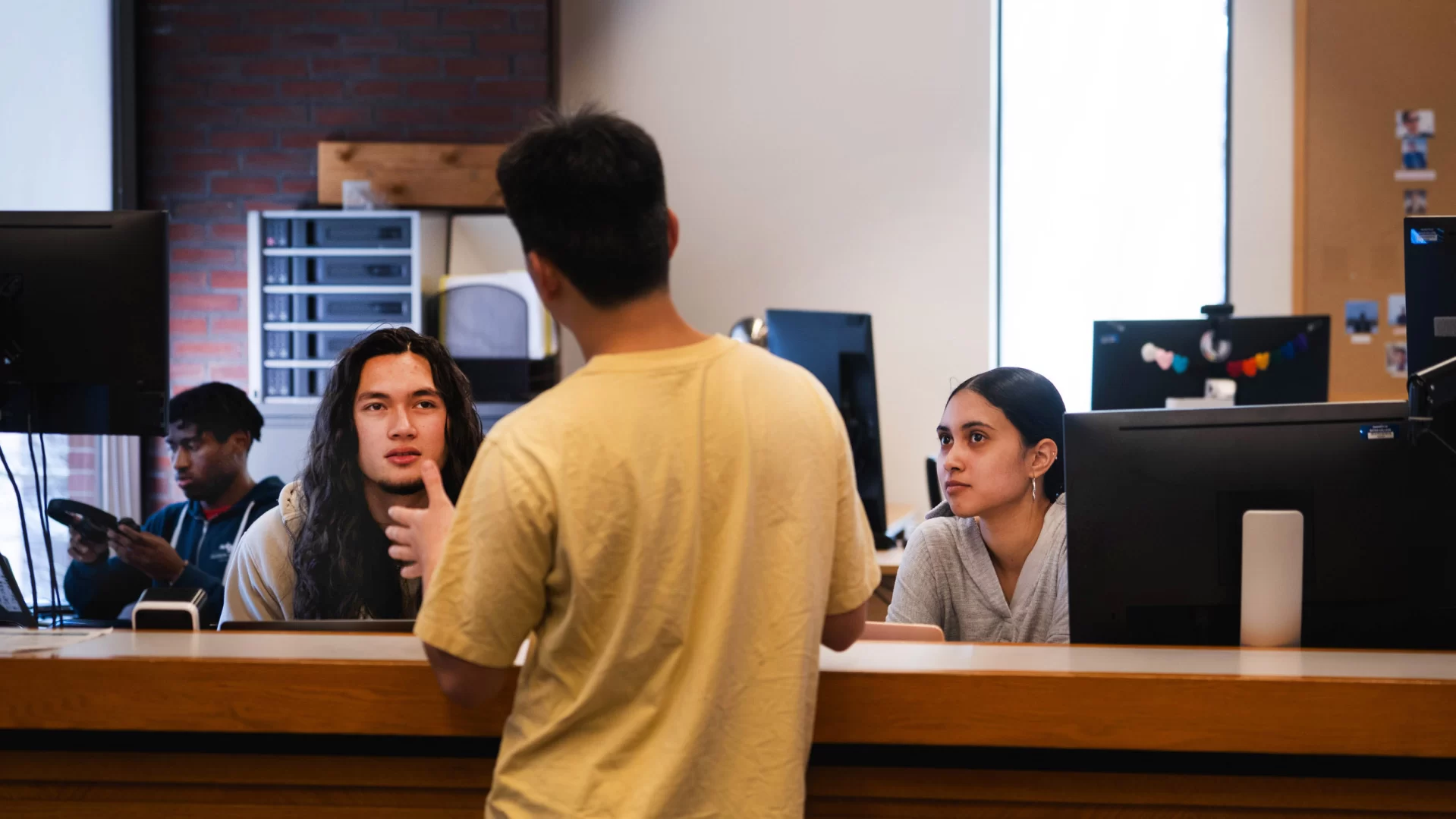
Students complement and support the work of the IT Desk’s professional staff. During a typical month in the academic year, the service desk handles upward of 450 tickets for the campus community.
For the most part, student requests for help often include printing and software problems — the latter of which can usually be solved with a simple computer restart, says Mamadou Diallo ’25 of Somersworth, N.H.
Occasionally, the student team gets scam calls or a request that they have to elevate to their superiors, but they are able to resolve most requests on their own, they say.
“Mostly, it’s not that difficult,” Diallo says. “It’s just being able to communicate well with whoever needs help and trying to understand them.”
11:55 a.m.
You can still find some vintage card catalog cabinets in Ladd Library. This one is in the bibliographic area. The card lists annual reports for the Federal Power Commission (now the Department of Energy) dating to 1921.
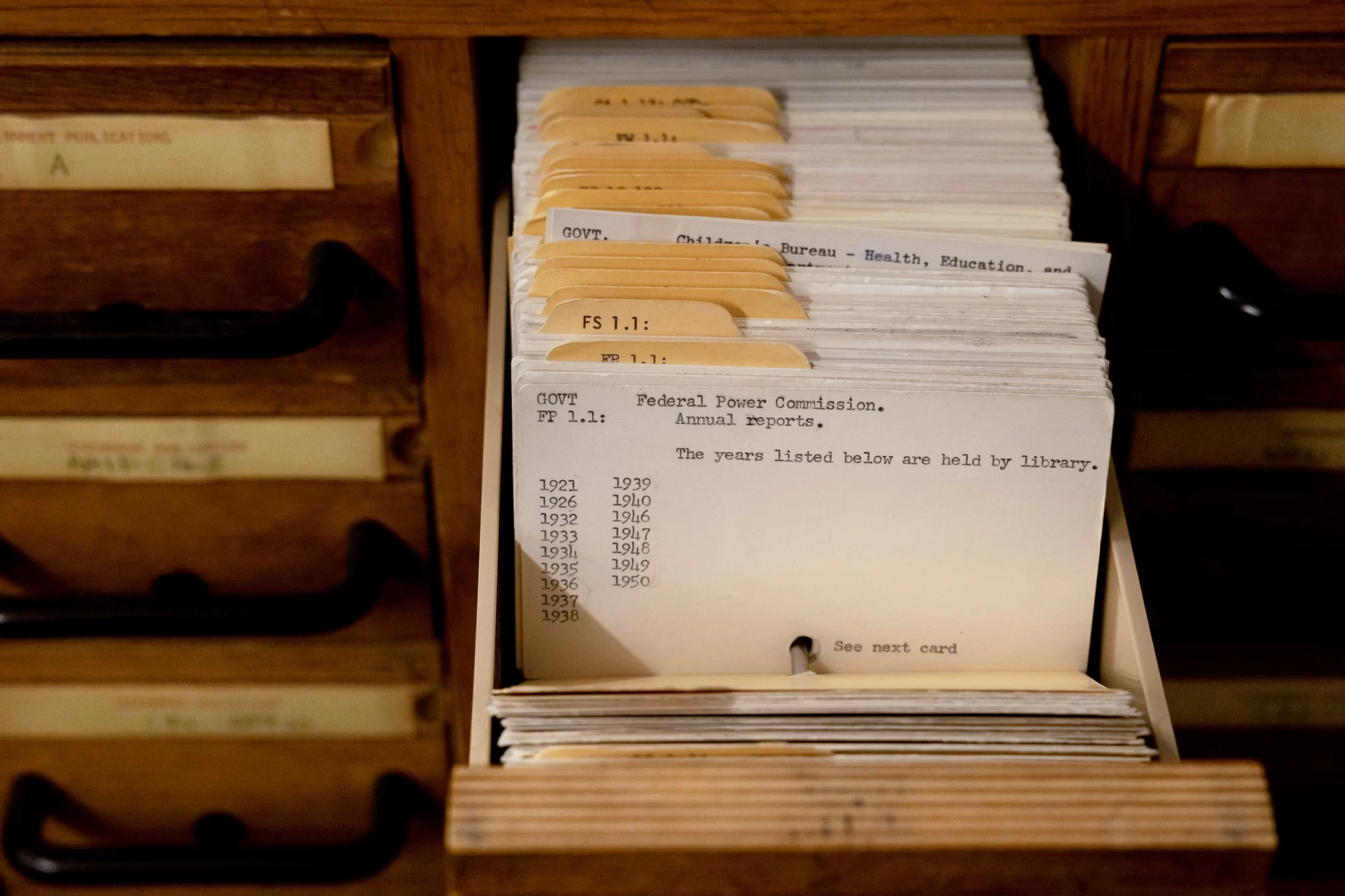
The entries reflect the fact that the Bates library is an official federal records depository, the first in Maine, in 1883. Because many federal documents were not originally cataloged into an online system, Bates has kept this card catalog in use over the years.
11:59 a.m.
When a library needs to describe a resource for the online catalog — be it a book, a movie, or music — metadata librarians like Matt Banning go to work, ensuring that everything is properly described to maximize its “findability.”
On this day, Banning is in his first-floor office working to catalogue Bates’ collection of nearly 2,000 pieces of 19th- and 20th-century sheet music. The antique pieces are less fragile than one would expect, Banning says, though flakes of paper still dot his office floor as he sorts through the collection.
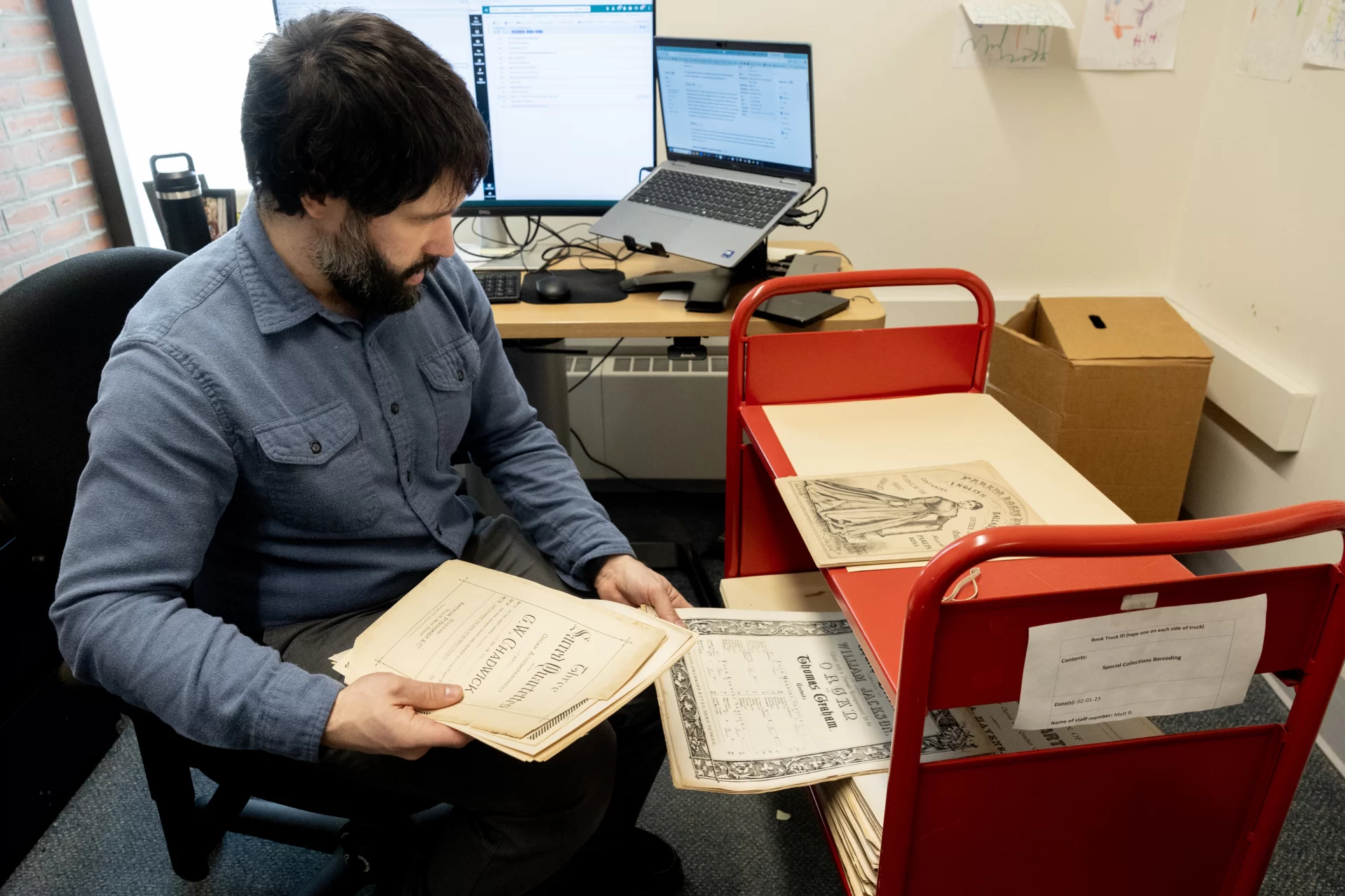
The sheets have traveled far and wide to end up at Ladd. Music collector George W. Harris gifted much of the collection to Bates upon his death in 1904; Bates then sold the collection to Bowdoin, which later returned the sheets to Bates.
Other sheets arrived all the way from Australia, by way of the collection of Australian-turned-New-Yorker Irma Caron and her husband Marmion P. Greenwood-Adams, an artistic couple who vacationed in Maine.
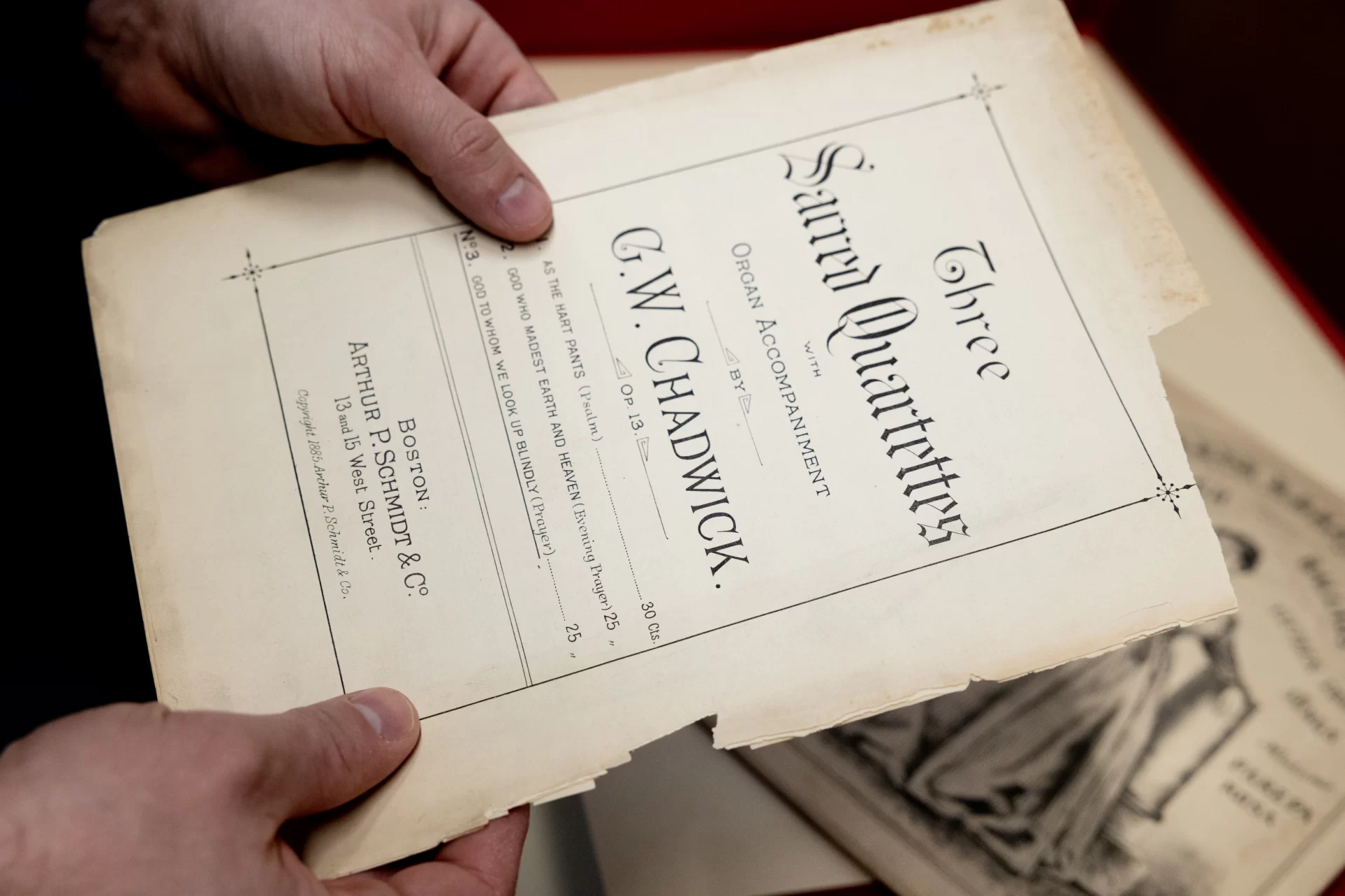
“These are really historical documents. They show us what music was popular back in the 1800s and early 1900s,” Banning says. “We also see this very interesting history of New England. I pay attention to things like signatures that are on them.”
12:09 p.m.
From left, seniors Henry Lennig of Scarborough, Maine, Miles Miller of Spring, Texas, and Daniel Snider of Belfast, Maine, “blow off some steam” by playing a geography game.
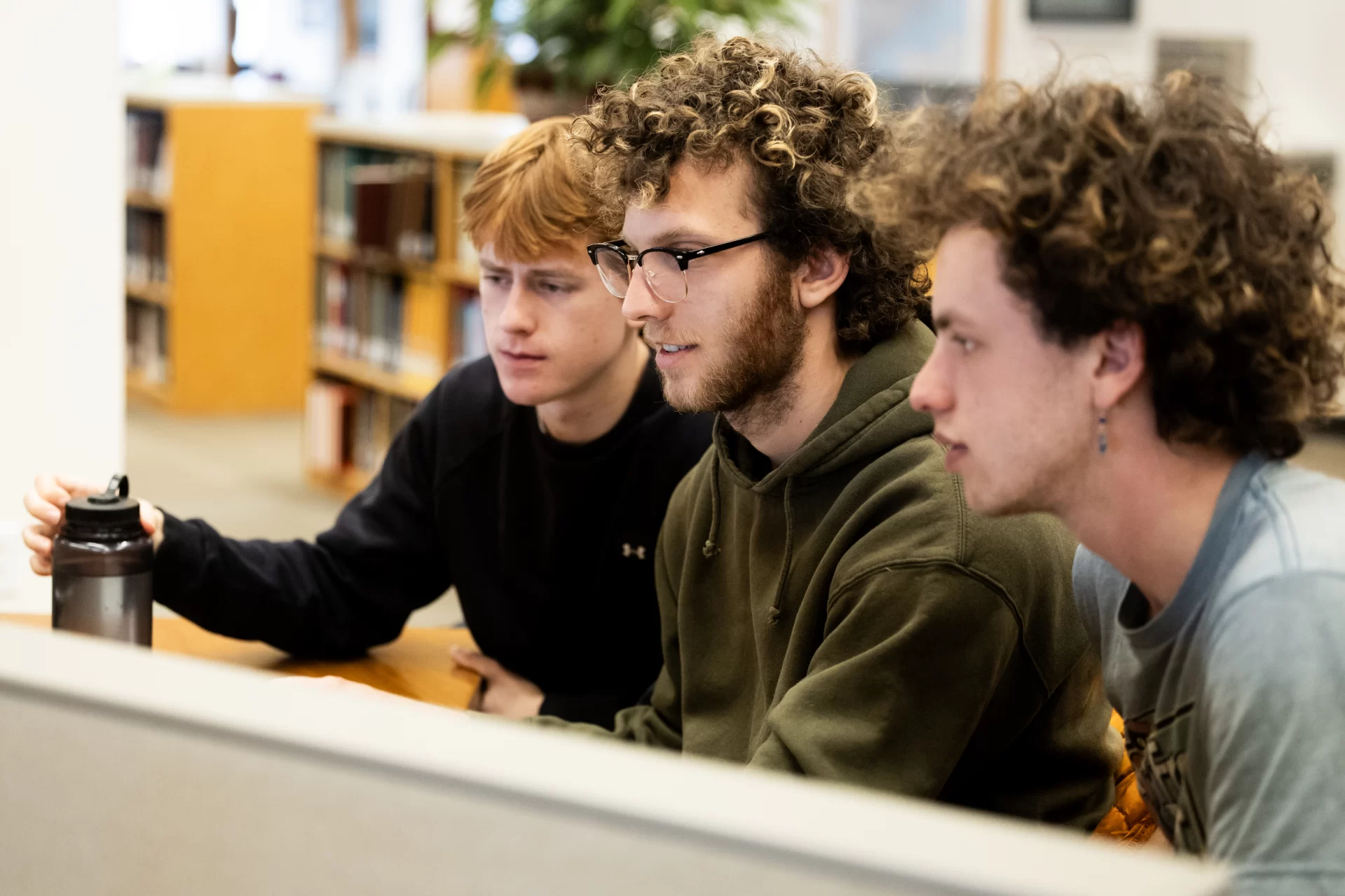
12:19 p.m.
Senna Cabenguele, a technology support specialist, dons a “Lewiston Strong” hat while working in the IT support area. At Cabenguele’s desk, old technology meets new, evidenced by a vintage Super Nintendo game console sitting beside his computer.
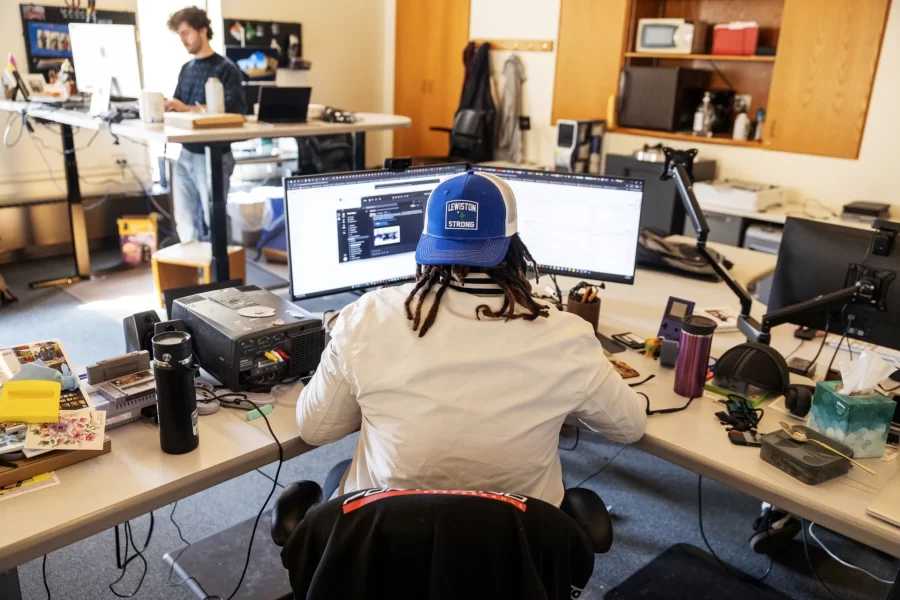
On his desk, and on those of his colleagues, are various trinkets, relics, and curiosities. Nearby, Nathan Hann has 3D printed objects on his desk that his colleague, Keith Hord, created at home. “I have them for people to play with while I work on their computer,” says Hann.
The 3D items include a frog, pumpkin, sloth hanging from tree, an ocarina (a magical instrument from The Legend of Zelda series), and a lizard with a broken tail.
12:37 p.m.
Midday, community members and Batesies alike gather on Ladd’s first floor to watch Pat Webber, director of the Muskie Archives, “flip the birds” — a.k.a, change the page displayed from Bates’ copy of John James Audubon’s iconic Birds of America.
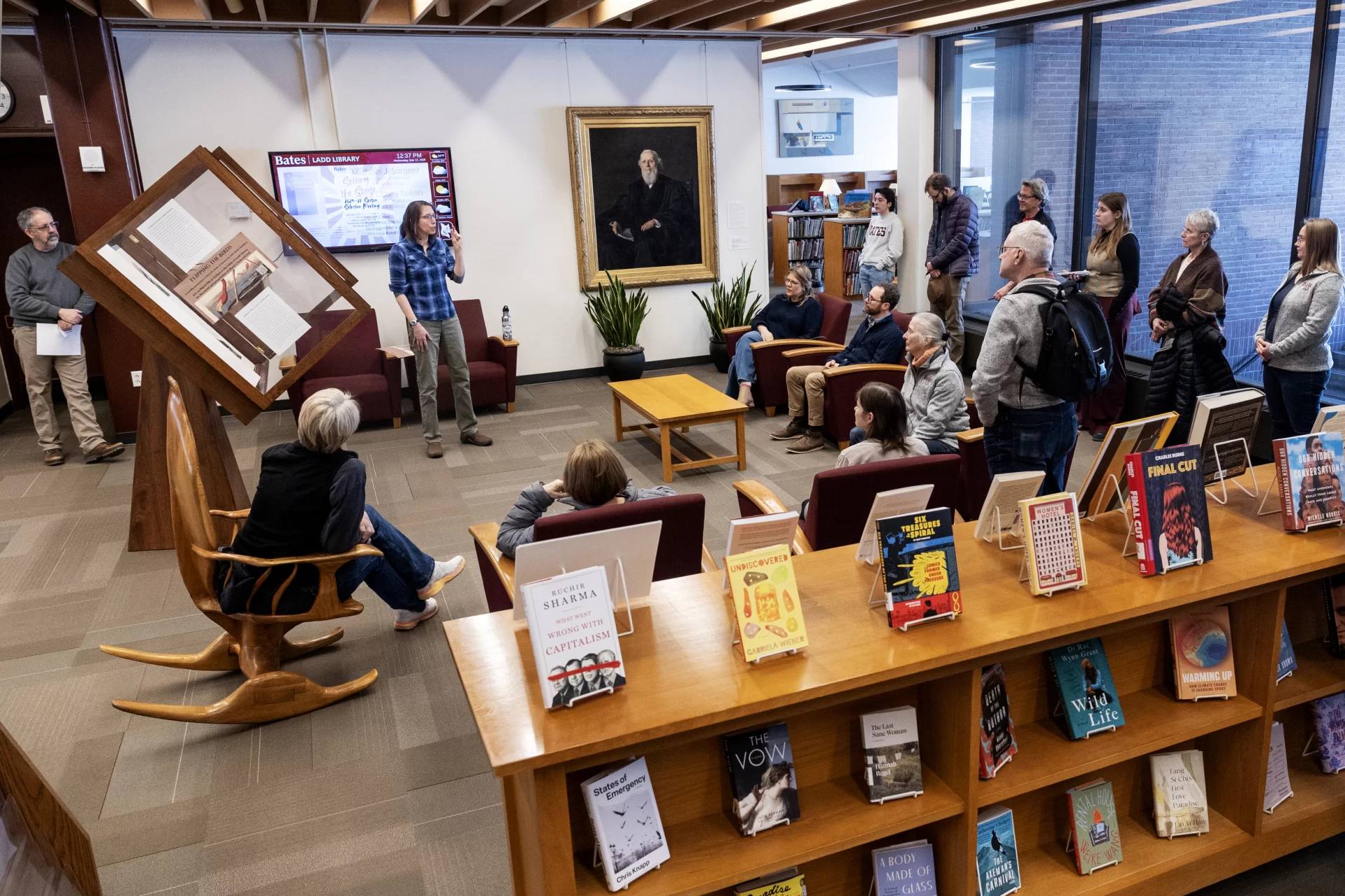
The 2-by-3 foot book of illustrated birds rests in a wooden display case, designed by the late Thomas Moser, near Ladd’s main entrance. Each month, archives staff change the displayed pages to exhibit new birds and invite an expert to discuss the avians.
This month, the guest expert is ecologist Emily Runnells, who talks about the Atlantic puffin and the razorbill, both found along Maine’s coast. The birds build small colonies on difficult-to-reach rocky islands in the Gulf of Maine,
“They spend a lot of time here,” Runnells says. “If you manage to get out on the ocean in the winter, you can find anything out there.”
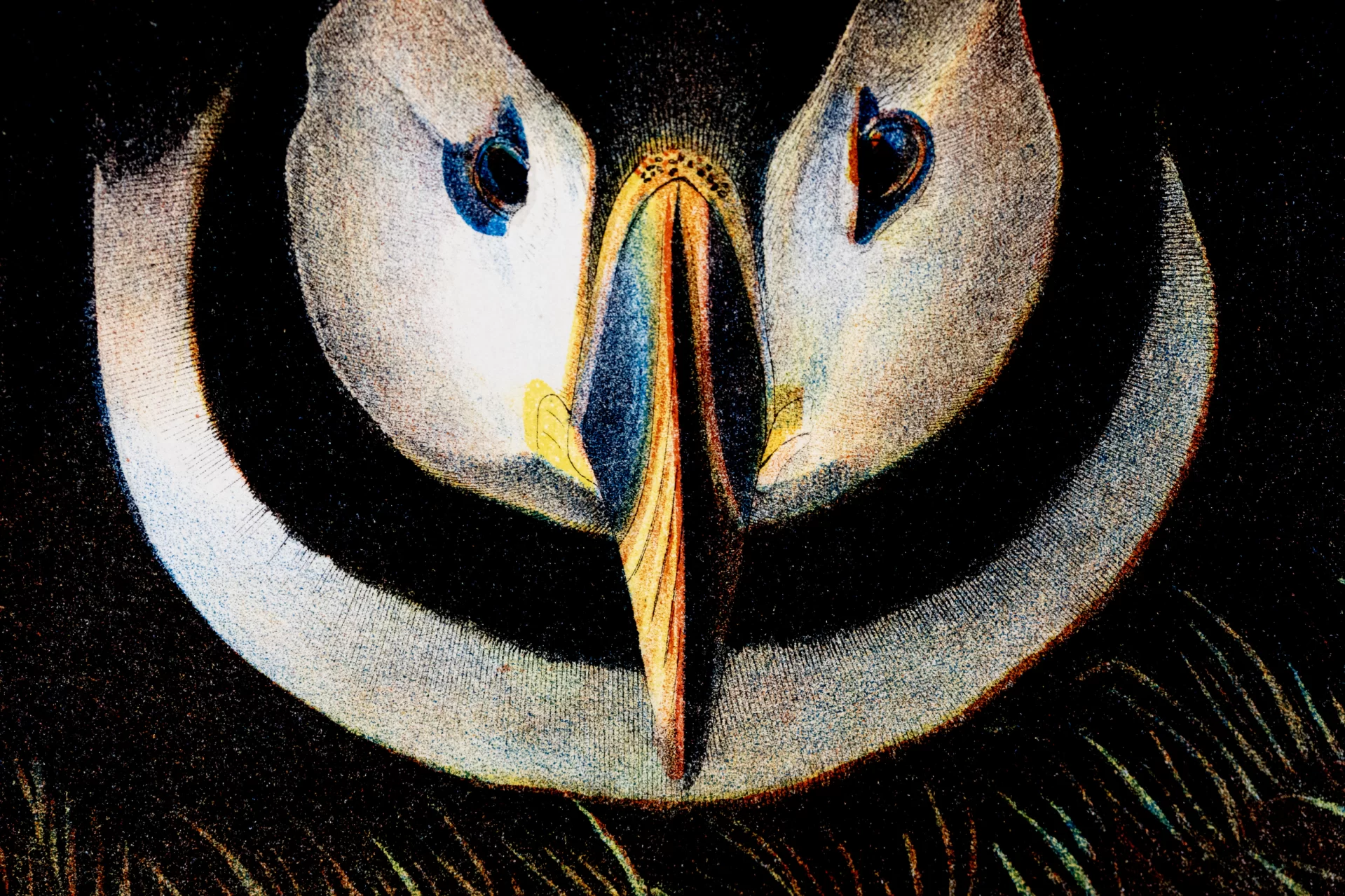
12:37 p.m.
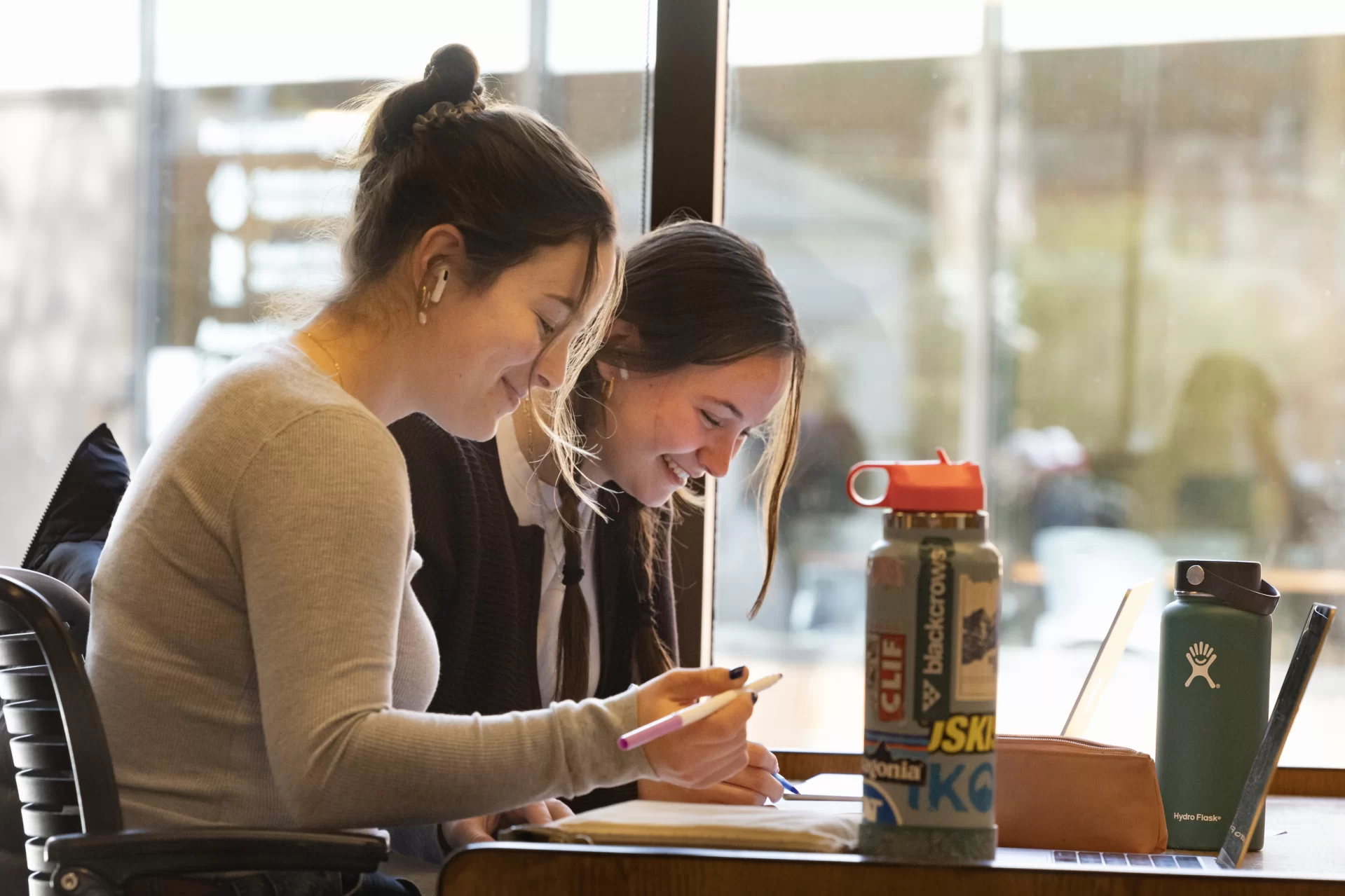
Juniors Amanda Yolles (left) of Bel Tiburon, Calif., and Samantha Gabel (right) of Sherman Oaks, Calif., who are sitting with Lexi Inger, like to hang out on the ground floor — half studying, half socializing, they say.
12:54 p.m.
Christine Murray (left) talks with fellow research librarian Marianne Williams (right) at the main research desk on Ladd’s first floor.
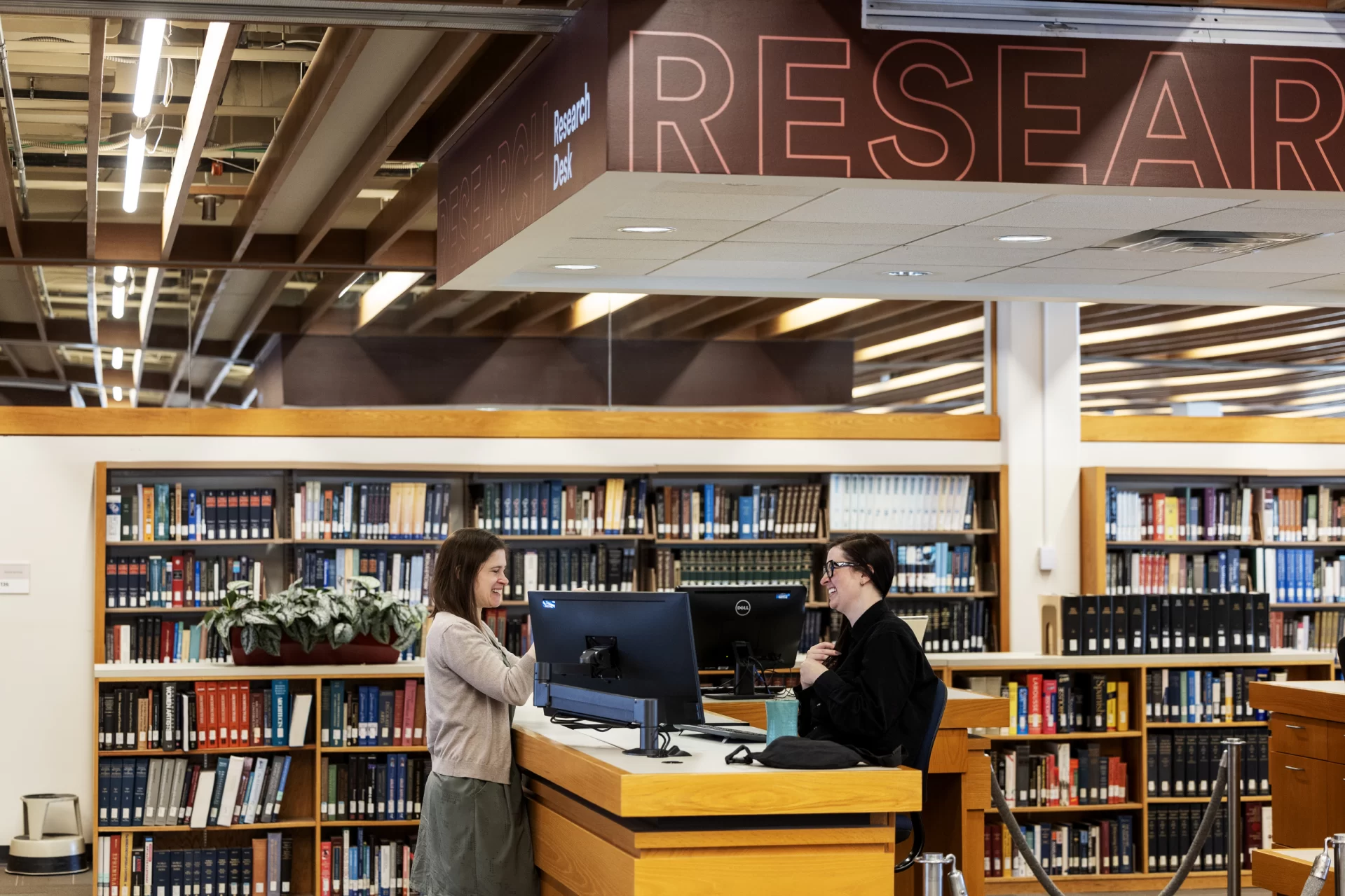
Williams, who handles humanities-related research inquiries, is busy looking into acquiring a few French films for a Short Term course. She is constantly purchasing and managing physical and digital research assets, both for general campus use and for faculty’s specific research interests, which she closely tracks.
“At Bates, we really try to make sure that our collection is reflective of the curriculum,” Williams says.
One of her recent purchases is Holy Smoke, an art book about the use of incense in classical cultures around the world, which Williams purchased to complement Assistant Professor of Classical and Medieval Studies Liana Brent’s research on ancient death practices. The dark smudges staining the large book are, surprisingly, not damage from an overly-inspired reader but rather an intentional artistic choice.
“It’s got a carbon material in the cover so that when you touch it, it creates this ashiness,” Williams says. “The idea is that you’re actually supposed to get the book dirty.”
Before she puts Holy Smoke away, Williams places the book back inside of the clear plastic bag that protects its neighboring books from the ashy residue.
12:57 p.m.
Newspapers are displayed on the library’s first floor, just left of the entrance.
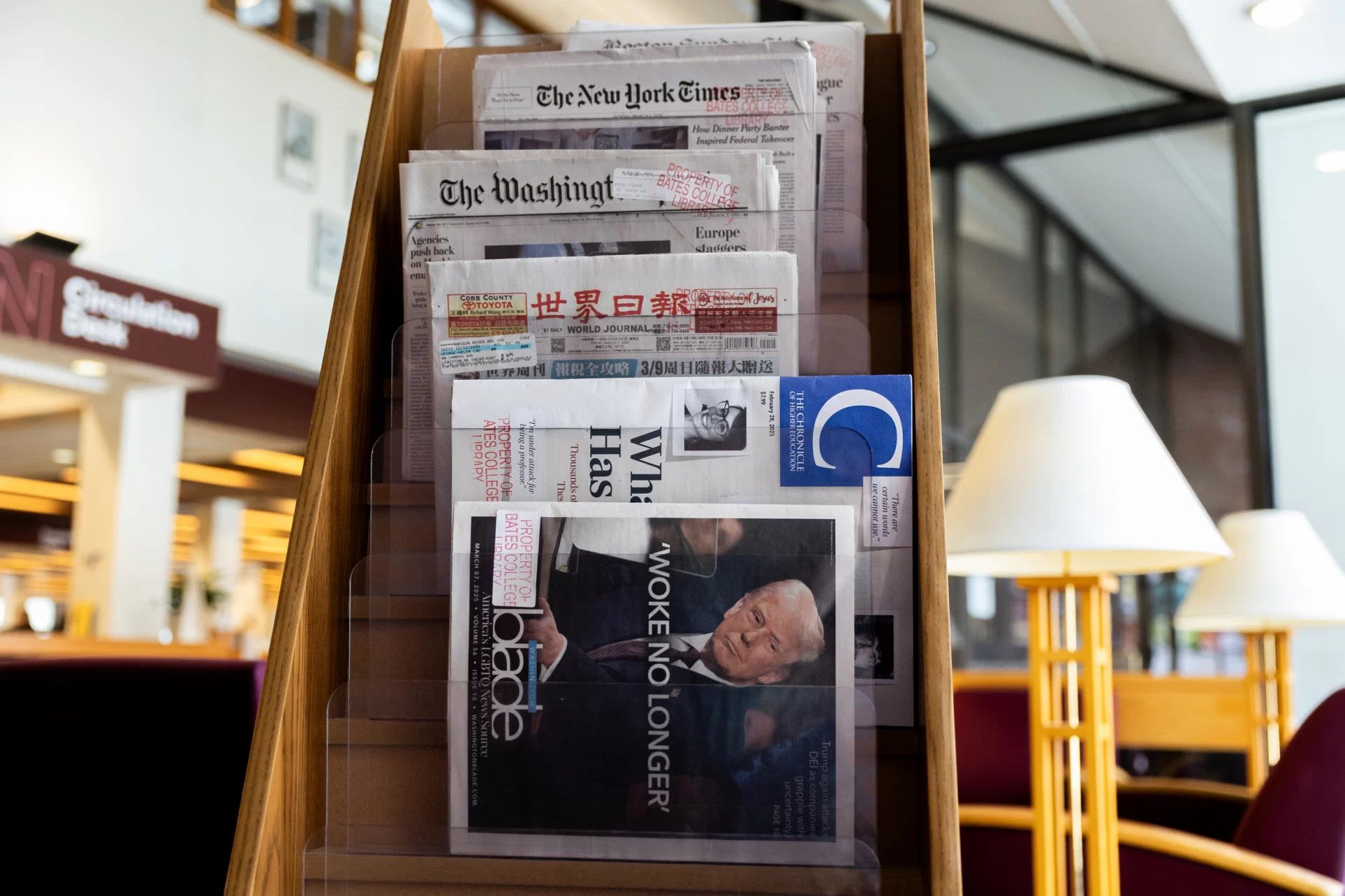
Titles here are, from top, The Boston Globe, The New York Times, The Washington Post, the World Journal, The Chronicle of Higher Education, and the Washington Blade. Other print editions include the Lewiston Sun Journal, Bangor Daily News, The Wall Street Journal, and The Bates Student.
1:06 p.m.
Ladd Library is for all ages. The physical collection of the award-winning Diverse Bookfinder is housed on the first floor of Ladd, including titles of children’s books like All Because You Matter by Tami Charles, I Give You My Heart by Pimm van Hest, and Beautiful Moon: A Child’s Prayer by Tonya Bolden.
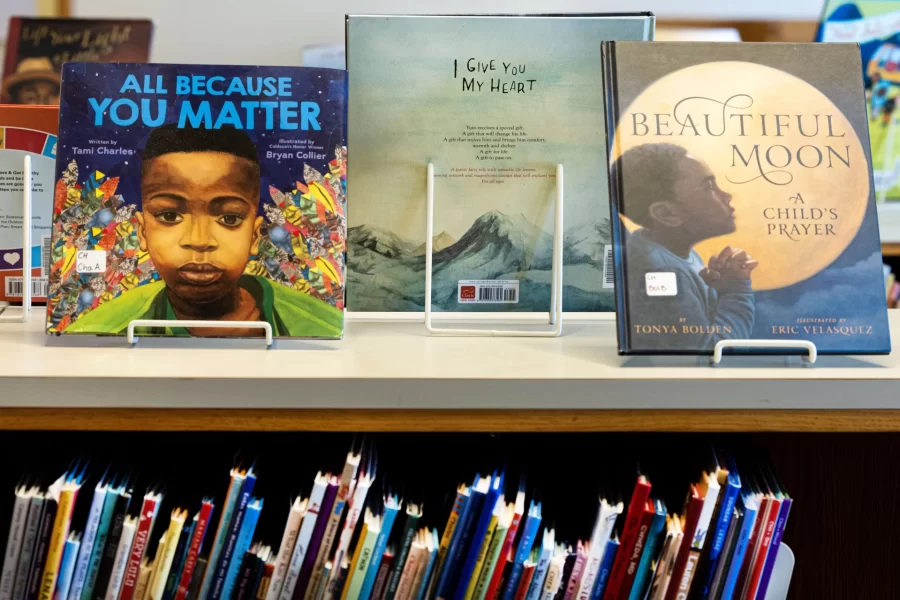
The Diverse Bookfinder is a resource for librarians, educators, parents, book creators, and publishers who seek children’s books featuring characters who are Black, Indigenous, and people of color.
The platform was founded at Bates, based on work begun in 2010 by Krista Aronson, an associate dean of the faculty and professor of psychology; Anne Sibley O’Brien, an award-winning author and illustrator of books about diverse children and communities; and Brenna Callahan ’15, whose interest in diverse picture books was inspired by her work with an early literacy intervention program in Maine.
1:08 p.m.
Salem Aqraa ’27, who had the early morning shift at the IT Service Desk, returns for a busier shift. He is helping fellow sophomore Leighton Kelly of Cohasset, Mass., who is having wifi issues.
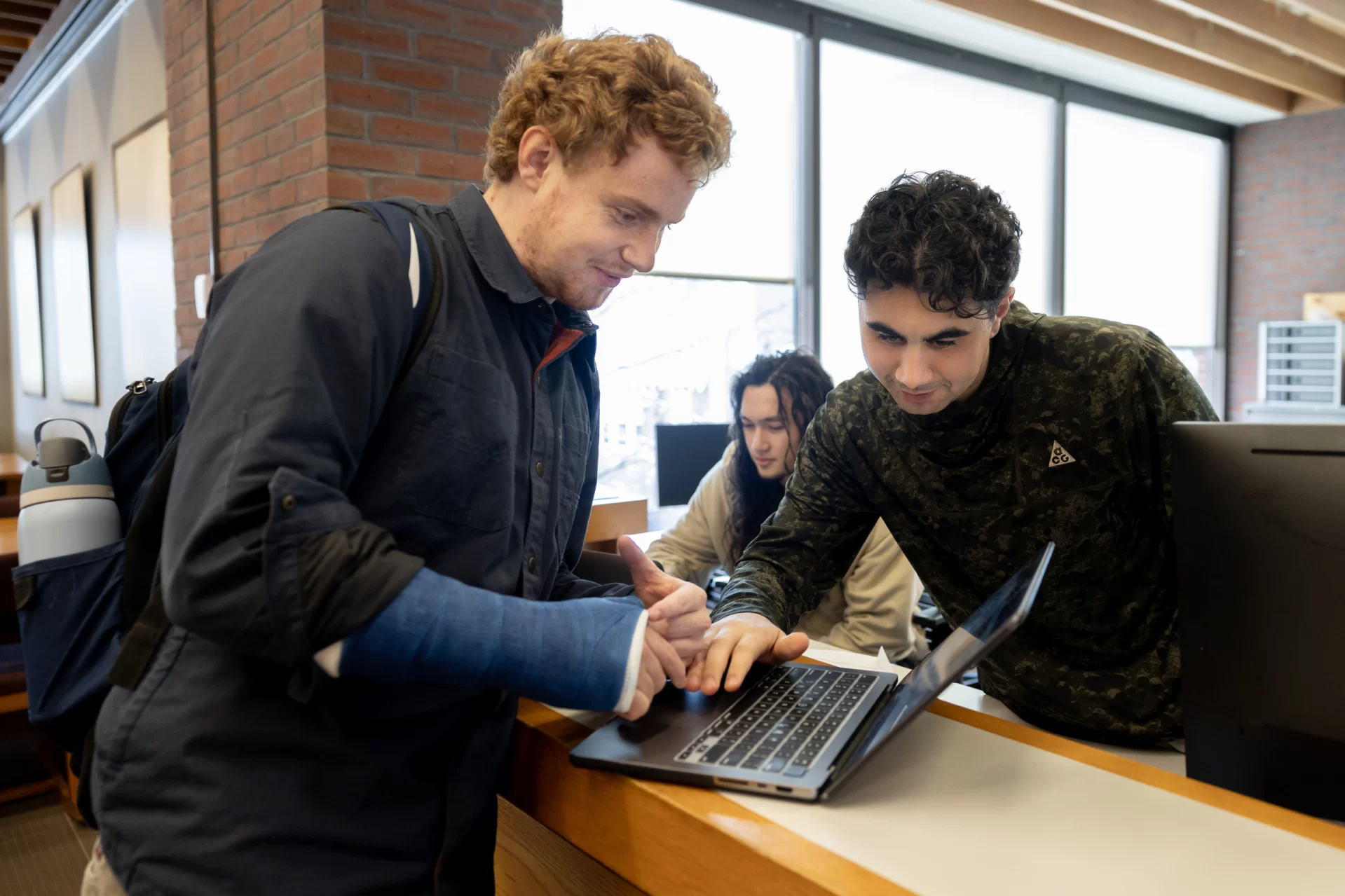
1:18 p.m.
After “flipping the birds,” Webber heads up to the second floor, to the storage area for the Edmund S. Muskie Archives and Special Collections Library. Tucked away just outside of a stairwell, the unassuming room is a treasure trove items related to Bates and to Muskie, the revered statesman who graduated from Bates in 1936.
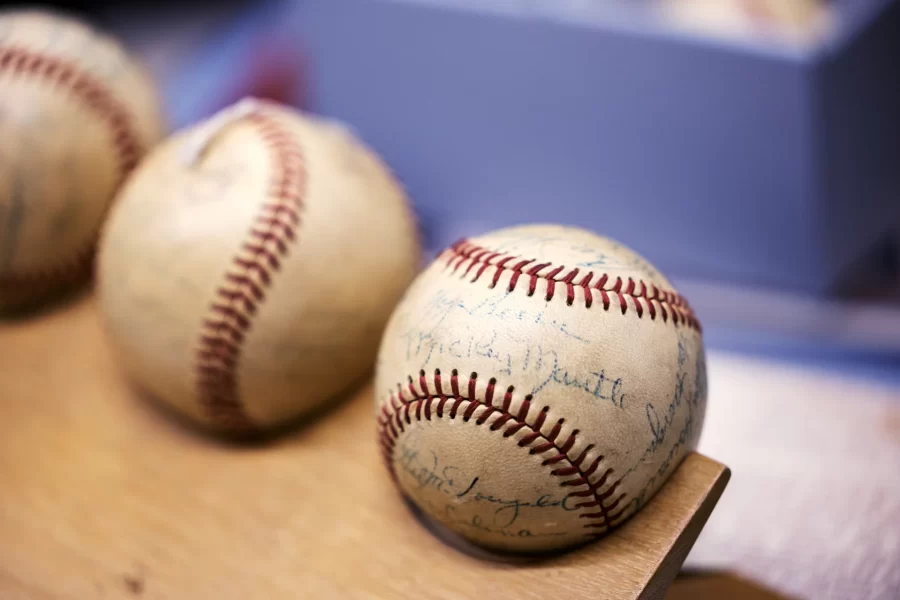
Webber presents a collection of three baseballs signed by members of the Giants, Yankees, and Dodgers — all New York baseball teams at the time — including legends like Mickey Mantle, Jackie Robinson, and Willie Mays. The signed balls were given to Muskie, who was governor of Maine at the time, and other U.S. governors attending the annual governors’ conference in Atlantic City, N.J., in June 1956.
Another item represents Bates campus history: architectural models of Olin Arts Center and Ladd itself, created by the two buildings’ famed architects, The Architects Collaborative.
And world history is represented by centuries-old rare texts. One such volume is a book written in Latin dating to around the 14th century and likely from the United Kingdom or the Low Countries, says Webber.
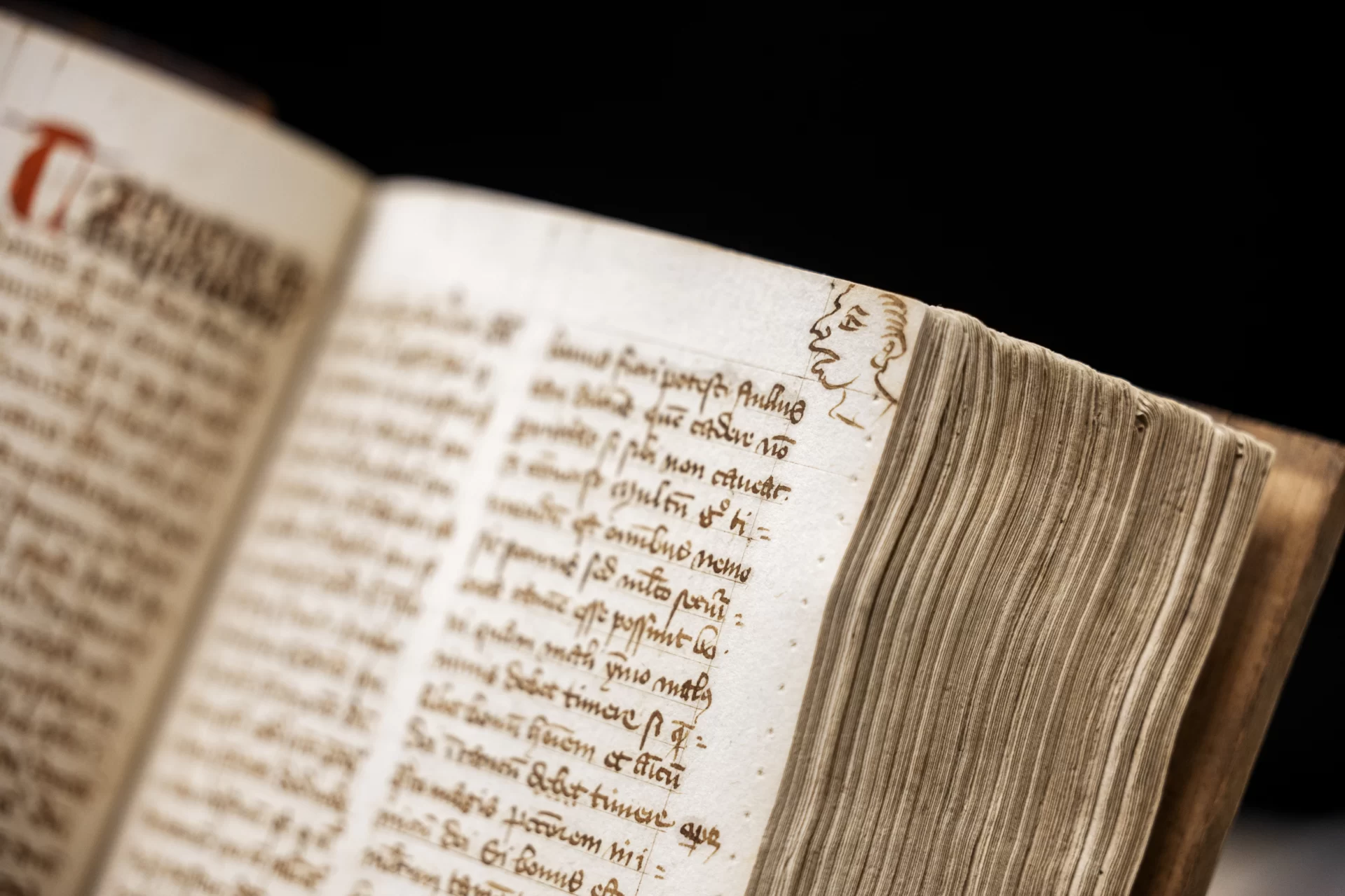
The book’s contents, seemingly composed of Biblical excerpts and sermons, are written on paper made from cloth, which is often more durable than modern paper.
As Webber carefully flips through the book, an amusing hand-drawn face peeks up from the top corner of a page, rare marginalia in the otherwise unadorned text.
“Maybe that’s a reaction,” Webber says. “It’s a 14th century meme. An OMG meme, or something like that.”
1:48 p.m.
First-year students and “best friends” Misra Ahmed, Natalie Gersen, Ellen Cabin, Natalie Damer-Salas, and Queenie Tsang study together at a table toward the back of the first floor of Ladd, a popular spot for group work and chatting.

They’ve pulled up extra chairs to their table so everyone is included — and within arm’s reach of a bag of chocolate candies, shared fuel for studying.
1:52 p.m.
Alec Spiro ’25, Matt Riseman ’26, Abby Hubbard ’26, and Olivia Dorion ’26 put their heads together on a midterm project for their “Youth Sociopolitical Development” psychology course.
Here, they’re organizing flyers that they’ll post around campus. The flyers have QR codes inviting students to take a survey about their experiences with dorm damage in campus residences.
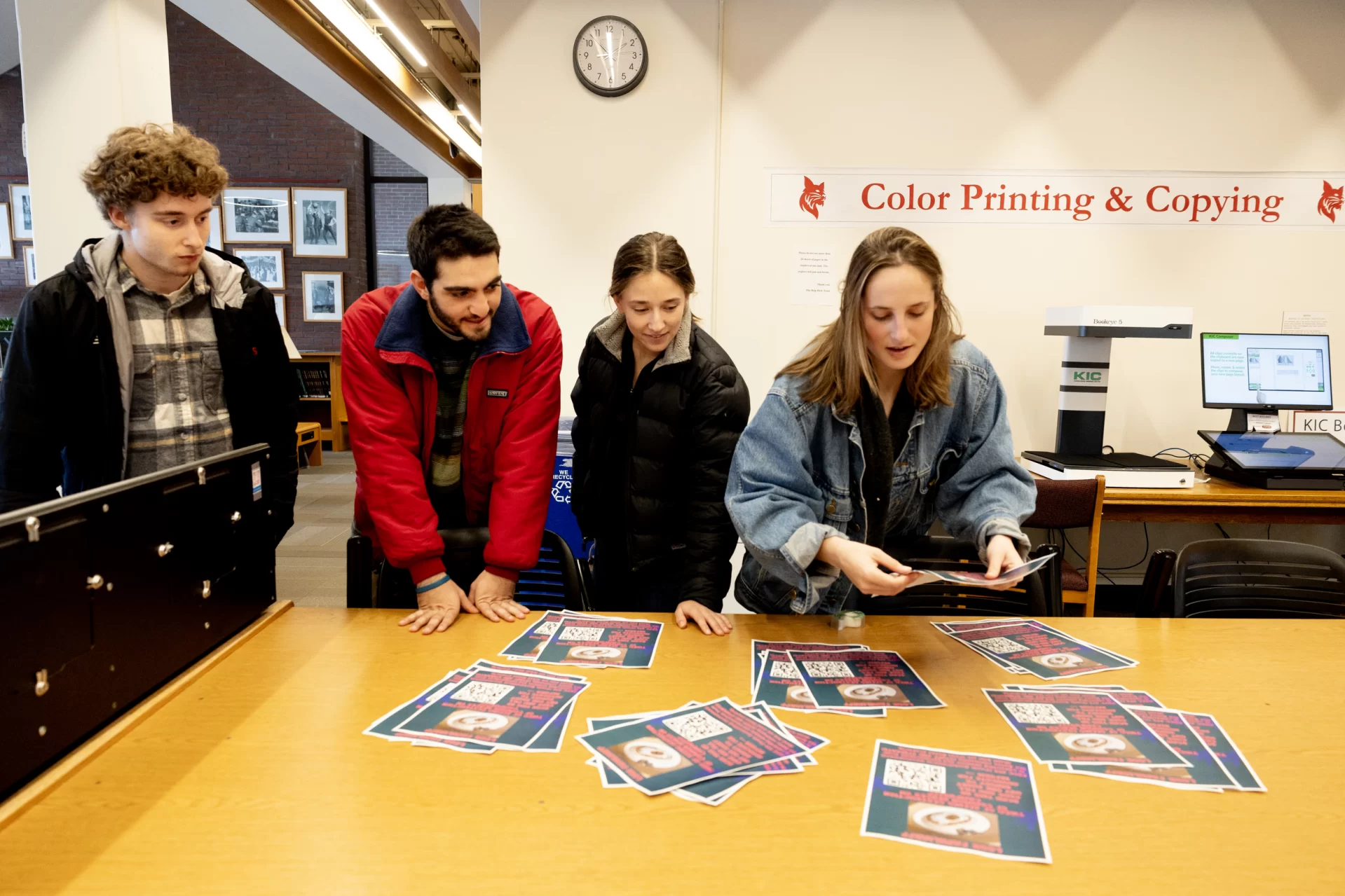
2:11 p.m.
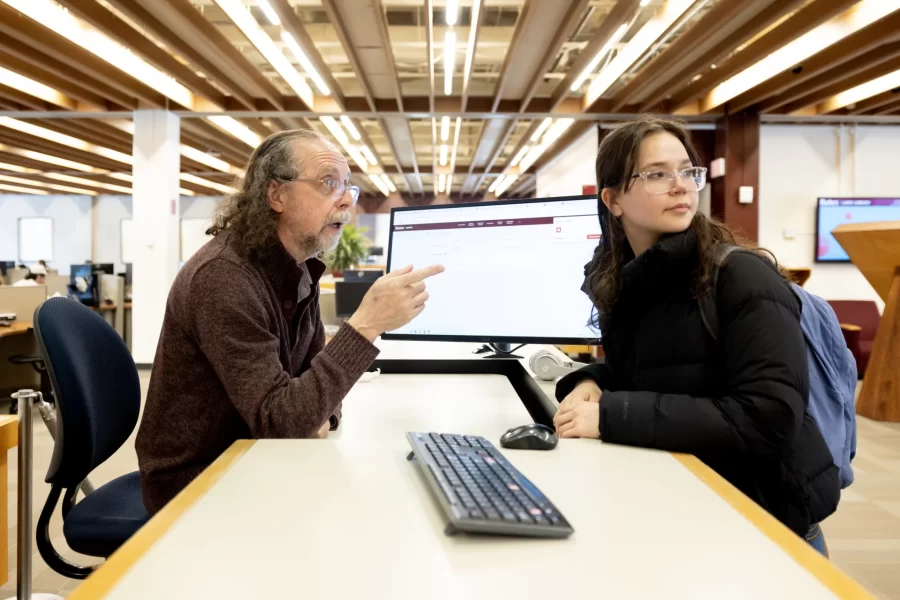
Chris Schiff, Ladd’s music and arts research librarian, points a student in the right direction from the research desk on the first floor. This time of year, when Schiff isn’t out on the floor, he’s in his office a few feet away, advising senior students who are finishing their theses.
2:27 p.m.
On the front end, books come to the library through purchases that are often funded by endowments.
For example, Wendell Wray ’50, who died in 2003, was an influential librarian who directed the New York Public Library’s Schomburg Center for Research in Black Culture.
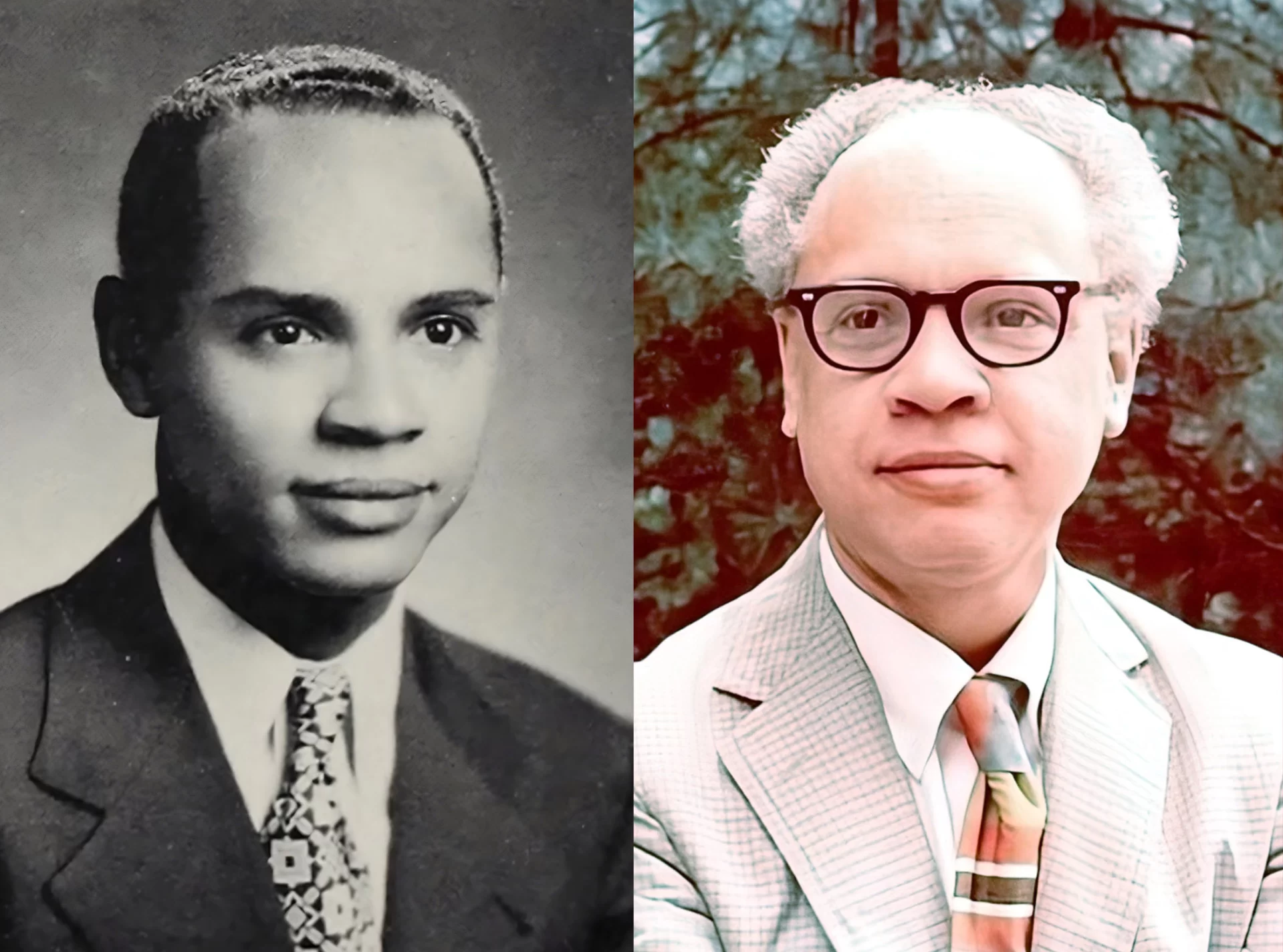
His bequest to Bates created a library fund to purchase books on African American topics. Recent acquisitions have included The Healing Stage by Lisa Biggs, highlighting the transformative power of theater in addressing Black trauma and resilience.
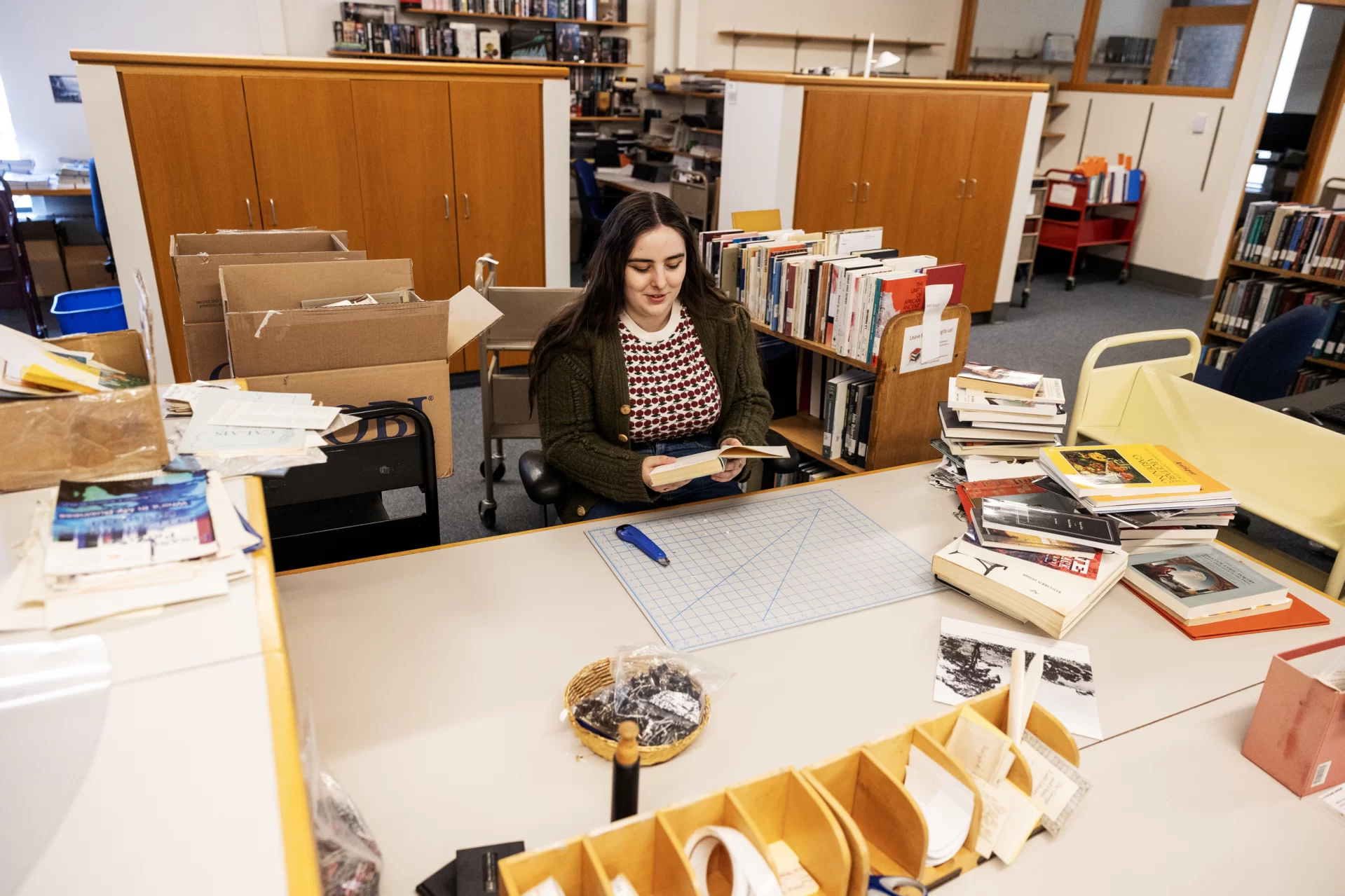
The arrival of new books requires a complementary back-end process. Today, that’s the task for Xanthe Miller ’25, who works in the library’s bibliographic services area, which involves acquisitions, cataloging, processing, and preservation.
She’s sorting through books that will be donated to organizations like Better World Books, which raises funds for non-profit literacy organizations, or recycled.
It’s a dream job for this economics and music double major from Short Hills, N.J. A book lover and avid collage artist, she sets aside books that catch her eye, either for reading or collaging. Back in her room in the Village, Miller has dedicated an entire wall devoted to collages she’s made from old books.
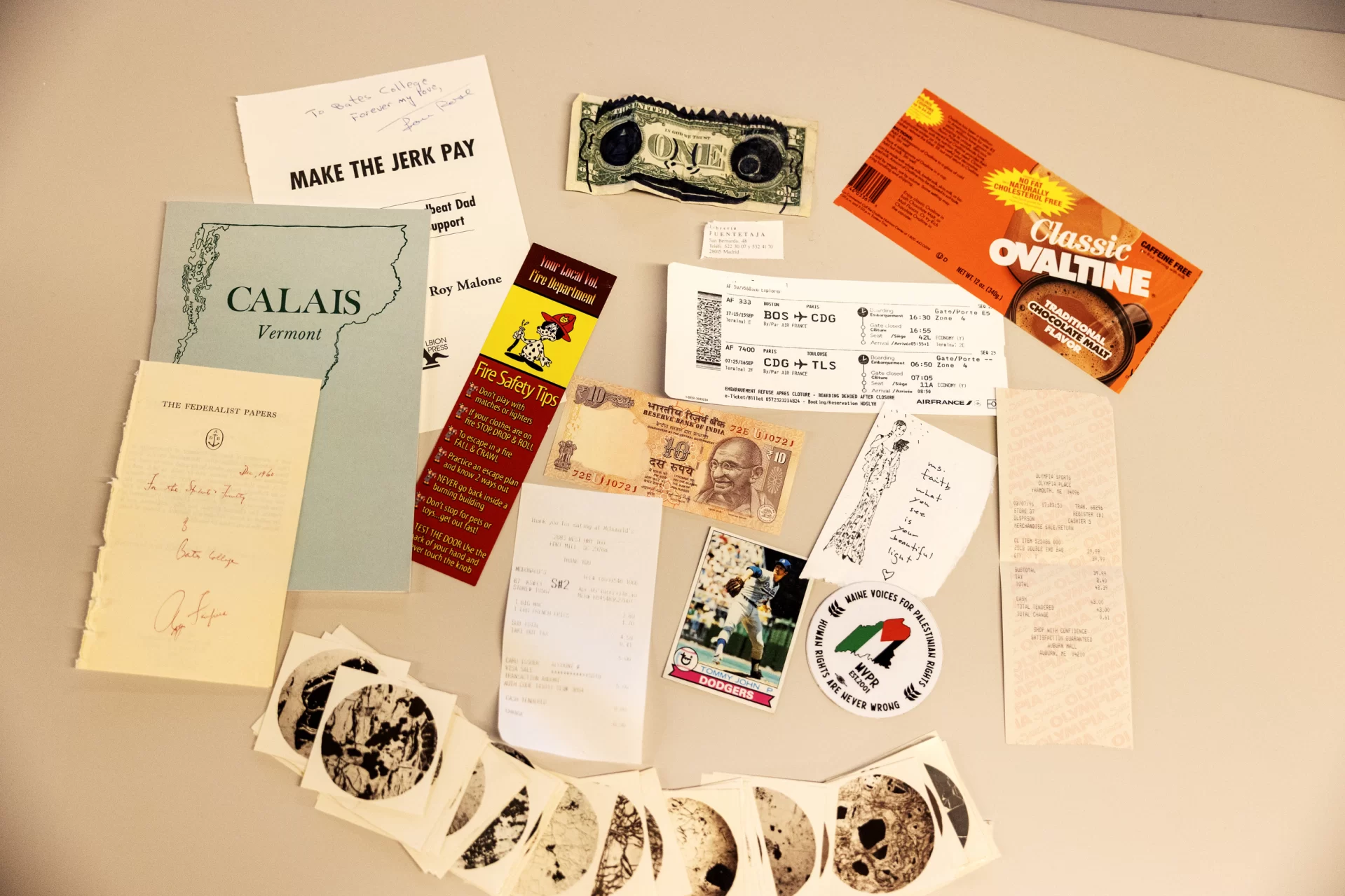
Within the books, Miller finds fascinating ephemera: bookmarks and scraps made into such. There was a pristinely filled-out but unsent Ovaltine customer quality survey promising $4.50 of coupons to participants; a 10 rupee from India, from the Mahatma Gandhi series, and a Tommy John baseball card.
After a shift spent sorting through literature, Miller often finds herself covered in small bits of paper. They float away as she speaks with her hands, like magical specks of literary fairy dust.
“The books leave their traces on me in a very real way,” Miller says. “I turn the books into art, and they turn me into some sort of whimsical being.”
3:56 p.m.
Outside, an Admission tour winds its way past the library. Inside Ladd, just above the visitors, Chloé Santucci ’25 of Falmouth, Maine, Josh Collins ’25 of Bodega Bay, Calif., and Madison Pavao ’26 of Franklin, Mass., have convened on the first floor.
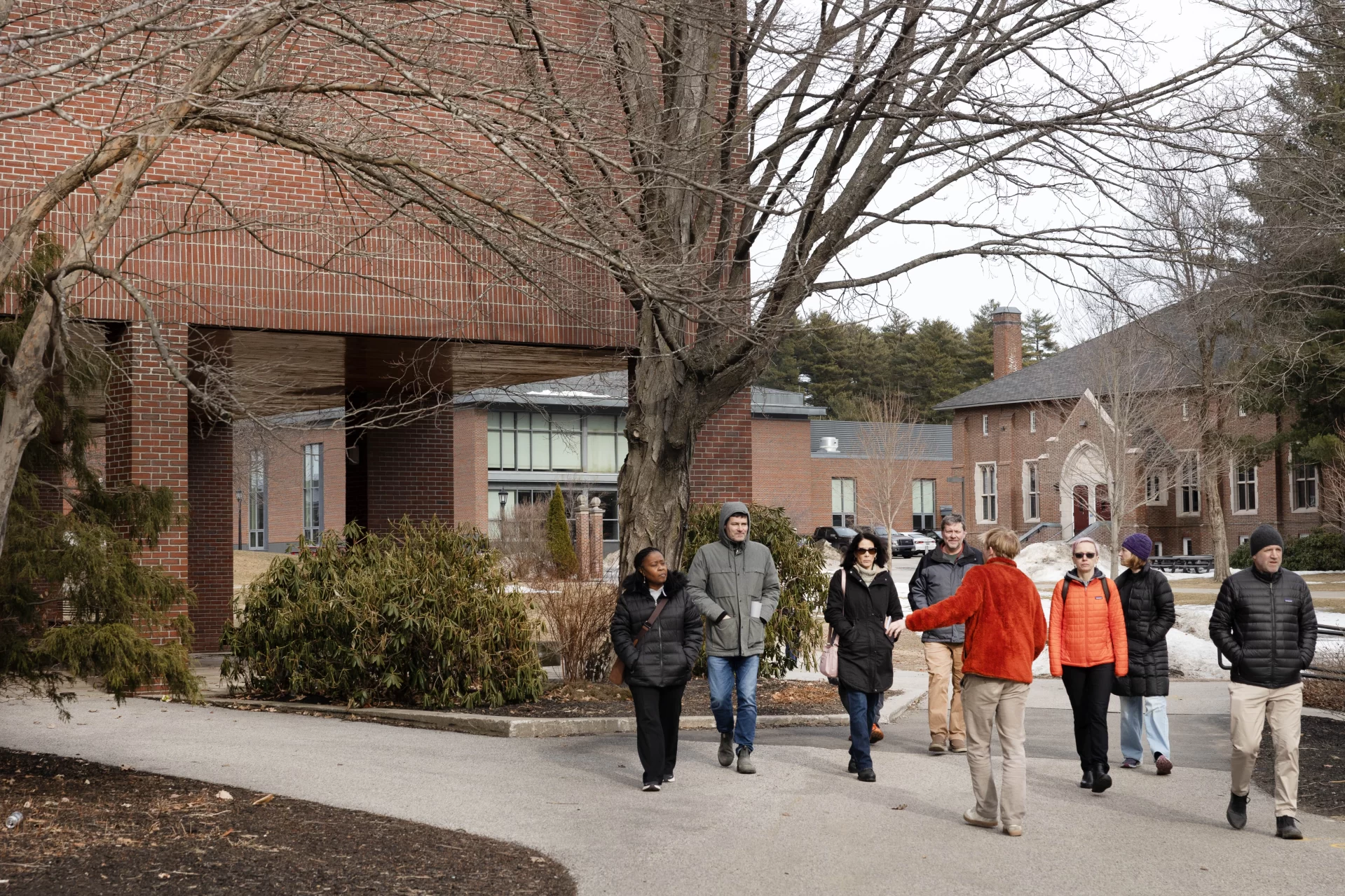
They’re gathered at a table in the back corner of the first floor to work on a group project for their cellular biochemistry course with Visiting Assistant Professor of Biology Daniel Slane.
Since their work is collaborative, the students have selected a study area where they can chat, specifically at Ladd rather than in dorm study spaces. Surrounded by other studious Batesies and just steps away from countless academic resources, the students focus best in the library.
“It’s nice because sometimes I will get confused or not know how to do an assignment or I need help, and there’s a lot of resources,” Santucci says.
4:02 p.m.
Ethan Vulcain-Sowkey ‘28 of Flushing, N.Y., walks to Ladd Library with Yuki Yasuda, a Learning Associated in Japanese.
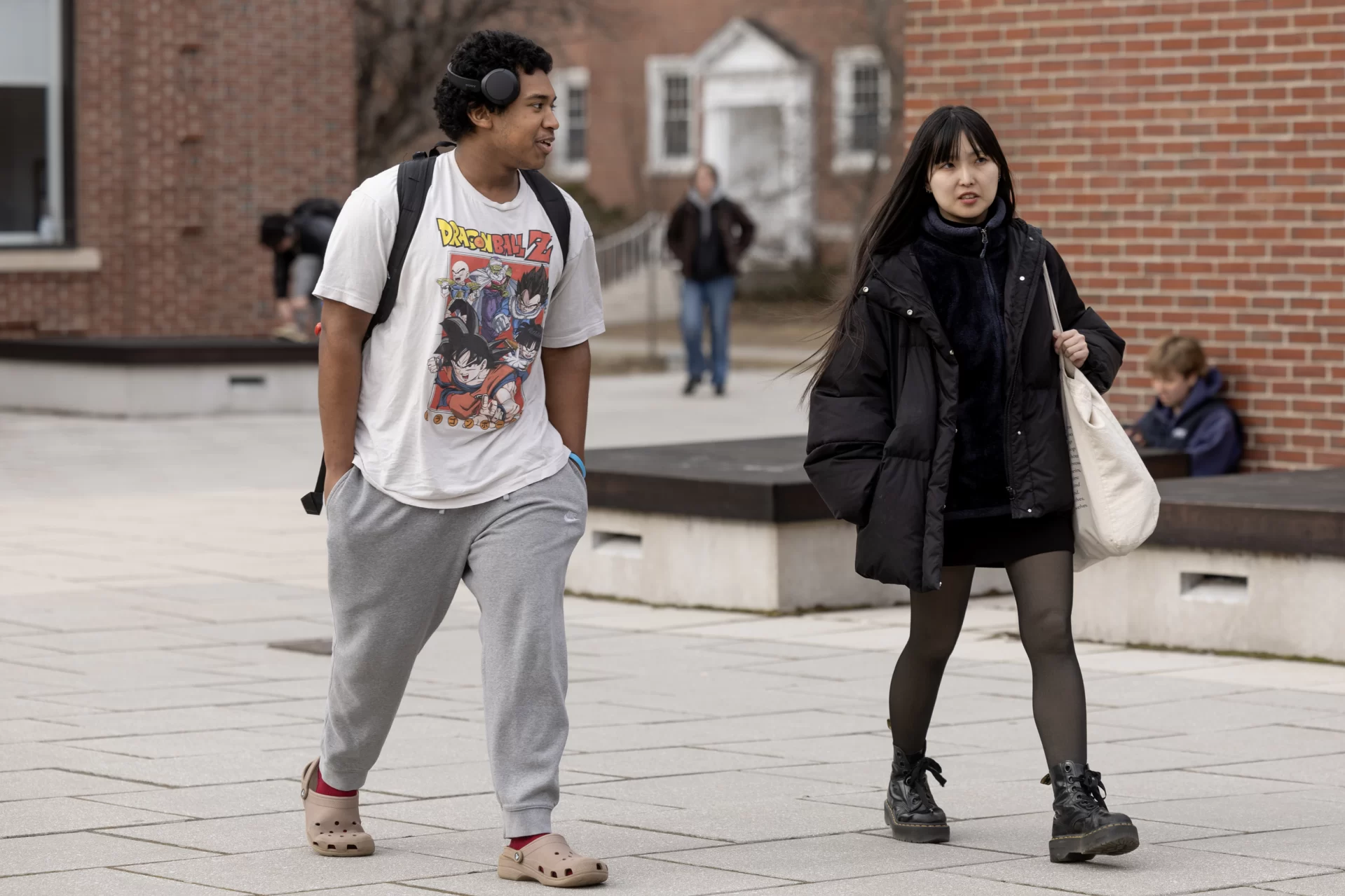
Inside the library, Nicole Rossilli ’27 of Staten Island, N.Y., wanders over to Ladd’s printing stations, clad in a Bates EMS T-shirt. A trained emergency medical technician, she’s on call today and brings along the radio that will alert her of any emergency situations needing attention.
“The library is a good central location on campus, so if we get a call and we need to get there, it’s going to be less time,” Rossilli says.
Two to three Bates EMS student volunteers are on call 24/7 during the academic year. Between calls, student volunteers go about their normal on-campus activities, such as printing a reading on technology and illness for a course with Professor of Anthropology Jennifer Hamilton.
4:14 p.m.
During thesis season, Chris Schiff can often be found in his office on the first floor of Ladd, advising senior students as they complete the largest projects of their academic careers thus far.
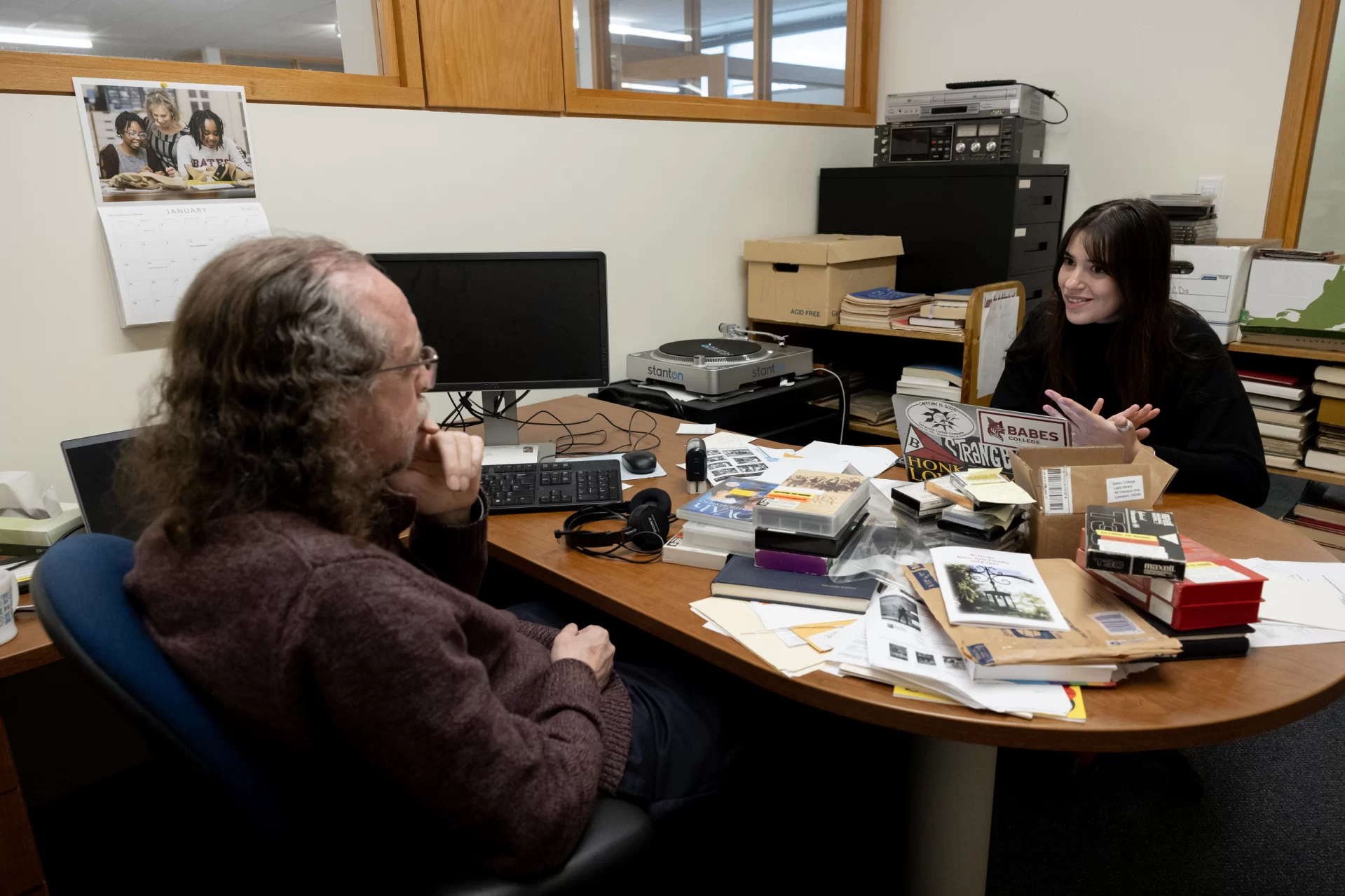
Today, Schiff and Lauren Georgeou ’25 of New York, N.Y., are discussing Georgeou’s senior thesis on the television show Antiques Roadshow and the valuation of objects on the show. Schiff’s office, packed with piles of antique sheet music and collected CDs, is well-suited for an academic discussion on antiquing.
Schiff and Georgeou are working on “big picture” themes of Georgeou’s thesis, tackling questions about distinguishing one’s scholarly lens from personal opinion and the purpose of asking why certain knowledge matters.
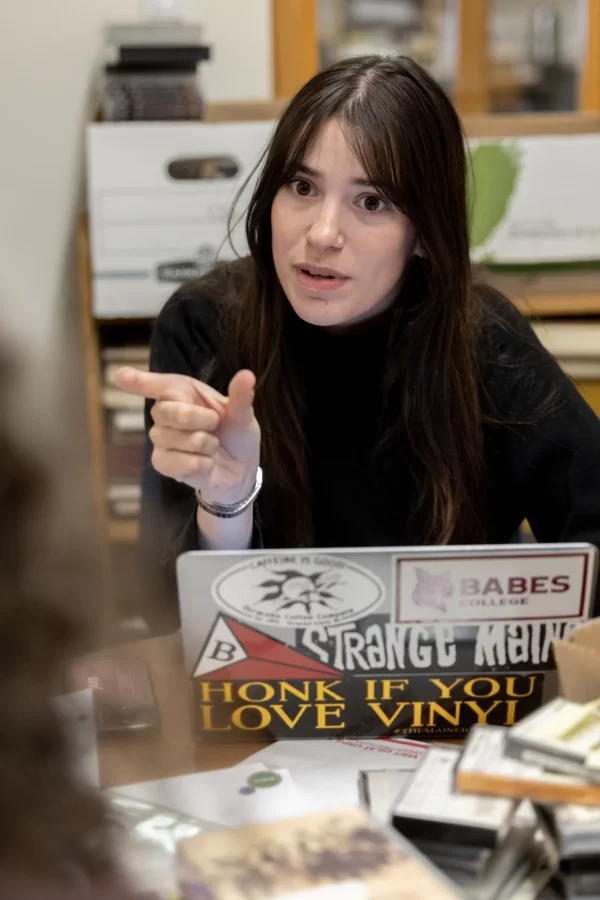
“If you can try to answer that question of why is this knowledge valuable, you really contributed to scholarly discourse,” Schiff tells Georgeou.
4:51 p.m.
The higher you go in Ladd, the quieter it becomes, which suits D.J. Mason ’28 of Naperville, Ill., just fine. Mason says he is easily distractible, so he’s intentional about finding study spots at Bates, “away from social traffic and talking, where I can zone in on my work.” Today, that’s the very quiet third floor.
He’s doing some reading for the course “Black Poetry,” taught by Dana Professor of English Therí Pickens, including 1919, a book of poetry by Eve L. Ewing about the Chicago race riots of that year, during the so-called Red Summer of violence the U.S. “She explains how it was during Black migration: geographic, social, and economic, from the South to the North,” says Mason.
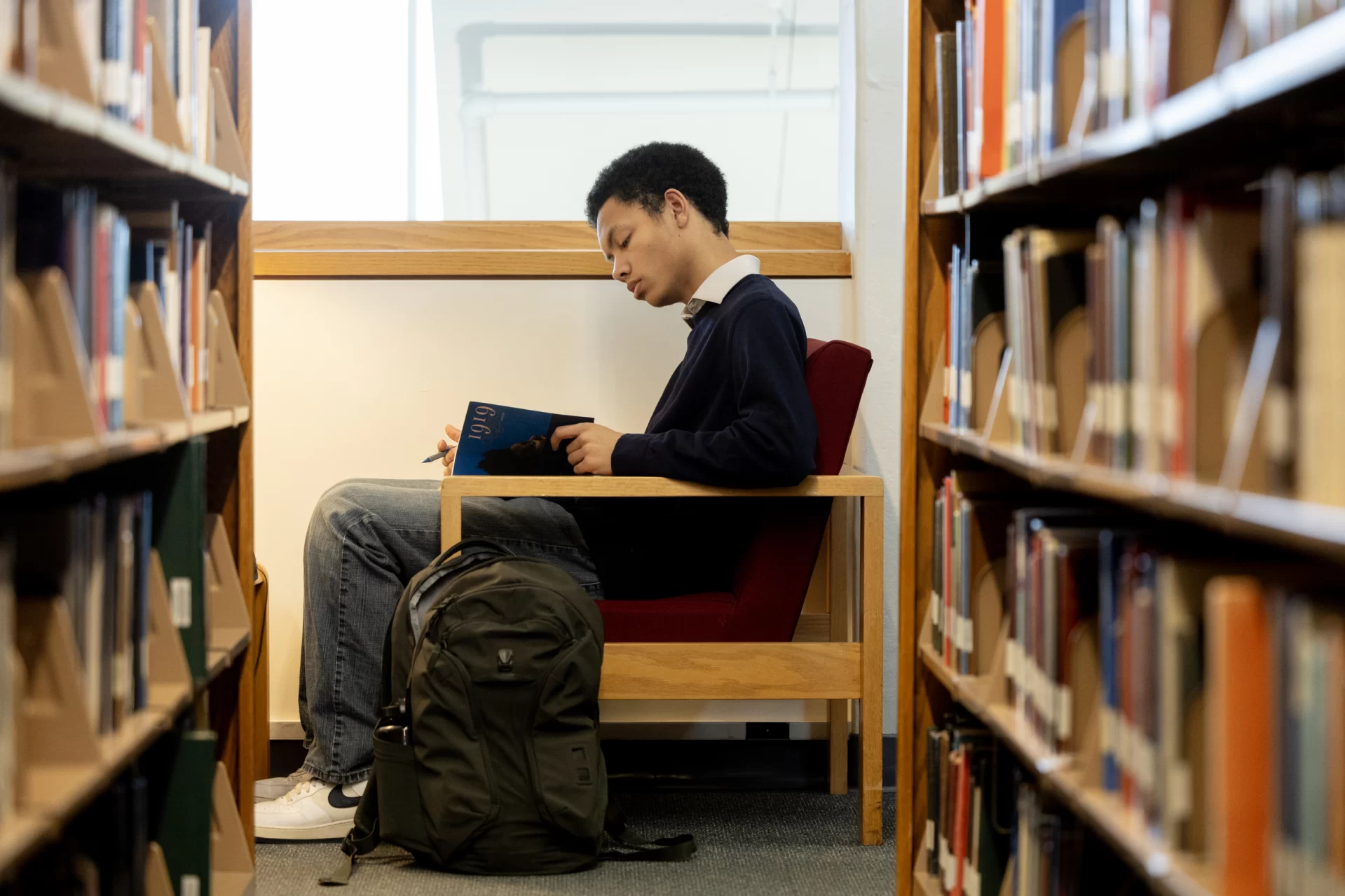
The second and third floors are dominated by the stacks, which refers to how books are “stacked” on shelving units. “Sometimes I’ll poke around and see what they’re about,” he says.
“There’s this history attached to them,” he says, plus what he calls an “antique functionality.” Meaning, they’re still useful, but Mason can’t help but feel that change. “Books, in my mind, make me think of sitting down and doing serious work. Maybe in coming generations, that might change. They might not have that secondary, social cue” — the signal that a book in hand suggests intellectual effort and concentration.
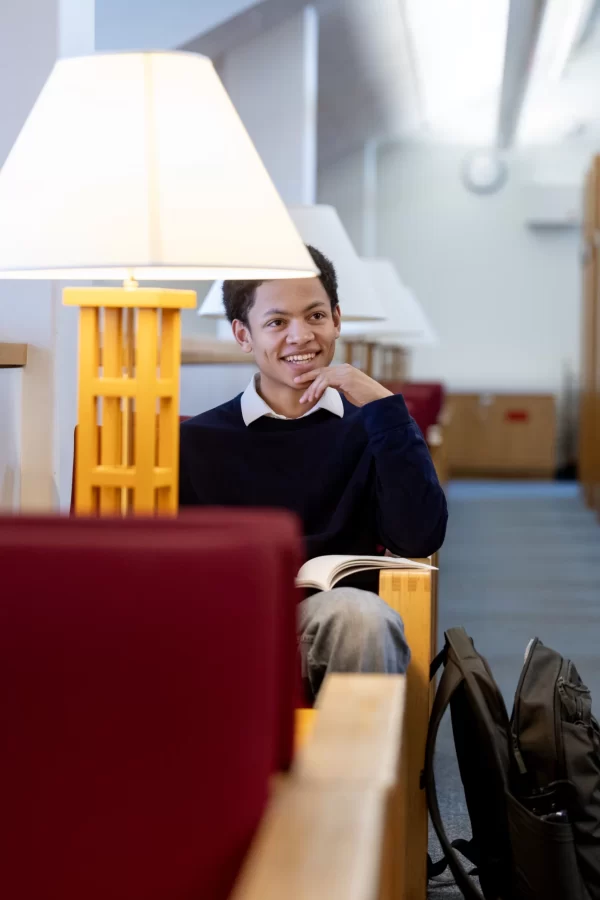
When asked where he studies in Ladd, Pascal Wettermark ’27 of Truckee, Calif., replied, “Upstairs. The blue chairs.” It’s an answer that alumni of the last half-century will get, as it’s hard to forget the vivid blue upholstery that some Ladd chairs had, and still have (a shade of lapis blue that, it’s said, was favored by Cleopatra)
The blue chairs were made by the Monarch furniture company, a bygone manufacturer located in High Point, N.C., which once had dozens of furniture factories.
Ladd Library glows in the early evening, its distinctive four-story facade designed to harmonize with expansive Alumni Gymnasium across from the library. Meanwhile, the smaller scale of the entrance, on the other side of the building, remains in scale with Coram Library.
The building’s upward graduation — from reading areas to stacks to meeting rooms — preserve the visual rhythm of the surrounding campus.
7:18 p.m.
Yoko Franklin ’25 (right) of Princeton, N.J., helps Eli Criss ’25 of Winchester, Mass., at the circulation desk. Inside of Ladd, opportunities abound for students to learn from one another, whether it be through checking out a book, seeking out IT support, or sitting down for a tutoring session.
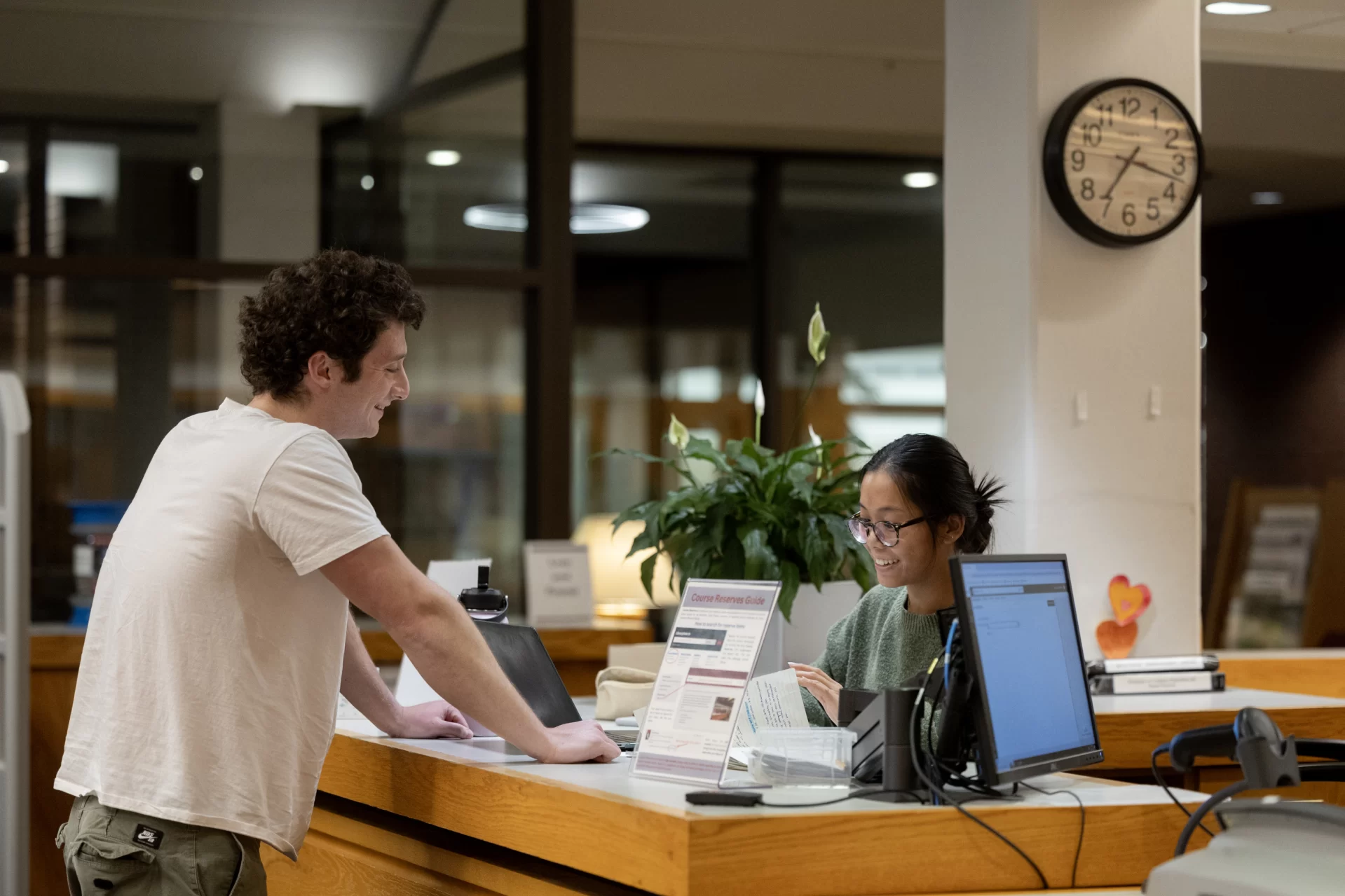
7:21 p.m.
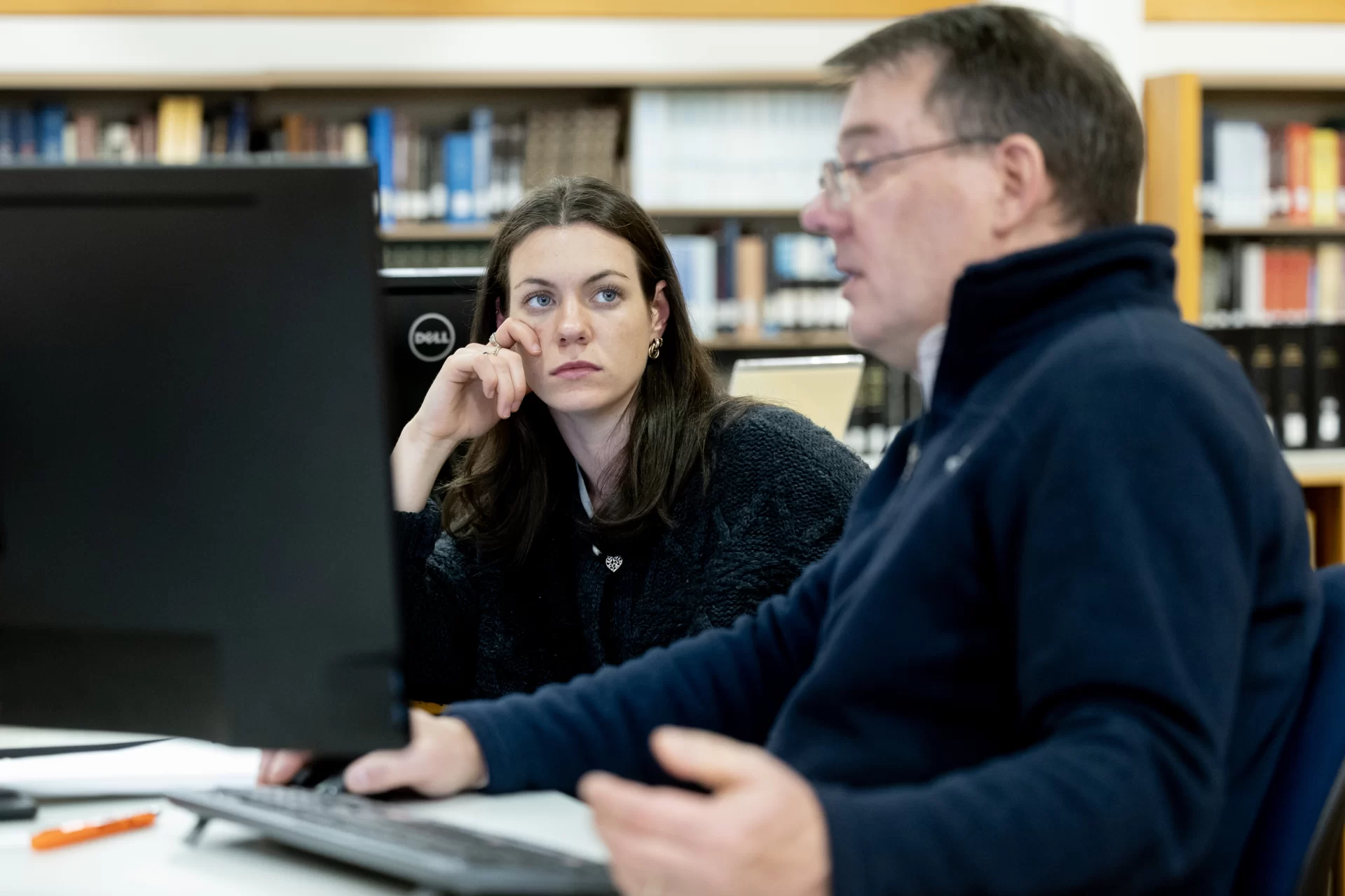
Caroline Hughes ’25 of Fairfax, Va., a biology major, works on her senior thesis at the research desk with help from Peter Schlax, Ladd’s science and data librarian. During the winter semester, Schlax’s calendar is full of research appointments with graduating students, each chugging away at their detailed thesis projects.
7:24 p.m.
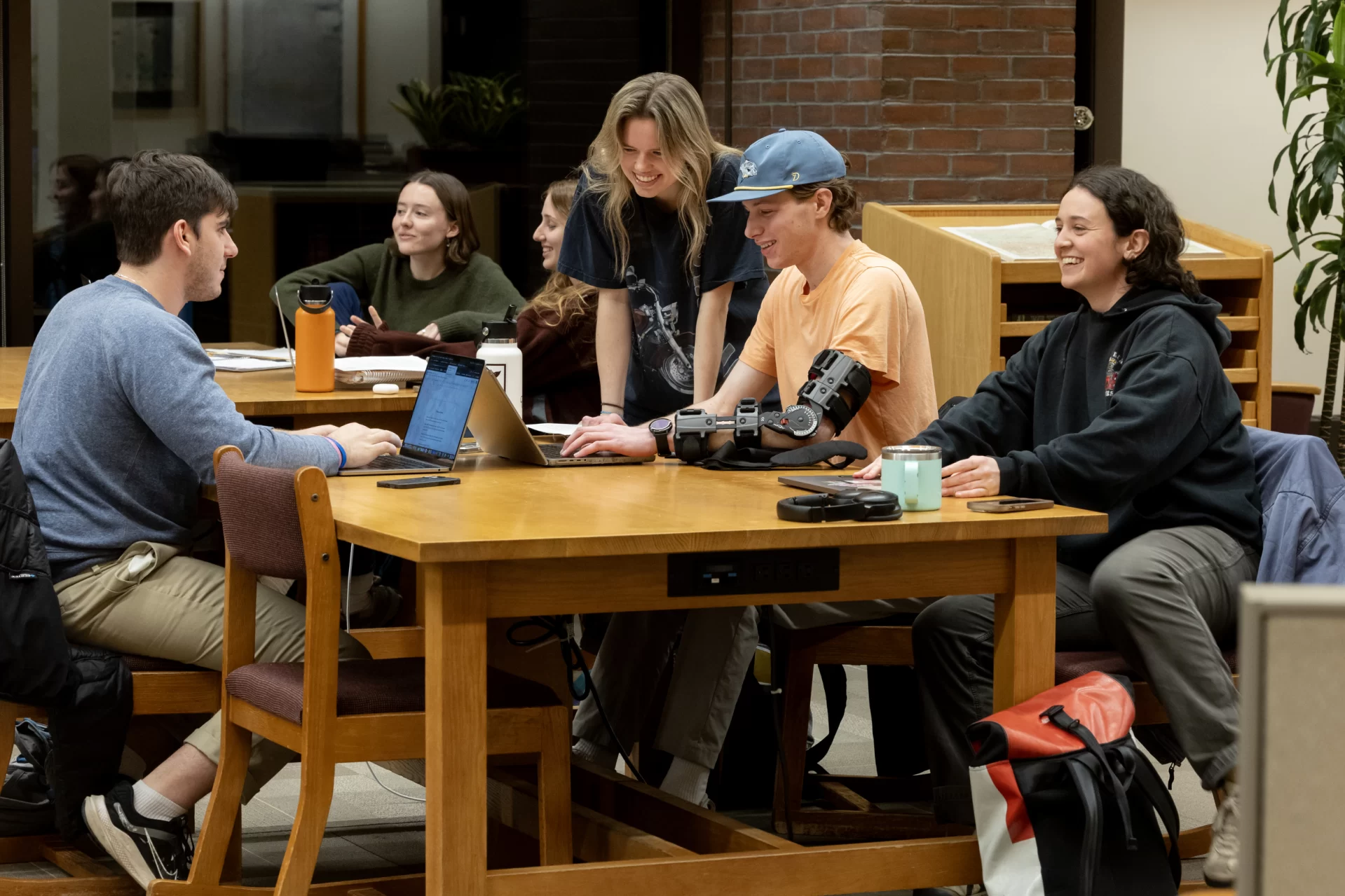
From left, seniors Adam Joseph, Grace Flaherty, Aidan Wood, and Maura Ferrigno gather for an evening study session of equal parts laughter and study on Ladd’s first floor.
7:45 p.m.
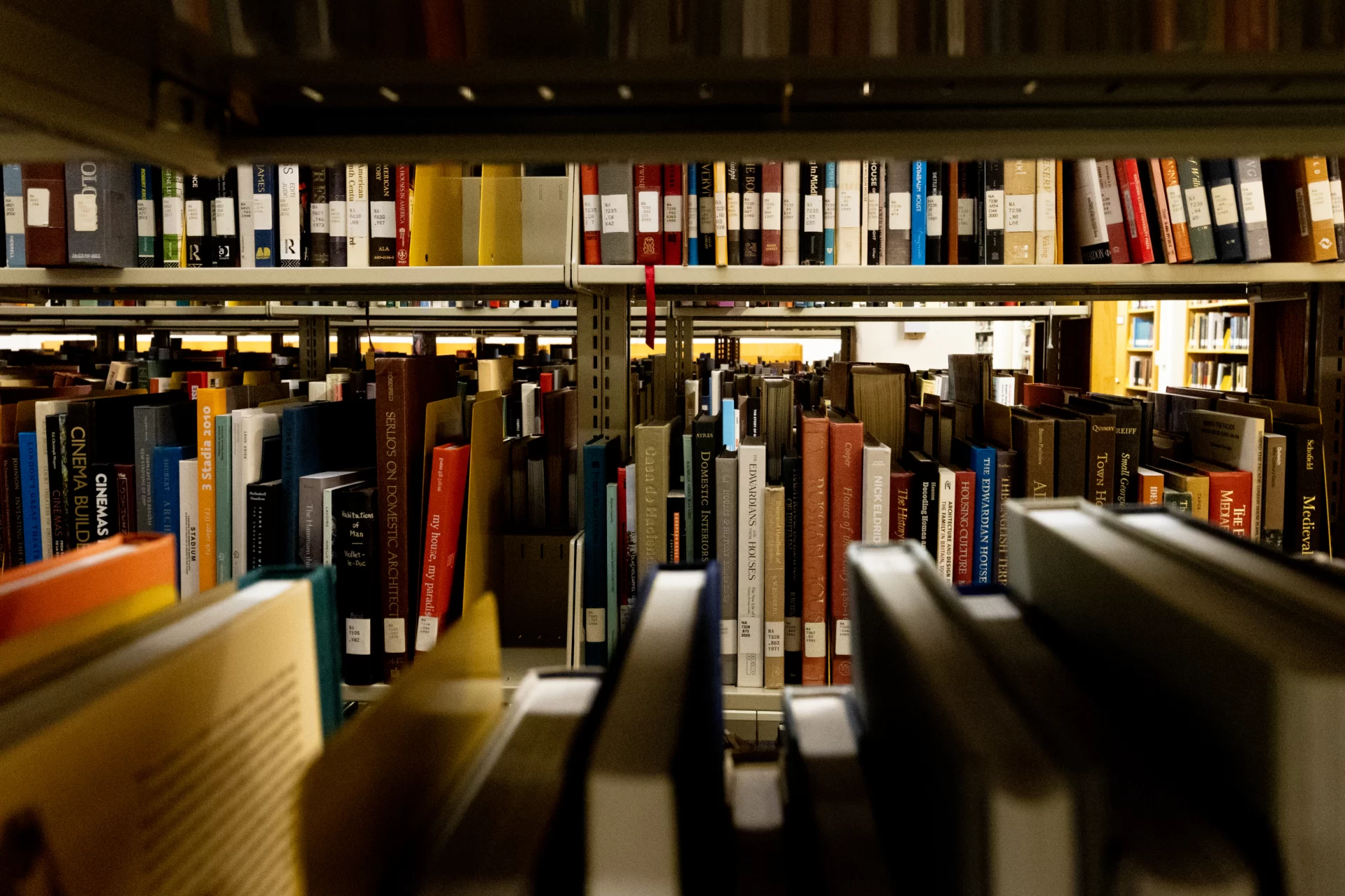
After the sun has gone down, the stacks on Ladd’s upper floors are quiet, awaiting students on the hunt for last-minute research materials.
7:51 p.m.
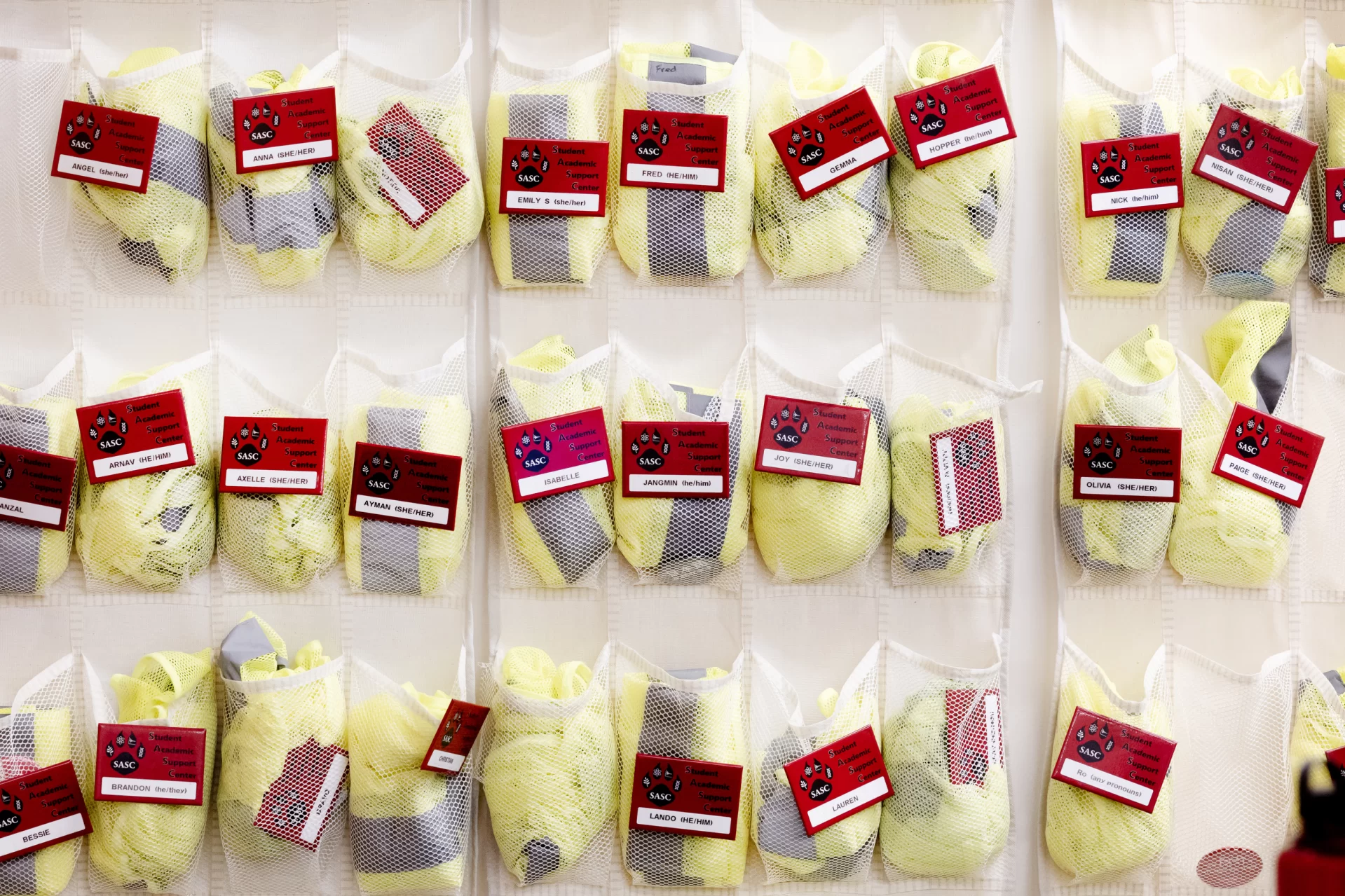
To help students navigate the Peer Learning Commons, student tutors wear colored safety vests. Neon yellow/green vests — seen here stored in a wall organizer, ready for use — indicate tutors who provide support in STEM fields and quantitative social sciences. Tutors who work with students on writing wear blue vests .
7:53 p.m.
Axelle Tougouma ’27 of Fada N’gourma, Burkina Faso, dons a yellow vest as she begins her work as a peer tutor supporting students in math courses.
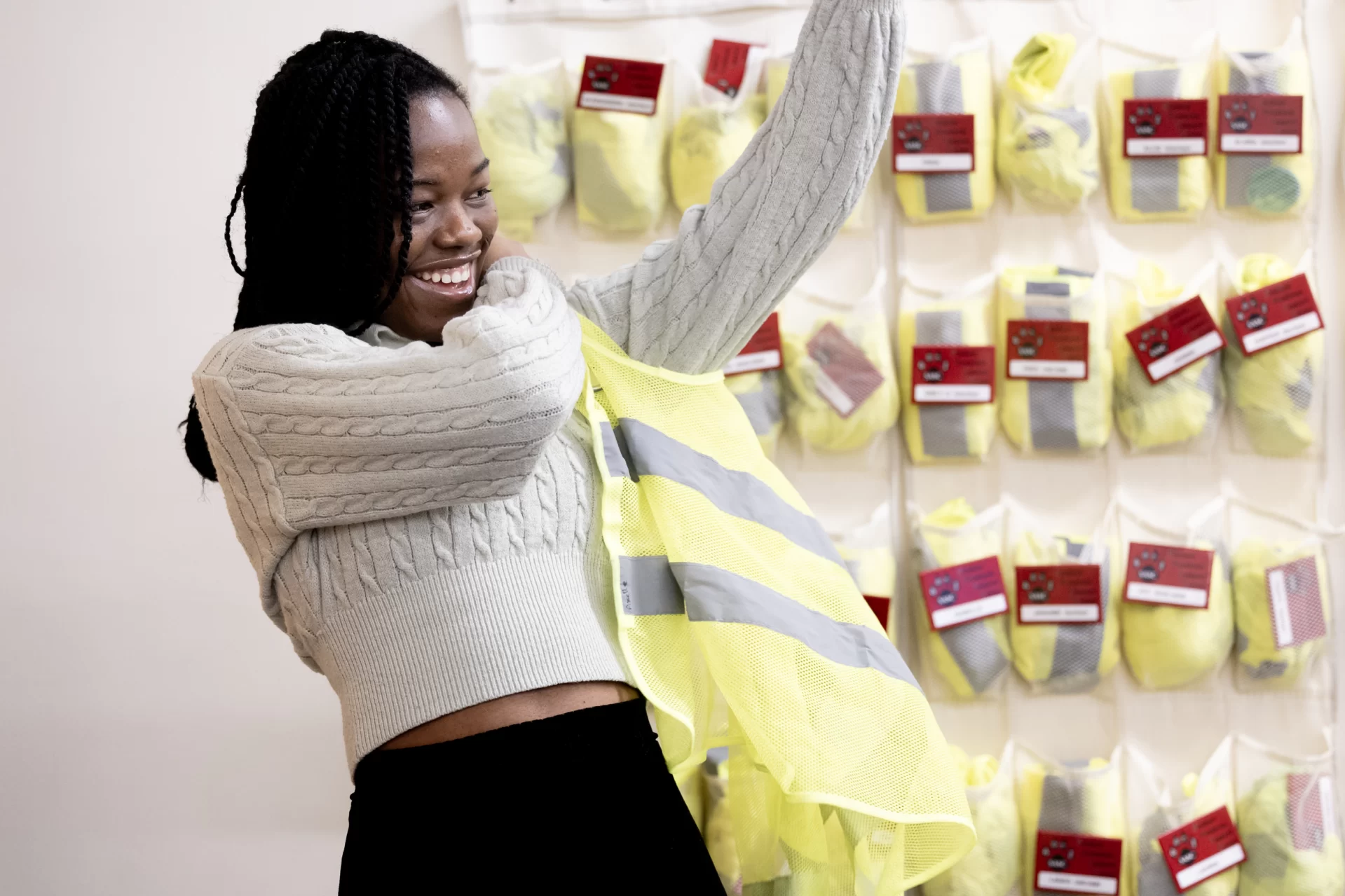
In the evening, the Peer Learning Commons space is loud — in a productive way — with many students coming straight from dinner in groups to go over a few calculus problems they’ve been having trouble with, or to get a writing tutor to look over their latest essay before they turn it in.
Putting on a blue vest that marks her as a writing tutor is Tammy Namangale ’27 of Manhattan, N.Y., and Lilongwe, Malawi. “I love the energy in here,” she says, “Sometimes they come in for a class we’ve taken before, and they just need to vent about something, and I’m like, ‘I get it, you know, and I can help.’ I like being that person.”
“The training is way cooler than it seems. When I was training to be a writing tutor, our final project, we ran workshops for 100 middle school kids, and I got the virtual reality rooms. Lots of fun.”
7:54 p.m.
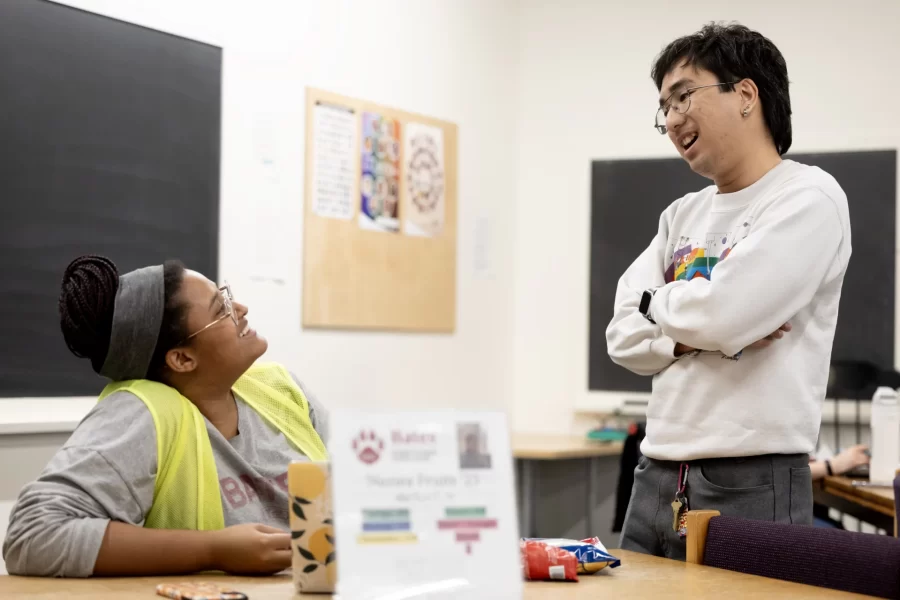
Naziea Fruits ’25 (left) of Cleveland, Ohio, a neuroscience major who supports biology, organic chemistry, and neuroscience courses, talking to Joaquin Torres ’25 of Silang, Philippines. A theater and neuroscience double major, Torres supports DCS classes as well as student writers all across the curriculum.
9:04 p.m.
Molly Allison ’26 (left) of San Juan Capo, Calif., and fellow writing tutor Charlotte Gisborne ’25 of Bishop’s Stortford, England, glance at work on Allison’s computer.

9:09 p.m.
Peer tutor Peter Weil ’25 (left) of Cooperstown, N.Y., works with Talia Winters ’28 of Saratoga Springs, N.Y., helping her out with calculus course.
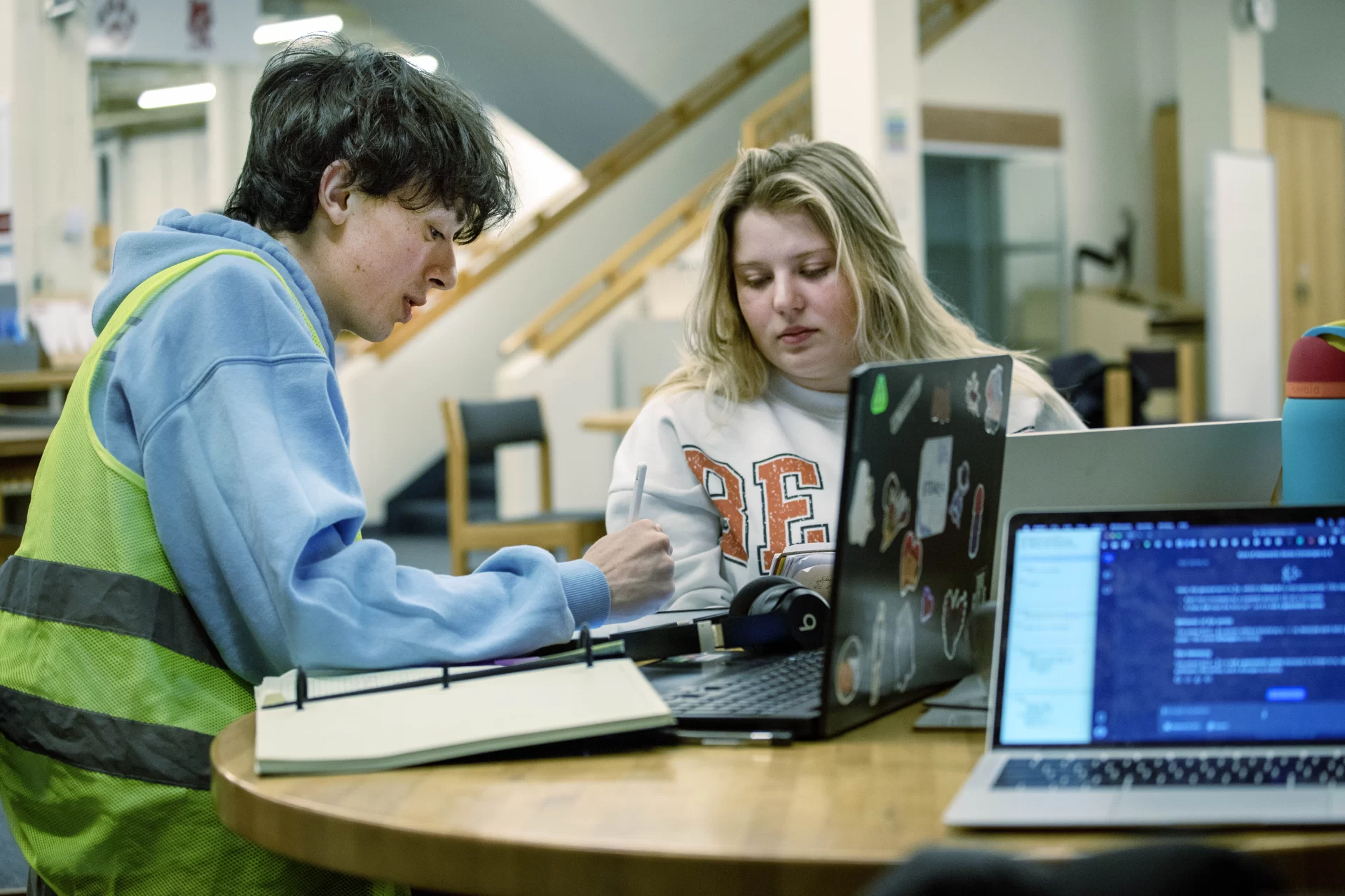
10:04 p.m.
In addition to students seeking help, the Peer Learning Commons attracts students helping each other.
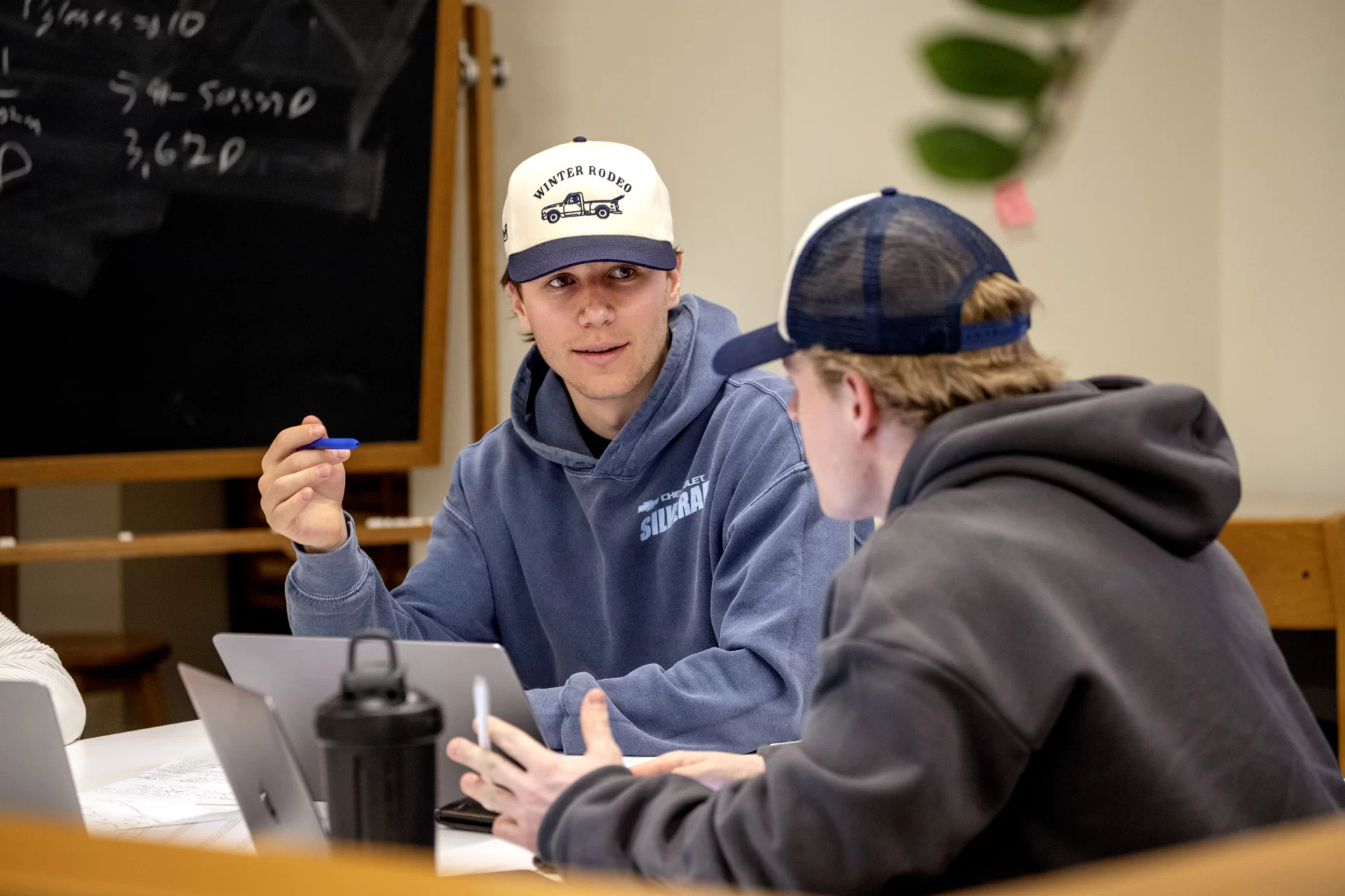
On this night, Dylan Thomas ’25 (left) of Truckee, Calif., and Wyatt Hoffman ’25 (right) of Lyme, Conn., headed to Peer Learning Commons, along with Johannes Schwarz ’25 of Cincinnati, Ohio, to study together for an upcoming exam in their biochemistry class.
Their goal? “Hopefully not to fail,” jokes Hoffman.
12:33 a.m.
Here, top to bottom, are theater majors Jack Hagan ’27 of Cape Elizabeth, Maine, Ruby Marden ’27 of Sidney, Maine, and Aidan Bergeron ’27 of Pelham, Mass. They are watching Hamlet as they outline the play on the whiteboard. The group is the last on the ground floor — and certainly the most enthusiastic for the late hour.
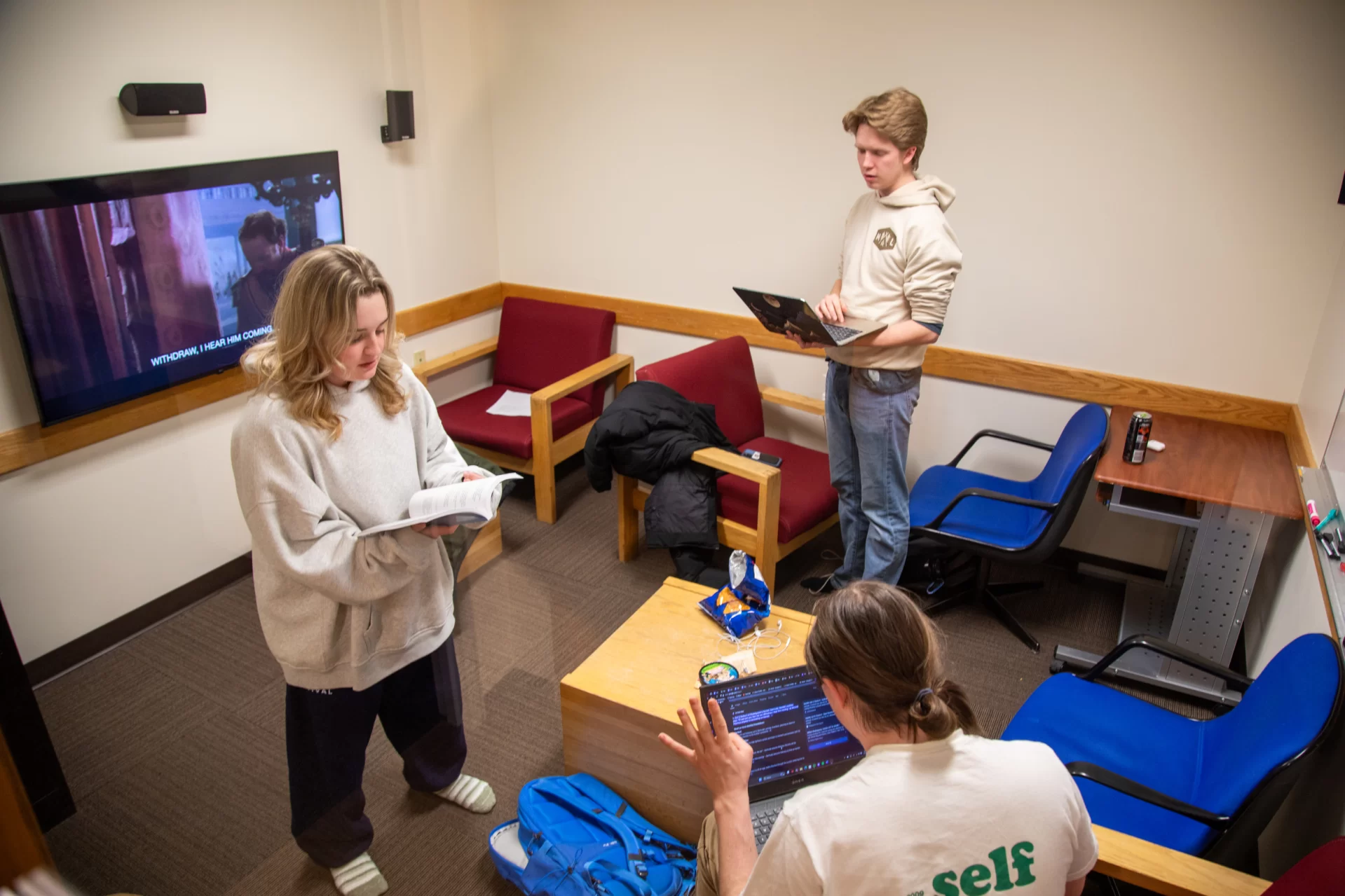
This room and two others in the Peer Learning Commons are equipped as presentation and speaking studios, where students can practice pitches or presentations, whether a thesis defense, job interview, or Mount David Summit poster session. Students using the room also receive peer support in their work.
12:38 a.m.
Mo Al-jabry ’28 of Singapore, a member of the IT Service Desk team, works on assignments as he waits to assist students with late night technical issues.
The library is winding down, preparing to rest for the remainder of the night.
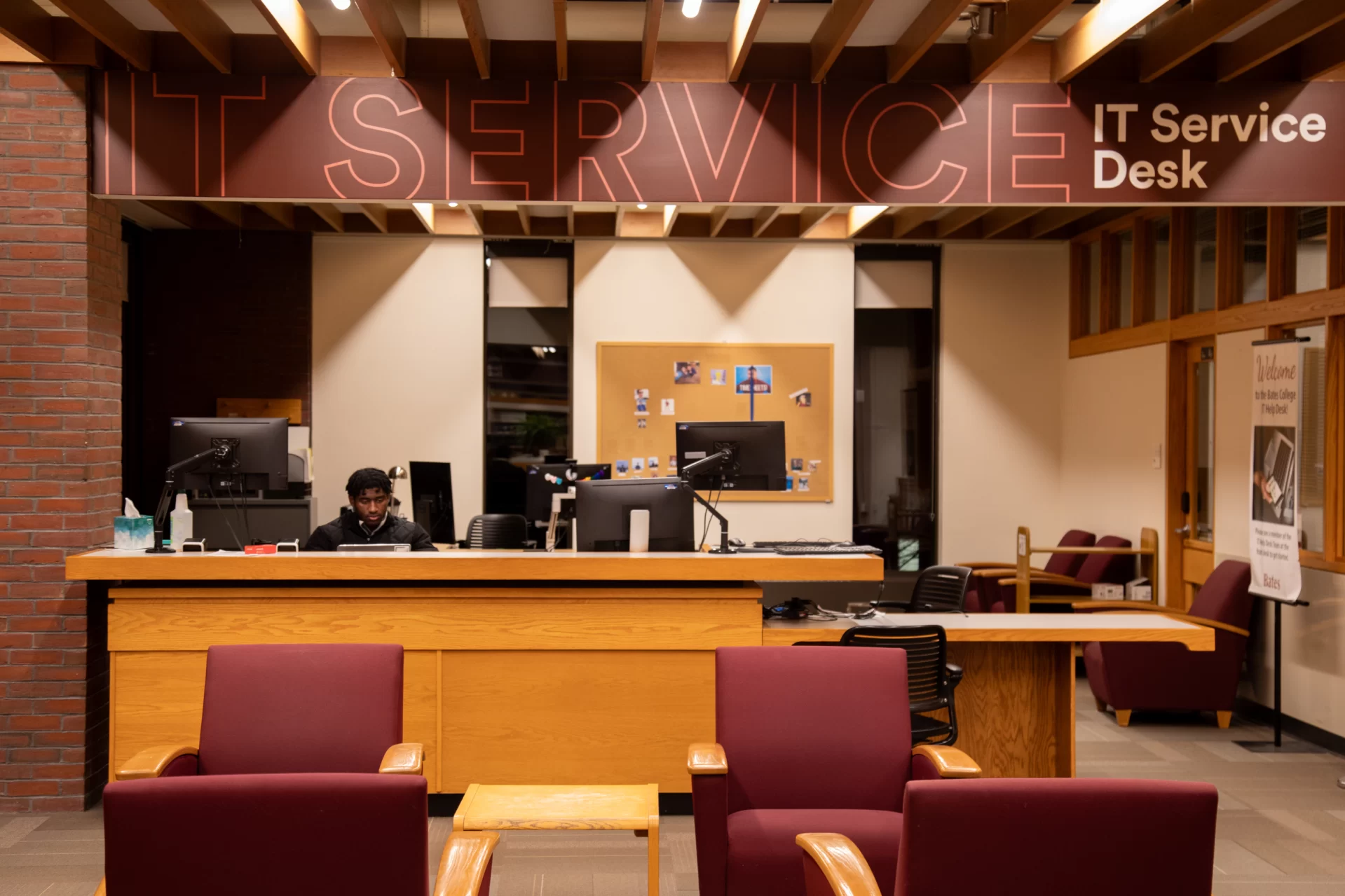
The occasional cough breaks through muffled laughs and unintelligible words exchanged on the basement floor of Ladd. Cellphones hit tables with a distinguished thud in between focused typing. Zippers close opened bags and warm coats.
Earlier, just after midnight, Karla Chichester of access services began her walk through the ground floor, reminding students of the 1 a.m. closing time, getting within eyesight of those wearing headphones to garner their attention before reciting the same reminder.
“This is part of the job that I really enjoy doing. I like seeing who is here,” she says. “We have our regulars, which we love seeing. I asked one of them, ‘Do you get tired of my kicking you out?’ They say no, that it serves as a good reminder — they tend to lose track of time.”
As the lights go off, the stacks take on a new look, she adds. “It’s a more intimate view of the collections.”
12:43 a.m.
In two minutes, half of the overhead lights in the library flicker off, leaving the first floor ominously aglow. The elevator dings on the first floor, indicating its arrival and the departure of a few lingering students.
In the distance is one of the last students at work on this night.
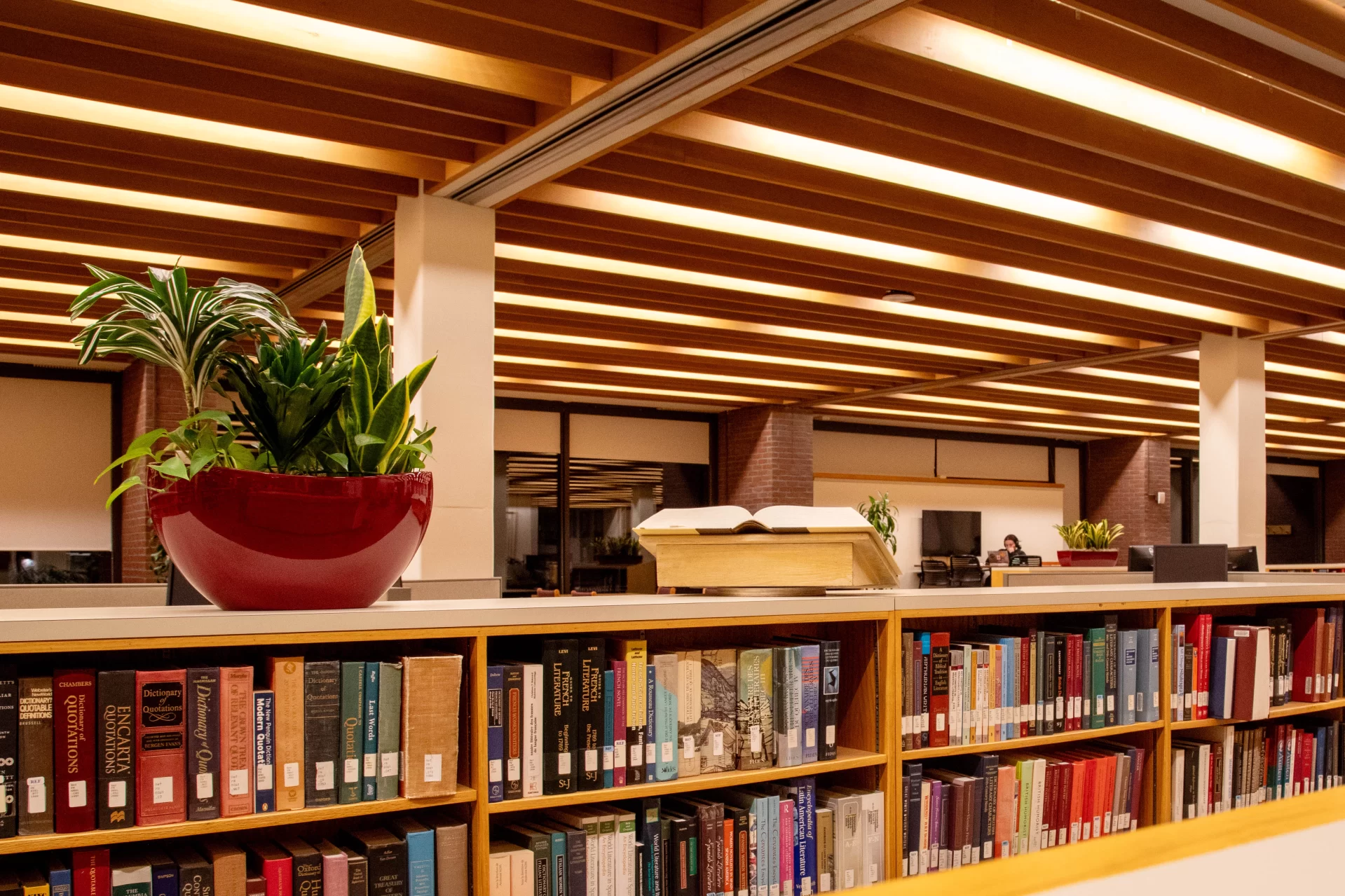
12:52 a.m.
One of the late-night regulars in Ladd Library is Maura Ferrigno ’25 of New Providence, N.J., who explains her late-night Ladd studying ritual to Hannah Kothari ’26, an editorial assistant for Bates Communications and Marketing,
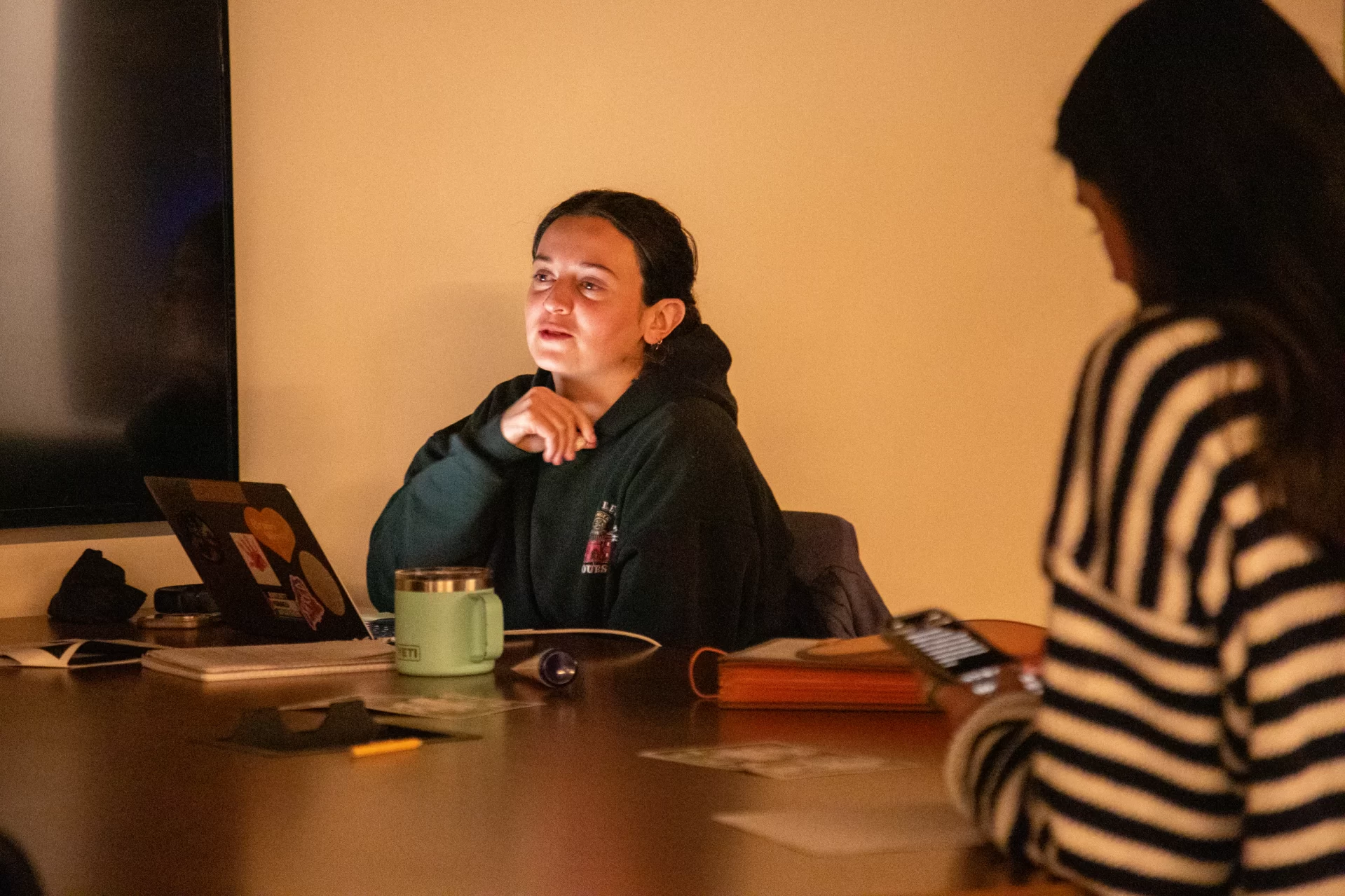
Ferrigno likes to use the 1 a.m. closing time as a reminder to go to bed, and she likes how the ritual of the lights going off signals that it’s time to end her day.
“The library’s closing time is nice because it’s putting you to bed. It’s cozy here. I find it not as sterile as other buildings on campus. I embrace being here for as long as I need to be here.”
12:54 a.m.
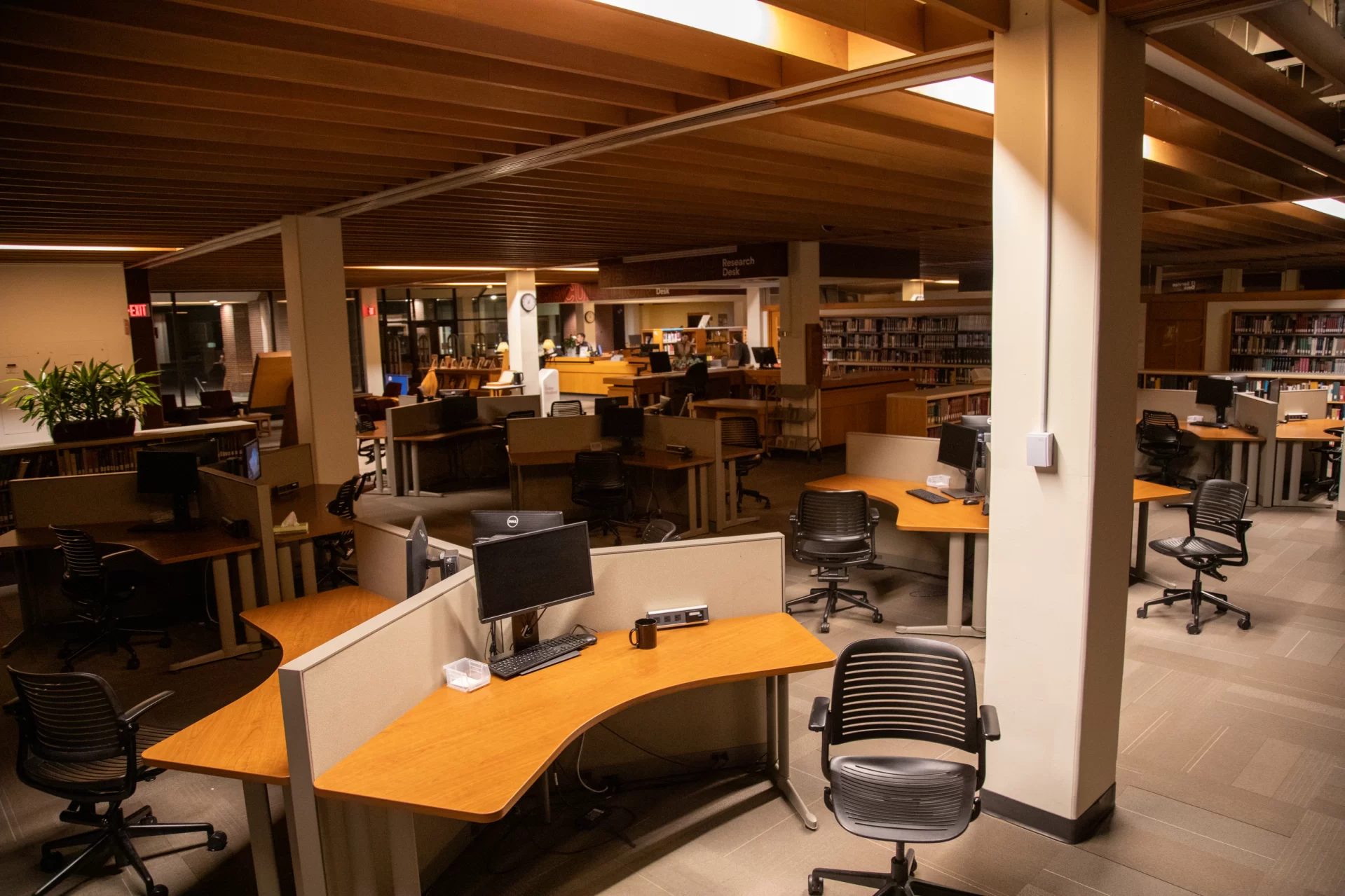
12:58 a.m.
Ferrigno pushes on until 1 a.m., typing away on an annotated bibliography for an art history course.
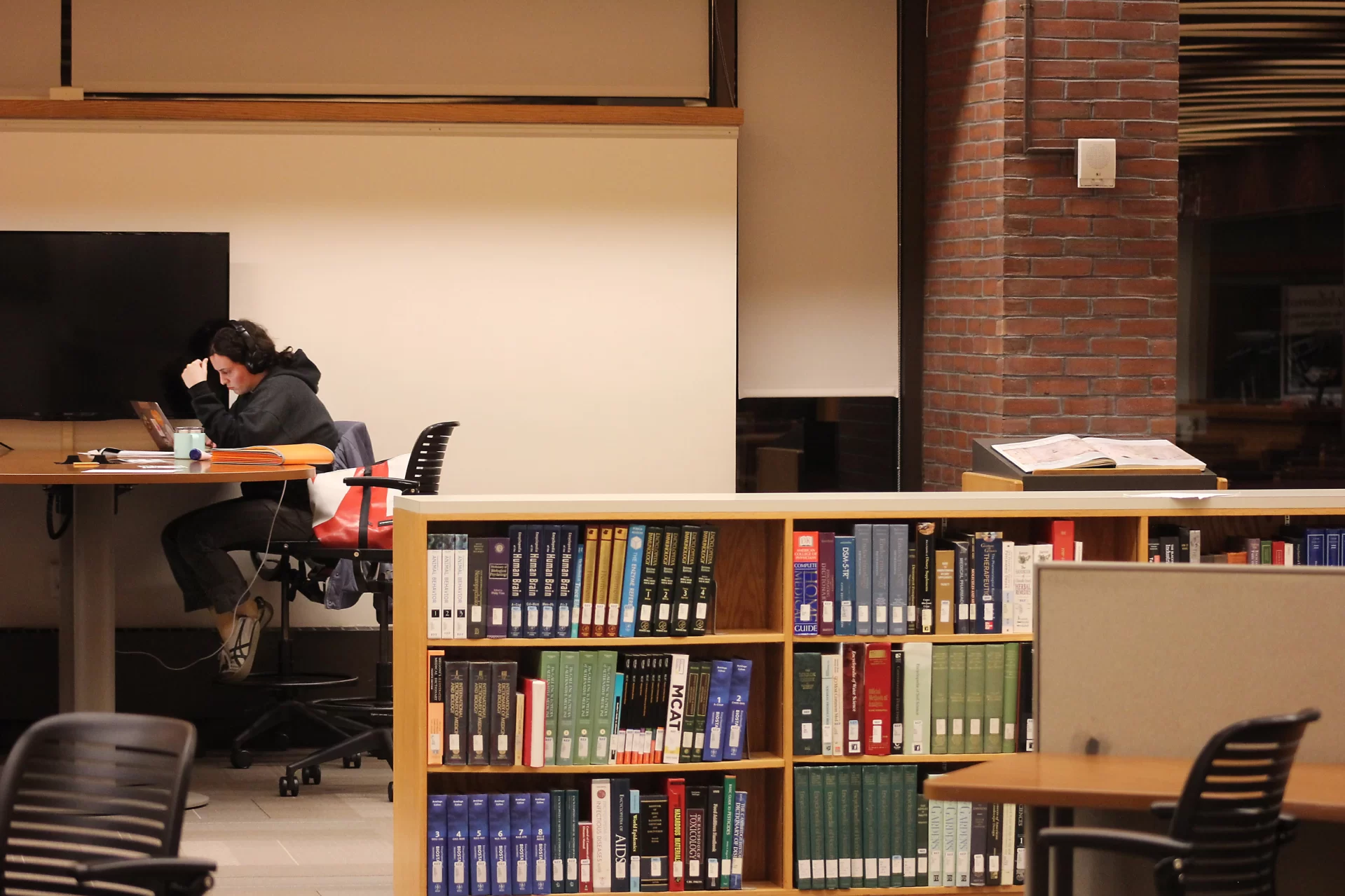
1:04 a.m.
“It was a good day!” Karla Chichester says as she buttons her coat, walking out the two sets of double doors before locking them behind her for the night.
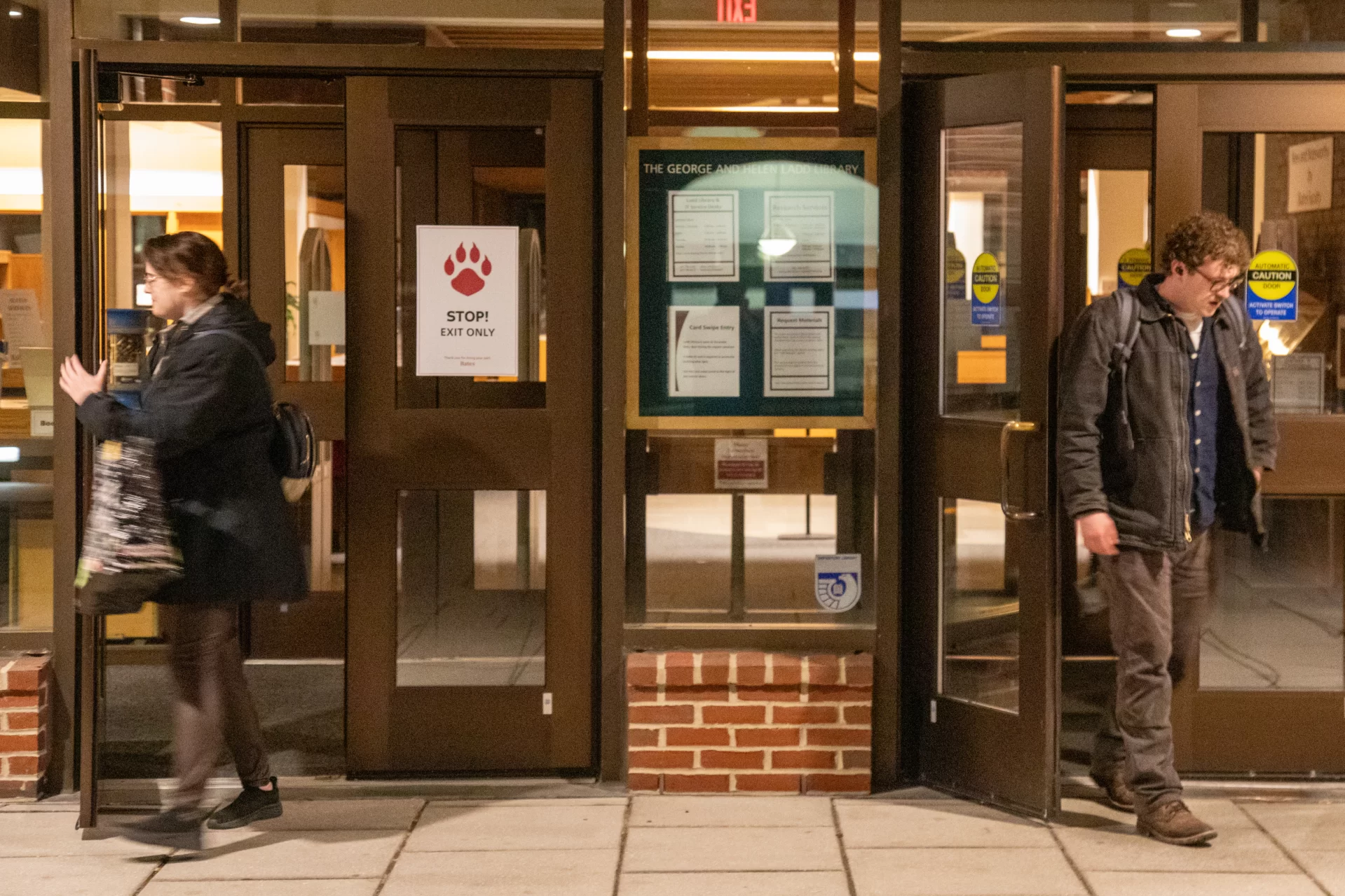
Writing and reporting by Jay Burns, Alexandra DeMarco, Hannah Kothari ’26 and Ramona McNish ’28.
